


























There is a story told about a group of wise men who approached the Rambam and wagered that they could change the nature of a cat. They wanted to train it to be as polite and mannered as a human being and become a butler to its master. The Rambam, though, argued that it was impossible to change the nature of a cat; an animal will always be an animal.
The men spent weeks training the cat. They taught it how to walk on two legs. They dressed it up in a suit. They showed it how to escort people to their seats and serve them drinks on trays.
Finally, the day came to showcase their feline’s talents. They invited the Rambam and the public to observe their accomplishments.
The crowd was impressed. The cat walked around on two legs; he looked cute in his suit. He escorted people to their seats and served them drinks. It seemed as if the animal had really, truly become akin to a human being.
But then the Rambam got up. He took out a small box from his pocket and slowly opened it up. A little mouse jumped out. And the cat, dressed in his suit and with its whiskers twitching, dropped onto all four legs and ran after the mouse. The Rambam turned to the men: “A cat is a cat and will always be a cat.”
I thought of this story on Tuesday night. I did not watch the much-anticipated presidential debate between Kamala Harris and Donald Trump. Tuesday nights I’m generally busy with work, and I didn’t have the time to watch these two fight it out. But I did see clips and read articles about what went on.
I’m certain that over the past few weeks, both candidates spent much time preparing for the debate. They were schooled on topics that may be brought up. They were told how to stand and where to look and what to respond to. But when under the spotlight, when baited by their opponent, they couldn’t hold themselves back from their true nature.
It was a valuable and powerful lesson and a fitting message for this time of year.
Human beings are capable of change. We are equipped with the ability to work on ourselves and to truly change our nature. But change is not just about saying the right things and going through the motions. Real, true, genuine change comes from searching deep within you and getting to the root of your actions. It requires introspection. It requires contemplation. It requires a person to own up to their faults and to then find a way to correct those flaws.
Only a person can do that. Only a person, gifted with seichel from Above, can search deep within themselves and emerge a changed person.
We are fortunate that we are given time each year to reflect on who we are. We look back at the recent year, and we observe our accomplishments and our successes, our missteps and our disappointments. But we don’t dwell on those failures. We see those slip-ups as lessons, messages to our souls to do better this time around, to search for reasons why we may have failed and to turn those experiences into a way to rise up and become better, changed people this coming year.
Wishing you a wonderful week, Shoshana

Yitzy Halpern, PUBLISHER publisher@fivetownsjewishhome.com
Yosef Feinerman, MANAGING EDITOR ads@fivetownsjewishhome.com
Shoshana Soroka, EDITOR editor@fivetownsjewishhome.com
Nate Davis
Editorial Assistant
Nechama Wein
Copy Editor
Rachel Bergida Shana Brecher
Lani White
Design & Production
Gabe Solomon Distribution & Logistics
P.O. BOX 266
Lawrence, NY 11559
Phone | 516-734-0858
Fax | 516-734-0857
Classified Deadline: Monday 5:00PM classifieds@fivetownsjewishhome.com text 443-929-4003
PAYMENT VIA CREDIT CARD MUST BE SUBMITTED ALONG WITH CLASSIFIED ADS
The Jewish Home is an independent weekly magazine. Opinions expressed by writers are not necessarily the opinions of the publisher or editor. The Jewish Home is not responsible for typographical errors, or for the kashrus of any product or business advertised within. The Jewish Home contains words of Torah. Please treat accordingly.













Dear Editor,
The Harris-Waltz housing plan of doling out millions and billions of dollars over the next decade to first time homebuyers who can’t afford to purchase a home is absolute bonkers. Didn’t we learn anything from the 2008 Housing Bust? Shouldn’t it be very clear at this point that when the government subsidizes housing for those who can’t afford it, the housing market will eventually fall like a stack of dominos, affecting every sector of the economy? This is absolute madness.
Rafi Metz
Dear Editor,
I am troubled by your “Dear Readers” column in this issue. In your eulogy for the six hostages HY”D who were brutally murdered by Hamas last week, you wrote, “Although Hersh (Goldberg-Polin) wasn’t frum, he was respectful towards his parents’ religious way of life.” I think that statement is extremely inappropriate and hurtful. All of these hostages were murdered just because they were Jewish. Hamas wanted to kill all of the Jews, regardless of their individual hashkafos.
The same thing was also said of the Nazis and the other enemies of the Jewish people. A live Jew is a live Jew, and a dead Jew is a dead Jew. We are all one people. And any time that the Jews get distracted by in-fighting and a lack of unity, that is an opportunity for our enemies to hurt us again. Please stay focused.
I am sure that you know that in this day and age, there are so many different points of view in Judaism. Even each family has members in many different places.
And people’s points of view are constantly changing. Each place in Judaism has a value. Each Jew has a value. These six kedoshim were supposed to be exactly who they were, and they were taken away from us. It is not our place to judge them. If you personally do not agree with the choices that Hersh HY”D or any of the other victims made, you and your family do not have to make those choices. All Jews everywhere need to cooperate during these difficult times, to defeat Hamas and to defend the State of Israel. Together we will win.
Signed,
Anonymous
Dear Editor,
I suggest an evaluation of Trump Jewish support and I take you back to the free German elections of 1933! There were many Jews, some affluent, that supported Hitler’s Nazi party as a change needed in Germany and voted for him. Had they not and used their efforts elsewhere, 6 million would not have died over the next 12 years. Look at the similarities. Hitler was illegitimate by birth [father was Jewish] and not religious – Trump the same and is racially similar. The extreme right is in control of the party with virtually no opposition. Max Miller and David Kustoff do not see it. So if Trump gains control, the playbook is already out and welcome to the new Auschwitz hotel where there are no private rooms and baths and the food is not so good. You can already see the rise of antisemitism in this country all over. It
Continued on page 14

will get a lot worse. It happened in Germany; it will happen here if the Jewish community does not wake up.
George Richard Hicksville, NY
Dear Editor,
I watched snippets of last night’s debate between Vice President Harris and former President Donald Trump. If anymore was watching and thought that the debate would sway them, that’s great. A debate should not be the bottom line decision-maker in deciding who you will vote for in a presidential election. With both candidates passing barbs and each other and speaking double-speak and giving empty promises, Americans are better off watching reality TV than watching the debate.
For voters this time around, though, there is an advantage: we know both these candidates. They both served in recent administrations. So here’s the number one question that should decide who you will cast your vote for in November: are you better off today than you were four years ago?
That, and only that, should inform your decision.
Rivky Gottesman
Dear Editor,
I once visited my late relative, Rav Avrohom Genechovsky, zt”l, in Bnei Brak. I was told that he came out with a “nice” sefer that people “like.” I knew this wasn’t a sefer of his ha’aros on the Shailos U’Teshuvos R’ Akiva Eiger. That book would be referenced as a “deep” sefer that requires “a lot of work” to understand. When I was walking with him, I mentioned that I heard he came out with a sefer. His response was, “nedaber al zeh—we will discuss.” Humble people abhor discussing their accomplishments, and somehow, I knew this was our last discussion about it.
Soon, on Rosh Hashana, we will embark upon prayers for life and a good year, and it is to the humble ones that G-d lends an ear. This is denoted by G-d’s words to one of the greatest Jewish kings, Yoshiyahu, when proclaiming (II Kings 22:19), “Because your heart was softened and you humbled yourself before G-d when you heard what I decreed against this place and its inhabitants—that it will become a desolation and a curse—and because you rent your clothes and wept before Me, I for My part have listened…”
Steven Genack

Dear Editor,
When I moved with my family to Woodmere in 2000, my parents decided to try out davening at Young Israel of Hewlett. I was 7 years old, didn’t know anyone, and was not sure what to expect from a brand new community.
Rabbi Heshy Blumstein greeted us all with his warm, welcoming smile, and cheery charisma.
The chevra we were with was indeed a fun, upbeat, non-judgmental crowd of young and old alike, always ready to celebrate simchas, significant milestones, or even just a Sunday fun day. Whether it was a Simchas Beis Hashoeiva, or even Tisha B’Av, we were all together, like one big family. Everyone was extremely friendly.
My high school years took me to a teen minyan elsewhere, but I did not forget Rabbi Blumstein at all. During college, I decided to join my brother who, at the time, davened at Young Israel of Hewlett.
Rabbi Blumstein instantly reunited with me and even invited me to his son Moshe’s bar mitzvah. I got a reminder that he would be one of my forever rebbeim.
Rabbi Blumstein now has his own incredible shul, Yismach Moshe, which I have been a proud member of since literally their very first Shabbos. All thanks to him, I’m appreciative to the friends I made there; the shul is my home away from home. We have gala kiddushim, simchas, learning, and more. I don’t know where I would feel comfortable davening today if it weren’t for Yismach Moshe.
Baruch Hashem, I feel blessed daily to have Rabbi Blumstein in my life for 24 years!
I am kindly asking those who are able to donate generously to their annual fundraising campaign, so we can continue to be the “happy, clappy” shul that we are.
Respectfully,
Chaim Feldman
Dear Editor,
Aim Hire, Employment with Dignity assists Jewish people over age 40 get jobs. We’ve seen an unprecedented influx of new job seekers. People who are your cousin, your neighbor and the guy who sits next to you in shul.
Many of these job seekers are embarrassed to tell their families and friends that they’re out of a job since providing for one’s family is so tied to their ego and personhood.
I’d like to propose a challenge to the people of the community who are willing and able. When you buy your seats for the upcoming Yomim Noraim, buy an extra seat and give it back to the gabbai of the shul. Tell him that it’s for someone who can’t afford a seat this year.
I challenge every shul to create a “seat gemach.” Collect the donated seats and distribute them to those who need them this year.
Keep giving. Keep doing, and with this seemingly small gift, let’s usher in a year full of bracha for all of Klal Yisrael.
You can reach Aim-Hire at info@aimhire.org or go to our website at www.aimhire.org
Esther Miller
Executive Director – Aim Hire, Employment with Dignity





Switzerland is not just amazing at producing clocks and chocolate; the country has won – once again – the top spot in the U.S. News & World Report annual Best Countries rankings.
It’s the third year in a row and the seventh time overall that it has placed No. 1.
Japan came in second place, followed by the United States. Canada nabbed the fourth spot; Australia came in fifth. Sweden, Germany, United Kingdom, New Zealand and Denmark rounded out the top ten.
European countries made up the majority of the top 25, earning 15 spots in the 2024 rankings. Two Middle Eastern countries made that cut – the United Arab Emirates and Qatar – while Asia was represented by Japan, Singapore, China and South Korea.
The rankings is based on a global survey of nearly 17,000 people across 36 nations who associate various countries with specific attributes, ranging from “dynamic,” “safe” and “a leader” to “cares about human rights,” “economically stable” and “committed to social justice.”
In the Best Countries rankings, Israel fell 10 spots year over year to reach No. 46 in 2024, marking its lowest ranking since the project’s inception in 2016.
Israel’s double-digit fall was the third-largest in the rankings, topped only by Bahrain – which fell 11 spots year over year to No. 69 – and Ukraine, which saw a decline of 12 spots. Ukraine now sits in the 80th spot on the list.
On the other side of the world, Belarus came in dead-last on the list; Serbia, Lebanon, Algeria, and Cameroon rounded out the five lowest-ranked countries in the world. Honduras, Kazakhstan, Iran, Azerbaijan, and Ukraine received the next worst spots.

After months of inconclusive election results, French President Emmanuel Macron has appointed Michel Barnier, a political veteran, as prime minister.
The Élysée Palace, as part of its statement, declared that Barnier must “form a united government to serve the country and the French people.” It also noted that Barnier’s selection came following “an unprecedented cycle of consultations” meant to guarantee the government’s stability.
Barnier, a seventy-three-year-old member of the Republicans party, has been in politics for forty years. As a strong supporter of France’s participation in the European Union, Barnier led negotiations with the United Kingdom during Brexit. He also has served in a number of ministerial roles in the French government, including as foreign, agriculture, and environment minister. Additionally, he was a European commissioner and European Commission President Ursula von der Leyen’s advisor.
In July, former Prime Minister Gabriel Attal handed in his resignation to Macron, following the defeat of Attal’s Ensemble alliance in the second round of a snap parliamentary election in France. Many French lawmakers have urged Macron to swiftly appoint a new prime minister, and Macron, while on a trip to Serbia two weeks ago, said he was “making all the necessary efforts” to do so.
“I will have the opportunity in a few days, in just a few weeks, to state the major legislative priorities and proposals on behalf of the new government before parliament. It will be a question of responding, as much as we can, to the challenges, to the anger, as you mentioned, to the suffering, to the feeling of abandonment, of injustice that runs through our cities, our neighborhoods, and our countryside far too much,” said Barnier, standing with Attal amid the transfer of power.
Although Attal lamented the fact that he only served as prime minister for a short eight months, he praised Barnier’s “almost unmatched experience of serving the state in various international and European functions.”
“The French know you. They know



that you are a great local elected official,” Attal said.
Other political parties have had mixed reactions to Barnier’s appointment. Some members of National Rally (RN), a farright party, have condemned Barnier, while others said they would give the new prime minister a chance before deciding whether or not to work with him. Some far-left politicians from the France Unbowed party charged Macron and Barnier’s party with “stealing” the election and said they wouldn’t cooperate with Barnier’s government.

Typhoon Yagi, the strongest typhoon to hit Vietnam in decades, made landfall on Saturday with winds of up to 149 kph. The storm weakened on Sunday, with
downpours flooding the nation. At least 87 people died in the natural catastrophe, while at least 70 others are reported missing.
Most of the deaths were caused by flooding and landslides.
Water levels in several rivers, including the Red River that flows through the capital, Hanoi, were dangerously high, forcing authorities to evacuate people living close by. Local officials said Hanoi, Vietnam’s second-most populated city and home to 8.5 million people, experienced floods not seen since 2008.
Heavy rainfall and landslides killed 19 people in northwestern Lao Cai province bordering China. Video showed soil sliding down a hill onto houses and a road while people fled for safety. Meanwhile, authorities said three people were rescued after a steel bridge crumpled the day before into the Red River in the province, while 13 others remain missing, according to state media.
Thousands of people were also evacuated in the mountainous province of Yen Bai because of rising floods, where at least 32 people had died and seven were missing. More than 10,000 homes in the province’s main city were completely inundated with floodwaters.
One of the hardest-hit Vietnamese

provinces is Cao Bang, where 19 people died and 36 others are missing, because of landslides in the hilly area. A bridge collapsed in Cao Bang and a bus was swept away, carrying about 20 people into a flooded stream on Monday.

People in Tajikistan were expecting a government crackdown after four Tajik men were arrested and charged with a terrorist attack on a Moscow concert hall in March.
But it still seemed excessive to Nilufar, a 27-year-old education professional, when she saw local authorities outside a KFC trimming beards that were deemed too long.
“Nowadays, as soon as you go outside, you can actually feel how the raids have intensified,” Nilufar said, providing only her first name.
With a population of 10 million, the vast majority of whom are Muslim, Tajikistan has many challenges that make it an incubator for extremism: poverty, poor education, high unemployment and grievances against an autocratic government.
In the face of these challenges, critics say, Tajikistan has continued to restrict how Islam can be taught and practiced and increasingly implemented superficial policies regulating head scarves and beard lengths.
The country came under global scrutiny after four Tajik men were charged as the assailants in the worst terrorist attack in Russia in two decades, which killed 145 people and injured more than 500 at the Moscow concert hall. Other Tajiks were later arrested in connection with the attack.
American officials have said that Islamic State Khorasan Province, a branch of the Islamic State group known as ISIS-K, was responsible for the attack.
Tajik adherents of the Islamic State have also been involved in terrorist attacks in Iran and Turkey, as well as thwarted plots elsewhere. Last month, two Tajiks helped stage a mutiny at a Russian prison.
“In Tajikistan, authorities are getting frustrated by the international stigma they’re receiving and the blame they’re getting for all these attacks,” said Lucas Webber, co-founder of Militant Wire, whose research focuses on the Islamic State group. “So they’re just doubling down, being heavy-handed.”
In June, parliament passed a law banning “clothes alien to Tajik culture,” a term the government often uses for clothing it considers Islamic.
Tajikistan is located to the north of Afghanistan and Pakistan; its eastern border is shared with China. Uzbekistan is on the west. (© The New York Times)

Seventy-nine environmental activists were killed in 2023 in Colombia, the deadliest country for environmentalists and land rights defenders in that year, according to UK advocacy group Global Witness.
The number of murdered environmental activists was the highest Global Witness has ever recorded for a single country in any given year since it started monitoring such killings in 2012, it said in its annual report published on Monday.
“The figure is really chilling,” Laura Furones, senior advisor to Global Witness’ land and environmental defenders campaign, said, adding that the report’s findings were conservative and figures likely incomplete.
Throughout the world, 196 environmentalists and land activists were killed in 2023, Global Witness said, with Latin America overwhelmingly leading the way, accounting for 85% of the slayings.
President Gustavo Petro took office in 2022 and had pledged to end the country’s 60-year conflict and pursue environmental justice for communities. Unfortunately, it looks like his promises have not yet been fulfilled.
Peace processes with various armed groups – which are sometimes implicated in environmentalists’ killings – have faltered, and though deforestation fell to



a 23-year low last year, the environment ministry has warned of an increase in 2024.
It is “dishonorable” to top the Global Witness list, Colombia’s government said in a statement late on Monday.
“The national government recognizes the serious situation that is derived from socio-ecological conflicts associated with drug trafficking, extractavist practices connected to illicit economies and the reconfiguration of the armed conflict,” the government added.
Colombia was also the deadliest country for environmentalists in 2022, according to Global Witness, when at least 60 were killed.
On Tuesday, a robot began its twoweek task of cleaning up a damaged reactor at Japan’s Fukushima nuclear power plant. This is the first effort to retrieve a tiny amount of melted fuel debris from the bottom.
The robot’s mission into the Unit 2 reactor is just the beginning. Once it completes its task, officials will commence a
daunting, decades-long process to decommission the plant and deal with large amounts of highly radioactive melted fuel inside three reactors that were damaged by a massive earthquake and tsunami in 2011. Specialists hope the robot will help them learn more about the status of the cores and the fuel debris.

Nuclear fuel in the reactor cores melted after the magnitude 9.0 earthquake and tsunami in March 2011 caused the Fukushima Daiichi nuclear plant’s cooling systems to fail. The melted fuel dripped down from the cores and mixed with internal reactor materials such as zirconium, stainless steel, electrical cables, broken grates and concrete around the supporting structure and at the bottom of the primary containment vessels.
The reactor meltdowns caused the highly radioactive, lava-like material to spatter in all directions, greatly compli-
cating the cleanup. The condition of the debris also differs in each reactor.
Tokyo Electric Power Company Holdings, or TEPCO, which manages the plant, says an estimated 880 tons of molten fuel debris remains in the three reactors, but some experts say the amount could be larger.
The robot is equipped with tongs, a light, and a camera. It is lowered by a cable to a mound of fuel debris. Then, manipulated by workers who are connected via a pipe, it will snip off and collect a small amount of debris.
Daily operations will be limited to two hours to minimize the radiation risk for workers in the reactor building. Eight six-member teams will take turns, with each group allowed to stay a maximum of about 15 minutes.
The debris will be studied to learn more about how the meltdown 13 years ago took place. An understanding of the melted fuel debris is also essential to determine how best to remove it, store it and dispose of it, according to the Japan Atomic Energy Agency.

As part of a secret project spearheaded by the Biden administration, 135 people, thirteen of whom were part of Mountain Gateway, an evangelical Christian group based in Texas, were released from prison in Nicaragua, where they were jailed on political charges.
Following their release on Thursday, all of the prisoners, each of whom are citizens of Nicaragua, were brought by plane to Guatemala, where they chanted “G-d bless America” and “G-d bless Guatemala,” according to U.S. State Department official Eric Jacobstein, who met with the prisoners when they arrived. The now-released prisoners will be given the opportunity to become U.S. citizens.




Many of the prisoners were jailed as part of an anti-Catholic and anti-religious campaign launched by the government of Nicaragua, wherein many religious schools were shut down, clergymen were imprisoned, and religious organizations were deprived of their legal statuses. Daniel Ortega, the president of Nicaragua, and his wife and vice president, Rosario Murillo, have said that certain Catholic church leaders were in favor of the 2018 anti-government protests in the wake of which over 5,000 organizations, most of which were religious, were shut down by the government.
“It’s a real, tangible example of what democracies can do, working together,” White House National Security Council spokesperson John Kirby said of the operation, which he credited to President Joe Biden and Vice President Kamala Harris.
Jacobstein said that the “planning and execution of this release was rapid,” although the negotiations, which he says did not involve quid pro quo, took months to broker and saw the U.S. putting significant pressure on Ortega and his government. Being that the United States is nearing the 2024 presidential election, the prisoners were brought to Guatemala instead of the U.S. due to po-
litical considerations.
Félix Maradiaga, a former Nicaraguan opposition leader and political prisoner who now resides in the U.S., became involved in the operation after a source from the United States government asked him to craft a “lessons learned” document to help with the release. Maradiaga said that “Ortega pretends he doesn’t care about international pressure. But he’s concerned.”
The eleven pastors and two of their attorneys from Mountain Gateway who were released were convicted of money laundering and were each given twelve to fifteen-year prison sentences and collectively fined just under $1 billion, according to the organization, which added that the charges were baseless.
This isn’t the first time Nicaragua has released a significant number of prisoners. In 2023, 222 people were freed, including opposition leaders such as Maradiaga, who were brought to Washington. Later, the Nicaraguan government took away their Nicaraguan citizenships.
According to officials, the United States will help the freed inmates with food, housing, and psychological care. Guatemala “firmly rejects the threat of a return to the authoritarian era. Today we reaffirm this commitment and return
the international solidarity that we have received so often, by taking in 135 Nicaraguan brothers, freed political prisoners,” says Guatemalan President Bernardo Arévalo.

Since 1992, China has sent over 160,000 Chinese children to be adopted by people in other countries. Last Thursday, the Chinese foreign ministry announced that the government will be banning most foreign adoptions, leaving hundreds of people who were trying to adopt babies from China in a state of limbo.
“We are grateful for the desire and love of the governments and adoption families of relevant countries to adopt
Chinese children,” said foreign ministry spokeswoman Mao Ning, who added that foreigners will still be allowed to adopt their Chinese stepchildren and babies they’re blood-related to.
China’s foreign adoption program has ties to the country’s draconian one-child law, which was recently ended due to low birthrates and a shrinking population, now allowing parents in China to have up to three children.
“This is, in a way, the end of an era and the closing of one of the most shameful chapters of the three and a half decades of social engineering known as one-child policy,” said Wang Feng, an expert in China’s demographics and sociology professor at the University of California at Irvine. “The Chinese government created the problem and then they couldn’t deal with the financial constraints and that is why they allowed foreign adoption as a last resort.”
According to Zhou Yun, an assistant sociology professor at the University of Michigan, most of the Chinese adoptees were girls, as China prefers to keep boys. Some boys with disabilities were also sent out for adoption.
In recent years, far fewer people have been adopting babies from China. In 2009, foreigners adopted 44,000 babies


32 from China, while in 2018, only 15,000 babies were adopted. According to Chinese officials, there are around 343,000 orphans in China as of 2019.
The Chinese government has pointed out that other countries, such as Russia, Ethiopia, and Kazakhstan, have banned or placed restrictions on foreign adoptions, noting that foreign adoption bans are an international trend. Some foreign adoption agencies in Europe have also halted adoptions due to concerns about child abuse and other issues.
Guo Wu, an associate Chinese studies professor at Allegheny College in Pennsylvania, has said that China’s new policy “might reflect the popular feelings of rising national pride and a kind of resentment of America… This policy might fulfill that feeling that ‘we don’t need to send our kids to America.’”
In all, families in the United States have adopted over 82,000 children from China, the U.S. State Department said.
“We understand there are hundreds of families still pending completion of their adoptions, and we sympathize with their situation,” the State Department added.

PricewaterhouseCoopers (PwC) wants to know where its employees are. The staff at the UK arm of PwC, one of the world’s “Big Four” accounting firms, will be tracked starting on January 1.
A memo sent to the company’s 26,000 UK employees on Thursday said the measure was being taken to formalize the company’s “approach to working together in person.”
Staff needs to spend at least three days a week – or 60% of their time – in the office or with clients. Previous guidelines required them to be in the office for between two and three days each week, but the memo suggests that was not universally adhered to.
“Our business thrives on strong relationships – and those are almost always

more easily built and sustained face-toface,” the memo said. “By being physically together, we can offer our clients a differentiated experience and create the positive learning and coaching environment that is key to our success.”
According to PwC, the move is intended to “adjust” the firm’s hybrid working approach and put “more emphasis on in-person working.”
“We all benefit from the positive impact of a hybrid approach, but the previous guidance of at least two to three days a week was open to interpretation. This update aims to provide clarity around where and how we expect everyone to work,” the memo said.
While many staff are already “spending more time in person with your clients and teams,” for others, “time may be needed to settle into new working patterns,” the company told employees.
“With that in mind, we will start sharing your individual working location data with you on a monthly basis from January as we do with other data such as chargeable hours. This will help to ensure that the new policy is being fairly and consistently applied across our business,” it added.
The pandemic helped to bring a hybrid work culture to many companies. But now, firms are trying to get employees back into the office.
Earlier this year, IBM told its U.S.based managers they had to work in the office at least three days a week or leave their positions. Other companies that have taken similar steps include UPS, Amazon, Meta and even Zoom, which played a large part in the work-fromhome revolution.
Evidence collected by the CIPD, the professional body for the UK’s human resources industry, suggests that companies with a hybrid-working model generally rate the performance of employees working from home positively, according to Claire McCartney, the organization’s policy and practice manager.
“It makes good business sense for employees or teams to be together on certain specific days, rather than employers needing everyone in because they don’t trust people to be performing effectively remotely,” she said.
“Employers should be seeking to find a balance, where flexibility over where and when people work meets the needs of employees, without compromising the needs of the business,” she said.

The German government announced Monday that it would be expanding border patrols in a bid to stop illegal crossings, after four people were killed in two attacks by rejected asylum-seekers this year and anti-immigrant parties made substantial gains in two state elections.
“We are strengthening our domestic security through concrete action and we are continuing to pursue a hard line against irregular migration,” Nancy Faeser, the country’s interior minister, said in Berlin on Monday.
The move comes amid significant political pressure, not just from the far right — which got nearly a third of the votes in two state elections this month — but from the mainstream conservative opposition party and a general perception that the government has lost control of the issue.
Starting next Monday, the federal police will add patrols on Germany’s normally open borders to France, Luxembourg, Belgium, the Netherlands and Denmark for at least six months. Southern and eastern borders — those with Switzerland, Austria, the Czech Republic and Poland — have already been patrolled since at least last year. All the countries are in Europe’s Schengen Area, which normally allows for free movement across borders without stops.
The stepped-up patrols have included such things as selective traffic stops and passport checks on cross-border trains. The government has said that 30,000 people were turned away at the southern and eastern borders since border patrols there were instituted.
The announcement was another step away from former Chancellor Angela Merkel’s decision in 2015 to let more than 1 million refugees, mainly from Syria and Afghanistan, in to claim asylum, and the willingness of the current government, led by Olaf Scholz, to take in 1.2 million Ukrainians fleeing the February 2022 Russian invasion.
It also shows the extent to which the question of migration has dominated political discussion in Germany. The country needs immigration to bolster its


aging workforce, but the government often finds itself on the defensive against increasingly influential extremist parties.
Some 44% of respondents to a poll released last week said that migration and refugees are Germany’s most pressing problem — the most for any issue. Some 77% of respondents to the poll, which was paid for by a public broadcaster and the Welt newspaper, said Germany needed a change in asylum policies. (© The New York Times)
after they surrendered, according to state-run Philippine News Agency (PNA). Police had issued Quiboloy’s group a 24-hour ultimatum to emerge from the church’s 75-acre compound. They surrendered four hours later.

“I thank him [Quiboloy] for the realization to face the law. I also thanked the KOJC members and supporters for their cooperation, and I hope this is the start of healing,” Director of Police Regional Office 11, Brig. Gen. Nicolas Torre III, said.
Police had been attempting to arrest the preacher and five of his alleged accomplices in a raid that began more than two weeks ago in Davao. Nearly 2,000 officers surrounded the church compound where Quiboloy was believed to be hiding. His followers allegedly threw stones at officers and blocked a highway with burning tires.
A 2021 U.S. indictment accused the 74-year-old preacher and his alleged accomplices of running a human trafficking ring that abused girls and young women for nearly 15 years. Quiboloy has denied all the charges against him. He is also accused of conducting a labor trafficking scheme that brought church members to the U.S. using fraudulently obtained visas and forced the members to solicit donations for a bogus charity based in California, according to U.S. prosecutors.
Quiboloy founded his church in 1985 and rose to prominence as televangelism gained popularity in the Philippines. The church, which claims to have seven million followers worldwide, runs businesses including a college, resort and media outlets in the Philippines.
Apollo Carreon Quiboloy was wanted by the FBI and local law enforcement in the Philippines for years. This week, after a standoff with police, the Filipino pastor, who had been wanted on abuse and human trafficking charges, was arrested.
Quiboloy had barricaded himself in
a compound in the south of the country, with supporters standing in protest against the police.
In posts on Facebook, the Philippines’ Interior Minister Benhur Abolos confirmed that the preacher, who had been on the run for three years, “has been caught.”
National police arrested Quiboloy, a self-styled “appointed son of G-d” and founder of the KOJC, along with four of his aides in the southern city of Davao
On Sunday, Venezuelan opposition leader Edmundo Gonzalez landed in Madrid, Spain, after fleeing his home country with an arrest warrant accusing him of terrorism, conspiracy and other crimes related to July’s disputed presidential election. He is seeking asylum in Spain with his wife.


Venezuela has been in a state of crisis since July’s elections, in which incumbent Nicolas Maduro was declared the winner by the country’s electoral authority – a body stacked with his allies – with 51% of the vote.
But many other tallies published by the opposition showed that Gonzalez really won the nation’s vote. Multiple Latin American leaders and opposition leaders refused to recognize Maduro’s victory, which sparked deadly protests during which thousands were arrested.

In a statement on Sunday, U.S. Secretary of State Anthony Blinken said Gonzalez’s departure was “the direct result of the anti-democratic measures.”
“The election results and the will of the people cannot be merely swept aside by Maduro and the Venezuelan electoral authorities. We stand with Gonzalez Urrutia in his call to continue the struggle for liberty and the restoration of democracy in Venezuela,” Blinken said.
Prior to heading to Spain, Gonzalez had spent weeks in the Dutch embassy in Caracas.
“At [Gonzalez’s] urgent request, the day after the elections, I decided to give him hospitality at the state residence of the Kingdom of the Netherlands in Caracas for as long as necessary,” the Netherlands Minister of Foreign Affairs Caspar Veldkamp said.
Veldkamp said that in early September, Gonzalez announced his intention to leave both the Dutch embassy and Venezuela “to continue his fight from Spain.”
On Friday, Venezuelan security forces had surrounded the Argentine embassy in Caracas after two opposition members took refuge inside, joining four others who took refuge there earlier this year.
The Organization of American States (OAS) said on Sunday that Gonzalez had effectively been “forced into exile” after an arrest warrant was issued by Venezuela Prosecutor’s Office last Monday.
The Prosecutor’s Office had accused him of “crimes associated with terrorism” in relation to the disputed election and said he had failed to respond to three summons regarding its investigation into an opposition website that posted results from the contested vote
Though the Venezuelan government says it “allowed” Gonzalez to leave, it has not explained why it granted safe passage to a citizen wanted by the justice system, other than saying it was for the sake of political peace. The Maduro government has granted similar safe passages to opposition leaders in the past, with critics accusing it of silencing the opposition through enforced absence.

On Sunday, three Israelis were killed at the Allenby Bridge Crossing, which connects Israel and Jordan, by a thirtynine-year-old Jordanian terrorist named Maher Dhiab Hussein al-Jazi. The three victims, who were workers at the crossing, were identified as Yohanan Shchori, 61; Yuri Birnbaum, 65; and Adrian Marcelo Podzamczer, 52, an Argentine-Israeli national who had been living in Ariel.
The three men were shot dead by alJazi after the murderer exited his truck during a crossing inspection. After the terrorist killed the victims, Israeli security guards shot and killed the gunman.
The crossing, also commonly called the King Hussein Bridge, was briefly closed following the attack and was reopened on Monday morning to pedestrians after Israeli and Jordanian officials met with each other in Allenby to discuss the issue and ways to improve border security.
Thousands of people in Amman, the Jordanian capital, celebrated the murders, which were also praised by Hamas and the Palestinian Islamic Jihad. During the celebrations in the streets of the capital, Israeli flags were burned and Jordanian flags were waved.
Fourteen hours after the attack, the foreign ministry of Jordan lightly condemned the terrorist attack in a statement that briefly reaffirmed “Jordan’s firm position rejecting and condemning violence and targeting civilians for any

38 reason,” but mostly criticized Israel’s military activities in the West Bank and Gaza and advocated for a two-state solution. The statement also called on all parties to address “all causes and escalatory steps that generate” violence. Jordan also insisted that the terrorist acted alone.
“The murderers do not distinguish between us, they want to murder us all, every last one of us: the right and the left, secular and religious, Jews and nonJews,” said Israeli Prime Minister Benjamin Netanyahu after the attack.
In 1994, Israel and Jordan signed a peace treaty and, to this day, maintain close security ties despite an overall frosty relationship.

Airstrikes in Syria killed at least 18 people and injured dozens of others,
Syria’s state news media reported Monday, blaming Israel for the attacks in and around a city known as a center for the development of weapons, including missiles.
The Syrian state news agency, SANA, said multiple sites were hit in and near Masyaf, a small city in northwestern Syria; most of its reports were vague about what, exactly, was struck, but some said the targets were military sites. Israeli officials declined to comment on the attack.
The Syrian Observatory for Human Rights, a group based in Britain that tracks the conflict in Syria, confirmed the strikes and said they hit an area containing a scientific research institute where work on “developing short- and medium-range precision missiles” is conducted. It cited unnamed sources in the Syrian security forces.
Independent experts, Israeli officials and the U.S. government have described that institute as a center of weapons research and development, aided by Syria’s ally Iran, with the work being done there including chemical, biological and potentially nuclear weapons as well as missiles used by Hezbollah, the powerful Iranbacked militia group in Lebanon that is fighting Israel.
Israel has struck Masyaf, about 25

miles from the Mediterranean coast, several times in the past.
The airstrikes late Sunday and early Monday amounted to one of the deadliest attacks in Syria in months. SANA said that in addition to the 18 dead, 37 people had been injured in the strikes, including six who were in critical condition. The agency said that the strikes had damaged roads and water, power, and telephone infrastructure.
The Syrian Observatory put the death toll higher, saying that at least 25 people had been killed, including Syrian combatants, people working with Iranian militias, and civilians. It was not possible to confirm the reported tolls independently.
The attacks added to a volatile standoff between Israel and Iran’s allies and proxies across the region.
On Monday, the Israeli military issued new evacuation orders for northern Gaza after it said rockets fired from the area had crossed into Israeli territory. The zone includes areas where Israel had agreed to pause fighting for a few hours each day, as part of a large-scale polio vaccination program, according to the United Nations. (© The New York Times)

Although the Israeli Supreme Court recently ruled in favor of Palestinian villagers who sought to return to Khirbet Zanuta, a village in the West Bank, the Defense Ministry’s Civil Administration has gone ahead with plans to relocate the Palestinians in question. The administration has since put forward a plan, wherein the village will be demolished if the Palestinian villagers fail to agree to a relocation plan by October 1.
Dr. Quamar Mishirqi-Assad, a lawyer of the village’s Palestinian residents, condemned Israel, claiming that the Jewish state is trying to kick Palestinians out of their homes.
Khirbet Zanuta, which is in the South Hebron Hills region, is in the West Bank’s Area C, which is fully administered by Israel. Area A, on the other hand, is under full Palestinian control, and Area B is un-
der joint Israeli and Palestinian control. Stone buildings built in Khirbet Zanuta are considered illegal because the village has no zoning master plan.
Although the demolition of the village’s buildings was initially ordered in 2007, Israel decided against demolition in 2017 after years of legal battles in the High Court. As per the court’s order, Israel gave the Palestinian villagers thirty days’ notice ahead of the potential demolition.
On September 1, when the demolition warning was announced, the Civil Administration’s Lt. Col. Adam Avidan met with Mishirqi-Assad, telling her about the decision and informing her that the Palestinian residents could move around three kilometers away, closer to Areas A and B, while still remaining in Area C. Avidan attributed the need for relocation to the fact that there is an archeological site in the village of Khirbet Zanuta.
“If agreement to this proposal will be given, then the planning process will be advanced and all the commitments of the state and the petitioners in the petition will remain unchanged,” Avidan stated. “If [this] alternative is rejected by you, this meeting should be seen as an announcement of the intent to carry out enforcement at the site after 30 days.”
Mishirqi-Assad and B’tselem, a leftwing, anti-settlement organization, condemned the government’s decision to relocate the villagers.

On Sunday, the Israeli Supreme Court, in a unanimous ruling, ordered Justice Minister Yariv Levin to convene the Judicial Selection Committee to speedily elect a new president of the High Court of Justice. Levin has called the decision “invalid” and undemocratic, claiming that he has the ultimate power to decide when to convene the committee. The court, however, maintains that the power to decide when the panel convenes would unfairly grant him veto power over the supreme court president’s appointment.
Due to the court’s seniority system, liberal Justice Isaac Amit, who is the most

senior justice, will likely become Acting President Uzi Vogelman’s successor on October 6, when Vogelman is expected to retire. Currently, there’s a liberal majority in the Judicial Selection Committee.
As part of the ruling, the court mandated that Levin submit the names of the court’s presidential candidates in the next fourteen days to the official state gazette. “Shortly after” the compulsory 45-day waiting period after the names are published, Levin must convene the panel, the court added, making it so that Amit will be appointed as acting president prior to the Judicial Selection Committee’s presidential vote in November.
The case against Levin was brought forth by an organization called the Movement for Quality Government in Israel. Justices Yael Wilner, Ofer Grosskopf, and Alex Stein presided over the case, ruling in favor of the organization, but stopping short of the petitioner’s request to force Levin to hold votes for new Supreme Court justices.
The organization branded the decisions “the most significant victory for Israeli democracy and the separation of powers,” adding that Levin was going against the law “in order to turn himself into a veto-wielding player with limitless power.”
Since the retirement of then-president Esther Hayut last October, Levin, a conservative supporter of judicial reform, has declined to appoint a new Supreme Court president as he would like to see Justice Yosef Elron, a right-winger, become president. Levin has, thus, been in favor of eliminating the seniority system, an idea that Acting Supreme Court President Uzi Vogelman and many others have come out against.
Levin pointed to the fact that Israel is in the midst of a war when refusing to appoint a new president of the court, noting that in war times, “broad agreement” is needed to appoint a High Court president. However, Wilner, who is also a conservative, noted that the court complied with Levin’s “broad agreement” request by pushing the ruling off until now.
“The meaning of the minister’s policy is the giving of total and exclusive discretion to the consideration regarding coming to broad agreement…while negating the other considerations,” said Wilner. “Severe harm and damage were being caused, as a result of the absence of this appointment, to the public interest and the functioning of the court, the judicial authority, and the law enforcement system.”
After the initial court hearing, which

was held on July 18, the High Court ordered Levin to compromise with his fellow Judicial Selection Committee members instead of bringing the issue to court. Levin, however, put forth two options: either eliminate the seniority system and make Elron the court president or appoint Amit as president and appoint one of two staunch right-wing, pro-judicial reform academics to one of the court’s empty seats. Vogelman declined both of the options Levin proposed.
“A president of the Supreme Court who is appointed in a coercive and invalid manner brings the declining trust in the court to an even deeper low,” Levin lamented, declaring that the order is against democracy. “I will not be able to work with a president who was illegally appointed by his friends and who is illegitimate in the eyes of a vast [section of the] public.”
Levin’s thoughts were echoed by other officials on the right, such as Finance Minister Bezalel Smotrich and National Security Minister Itamar Ben Gvir.

Channel 12 has released a 24-minute TV report on the Supernova music festival, where 364 or more people were murdered and over 40 were taken captive on the tragic day of October 7.
According to the report, there were security concerns ahead of the festival, with the Southern Command initially denying the festival permission to run on October 7 but eventually reversing course. The event was supposed to run from Thursday, October 5 to Saturday, October 7, but only Thursday and Friday were originally approved.
“I see that the army isn’t approving October 7, and I turn to the senior officer in the Southern Command, and I ask him a very precise question: Is there some security consideration that I should be aware of?” said Commander Eyal Azulai, who was in charge of the festival. “The answer I received was that the consideration wasn’t about security.”
But, as it turns out, the Southern Command was worried about the possibility of
some sort of Hamas attack on October 7. In the end, the military allowed the event to continue on Saturday, although important officials were concerned about the possibility of an invasion of sorts on the southern border. On October 6, top Israeli military officers met to discuss the issue, although the Supernova festival was reportedly not mentioned during the meeting.
“We asked whether it would be possible to receive some military presence, some armored vehicles here. The army notified us that their decision was to arrange what’s called ‘spatial security,’ not security by soldiers,” Azulai added. “Israel Police received no indication that anything was taking place. Maybe if we had been a part of [the discussions], we could at least have made a decision to shut down the party.”
On the morning of October 7, when a barrage of rockets was launched from the Gaza Strip, the party ended abruptly, and everyone was ordered to find shelter and evacuate. At 7 a.m., Hamas terrorists stormed through the border. Hamas’ Nukhba forces headed to the festival to try to massacre as many Israelis as possible. Police officers and security forces attempted to fight the terrorists but were outnumbered. At 12:30 p.m., some soldiers came to help, and at 3 p.m., more forces arrived.
Of the partygoers who were killed, 153 were murdered at the festival, 63 at Kibbutz Mefalsim, 1 in Kibbutz Re’im, 27 at a shelter east of Re’im, 26 near Re’im, 17 at a Gama Junction shelter, 30 near Kibbutz Be’eri, 8 in Be’eri, 14 in Kibbutz Alumim, 13 in open areas east of the festival, 12 on Route 232, 10 at the festival entrance’s police checkpoint, 7 on the way to Netivot, one in Sderot, and one at the Black Arrow Monument.
On Friday evening, Boeing’s Starliner capsule returned from the International Space Station after spending three months in space. But the capsule came back with an empty cabin; its two pilots will be spending the next five to six months in space with no specific time set to return.
It took around six hours for the capsule to finally reach Earth after leaving its docking port at the space station, travel-

ing a whopping 17,000 miles per hour.
Before the capsule departed, Butch Wilmore and Suni Williams — the two NASA astronauts who flew Starliner to the space station back in June — wished the spacecraft, nicknamed “Calypso” by Williams, luck on its long-awaited and unexpected journey home.

“It is time to bring Calypso home,” Williams said to mission control on Friday evening. “You have got this. We have your backs, and you’ve got this. Bring her back to Earth.”
Starliner is the first U.S.-made capsule to parachute to a landing on the ground rather than splash down in the ocean. Boeing hopes that approach will make it easier to recover and refurbish the spacecraft after flight. It landed at White Sands Space Harbor in New Mexico.
During a news briefing after the landing, NASA’s Commercial Crew Program manager Steve Stich said that it’s not clear exactly what the path forward for Starliner looks like — or when the spacecraft could return to flight. That will “take a little time,” he said.
However, he added: “Now we’ve landed a capsule in the U.S. on land. The entry in particular has been darn near flawless, so that — I wouldn’t say it surprised me — but as I step back and think about the mission, the entry itself was just, and the deorbit burn was spot on.”
Wilmore and Williams had been set to come back to Earth with the Starliner, but due to issues that had been occurring, NASA didn’t feel comfortable sending the astronauts back to Earth in the capsule.
“From a human perspective, all of us feel happy about the successful landing,” Stich said. “But then there’s a piece of us, all of us, that we wish it would have been the way we had planned it. We had planned to have the mission land with Butch and Suni on board.”
In a shocking turn of events, Hunter Biden, the son of U.S. President Joe Biden, pleaded guilty to all nine federal tax charges on Thursday, including tax
evasion, failure to pay taxes, and filing fraudulent tax returns. The guilty plea was accepted by District Judge Mark Scarsi, who was appointed by former president and current Republican presidential nominee Donald Trump, in a Los Angeles courtroom.
Biden’s sentencing for the federal tax charges will occur on December 16. He could receive a maximum prison sentence of seventeen years and could also be given a fine of up to $1.3 million. Although President Biden has said he wouldn’t pardon his son or commute the sentence, there is a strong possibility that he will change his mind.

Biden’s plea did not involve any pre-arranged leniency deals.
“We were as shocked as everyone else in the courtroom this morning,” prosecutor Leo Wise said of the guilty deal.
Abbe Lowell, Biden’s attorney, said that Biden “put his family first today, and it was a grave and loving thing to do,” since, if the case went on, the spotlight would have been on his past drug use and family issues.
“After watching prosecutors who exploit his family’s grief during the Delaware trial and realizing they were planning to do it again in California, Hunter decided to enter his plea to protect those he loves from unnecessary hurt and cruel humiliation,” said Lowell. “This plea prevents that kind of show trial that would have not provided all the facts or served any real point in justice.”
On Thursday morning, Biden was trying to enter an “Alford plea,” wherein the president’s son would concede that the prosecutors had sufficient evidence to convict but that he was still innocent nonetheless. However, Biden’s legal team decided against the Alford plea after the prosecution protested.
“I want to make something crystal clear – the United States opposes an Alford plea,” Wise said. “Hunter Biden is not innocent. Hunter Biden is guilty. He is not permitted to plead guilty on special terms.”
After the Alford plea failed, Lowell announced that Biden decided to enter an “open plea,” since “enough is enough.” Biden testified that he wasn’t convinced or pressured into pleading guilty by anyone.
Biden responded “yes” after the judge
asked, “Do you agree that you committed every element of every crime?” After that, prosecutors took around ninety minutes to read the entire 56-page indictment, during which they discussed the cars, hotels, and embarrassing things Biden purchased.
In June, Biden was convicted of three federal gun charges and will likely be sentenced on November 13. For that, he could receive up to twenty-five years in jail.

The iPhone has grown predictable. Over the past seven years, it has generally looked the same, with incremental improvements to its cameras, processors and battery life.
But on Monday, Apple tried to turn the page on that predictability by introducing its first artificially intelligent iPhone.
The iPhone 16, which was unveiled in a prerecorded video at the company’s futuristic Silicon Valley campus, comes in four models that are designed to run the company’s generative artificial intelligence system, called Apple Intelligence. The company said that the phones will be able to sort messages, offer writing suggestions, and use a more capable Siri virtual assistant.
In addition to announcing those changes to the iPhone, the company unveiled the Apple Watch Series 10, which has rounder corners and a larger, brighter display that is nearly 10% thinner. They also introduced a new AirPods Pro, capable of automatically reducing noise at concerts or near construction sites and acting as professional grade hearing aids.
The iPhone 16 is debuting with fewer capabilities than the company marketed in June, when it announced its Apple Intelligence system. Starting next month, the phones will summarize notifications, offer writing recommendations, and allow people to more quickly find photos. The AI also makes it possible to use the camera to identify specific types of flowers, plants, or dog breeds.
Other capabilities will arrive over time, the company said, including Siri’s ability to field some requests related to personal information on the phone. Requests unrelated to personal information
will be routed to ChatGPT.
Apple released four versions of the iPhone 16, all of which come with a new camera button. The entry level models, the iPhone 16 and 16 Plus, start at $799 and feature a faster processor, a more powerful camera, and an “Action button” that can be programmed to automatically retrieve capabilities such as the phone’s flashlight. The higher-end models, the iPhone 16 Pro and Pro Max, start at $999 and feature a slightly larger display, a larger battery, and the ability to capture studio-quality audio. They are available in stores September 20. (© The New York Times)

On Wednesday, federal investigators took away the phones and electronic devices of Edward Caban, the NYPD Commissioner, Sheena Wright, the First Deputy Mayor, and Philip Banks III, the Deputy Mayor for Public Safety, all of whom are part of the administration of New York City Mayor Eric Adams. Additionally, David Banks, the Chancellor of New York City schools, and Timothy Pearson, a former police inspector who was Adams’ special advisor, and three lower-ranking police officials were served subpoenas for their devices.
It is currently unclear why federal officials seized the phones, or what they might be concerned about, but these recent confiscations and subpoenas reportedly have nothing to do with the FBI’s investigation into Adams’ campaign fundraising.
“The Department is aware of an investigation by the U.S. Attorney’s Office for the Southern District of New York involving members of service,” an NYPD spokesperson stated. “The Department is fully cooperating in the investigation. Any questions regarding the investigation should be directed to the U.S. Attorney’s Office.”
Adams, who faces reelection in 2024, provided little information about the new investigation.
“I have been clear that my message throughout my public life is to follow the law, and that’s what we’re doing and we’re going to comply with whatever inquiry,

with whatever we have to submit while this review takes place,” Adams said.
Some of Adams’ potential mayoral rivals, including Assemblyman Zohran Mamdani, State Senator Zellnor Myrie, and former city comptroller Scott Stringer, criticized Adams as his team faces yet another federal investigation cloaked in secrecy.
Starting in November 2023, federal officials have searched, subpoenaed, and seized the phones of several people who work in Adams’ office. In November, FBI agents stopped Adams on the street, served him with a court order, and confiscated his phones amid a fundraising investigation. Adams denies any wrongdoing on his or his workers’ part. To date, no one in his administration has been criminally charged.
“I cannot tell you how much I start the day with telling my team, ‘We’ve got to follow the law, got to follow the law,’ almost to the point that I am annoying,” Adams said at a press conference.
SpaceX’s latest mission, the Polaris Dawn, lifted off at 5:23 a.m. ET on
Tuesday morning. The mission will travel into Earth’s Van Allen radiation belts with a four-person crew of civilians. They will aim to conduct the first commercial spacewalk.
The liftoff was livestreamed on X.
As the capsule entered Earth’s orbit, ground controllers, led by SpaceX launch director Frank Messina, offered words of encouragement to the Polaris Dawn crew, which includes the first SpaceX employees ever to venture to space.

“As you gaze towards the North Star, remember that your courage lights the path for future explorers. We trust your skills, your bravery, and your teamwork to carry out the mission that lies ahead,” he said. “Know that the entire team back here is with you every step, watching, supporting and cheering you on as you walk into space. We’re sending you hugs from the ground.”
The launch was delayed for several

days, as clear weather was needed. The crew is expected back in five days and will need calm waters and wind to get back to Earth. There is only enough life support in the capsule for five to six days in space.
After the countdown clock struck zero, SpaceX’s Falcon 9 rocket roared to life, sending a blinding blaze and deafening blast across the launch site at NASA’s Kennedy Space Center in Florida. The crew rode atop the rocket, strapped inside an igloo-shaped SpaceX Crew Dragon capsule, which measures about 13 feet across at its base, as the rocket tore away from the grips of Earth’s gravity.
To enter Earth’s orbit, the Falcon 9 rocket hit more than 17,000 miles per hour, or “orbital velocity.” When it reached the desired speed, the Crew Dragon broke away, navigating the vacuum of space using only its onboard thrusters for the remainder of the mission.
Onboard the mission is Jared Isaacman, the billionaire founder of financial technology firm Shift4 Payments, who made his first foray into spaceflight with the Inspiration4 mission in September 2021. Isaacman’s close friend and former U.S. Air Force pilot Scott “Kidd” Poteet as well as SpaceX engineers Anna Menon and Sarah Gillis are also onboard.
They hope the capsule will be able to carry them to record-setting heights for an orbit around Earth, surpassing the milestone set by NASA’s 1966 Gemini 11 mission, which reached 853 miles. If successful, Polaris Dawn would beat that record by about 20 miles.
The Polaris Dawn spaceflight would also be the highest any human has flown since NASA’s Apollo program — which ended in 1972 and cumulatively carried 24 astronauts a quarter million miles to the moon rather than stopping in Earth’s orbit.
Polaris Dawn may also mark the farthest any woman has ever gone into space.

urged Americans to vote for him in uncompetitive states and for GOP presidential nominee and former president Donald Trump in swing states, Kennedy has recently changed his advice to followers, insisting in a recent fundraising email that, “no matter what state you live in, I urge you to vote for Donald Trump.”
Since the end of his campaign, RFK Jr. has withdrawn his name from ballots in Ohio, Wyoming, South Carolina, Utah, Florida, and Texas, red states where Trump is almost guaranteed to win. Additionally, Kennedy withdrew his request to put his name on the ballot in North Dakota, another red state. According to his campaign, he may soon get rid of his name on ballots in other red states, as well, although he expects to stay on the ballot in Alaska.
However, Kennedy will still fight to have his name remain in blue states, where vice president and Democratic presidential nominee Kamala Harris will very likely win, including New York, Oregon, Massachusetts, and Rhode Island. Additionally, his name will stay in other Democratic states, such as Hawaii and California, according to Amaryllis Fox Kennedy, his daughter-in-law and campaign manager. According to Fox Kennedy, RFK Jr. is concerned about taking voters away from Trump and ruining his own chances of running again in 2028 if Harris wins.
“The scope of states in which his presence might draw enough support to inadvertently boost Harris has expanded,” said Fox Kennedy. “It’s precautionary, but the endurance of free speech is too crucial to play political dice.”
The Trump campaign has also urged Kennedy to get his name off of ballots “wherever he can.”
Kennedy’s request to remove his name has been rejected in North Carolina, Michigan, and Wisconsin. Officials in Nevada, Arizona, Pennsylvania, and Georgia, on the other hand, have said that Kennedy’s name will not be on the ballot, and he also successfully withdrew his name in New Hampshire, Maine, and the state that has Trump’s campaign headquarters, Virginia.
Since July 13, when Trump nearly got assassinated, the former president and Kennedy have developed a friendship of sorts. Although Trump would consider giving Kennedy certain administrative roles, their political relationship, according to RFK Jr., would mostly boil down to “co-governance.”
“I think that I ought to be able to be on the ballots where I want to be on and not be on the ballots where I don’t want to be on,” Kennedy maintains, despite his

endorsement of Trump. “This isn’t about splitting votes or sending mixed signals. It’s about creating a united front that will carry us through these turbulent times and restore integrity to our government.”
Democrats, however, are claiming that Kennedy is “playing games with our democracy” for Trump’s benefit.
“RFK Jr.’s manipulation of the system to get on the ballot where it helps Trump and off the ballot where it hurts is unprecedented and undemocratic,” stated Adrienne Watson, the Democratic National Committee advisor. “In the process, he’s creating a logistical nightmare for states.”

The Haiku Stairs in Hawaii are one of the most beautiful nature spots in the state. They are composed of 4,000 metal steps built by the U.S. Navy during World War II and abandoned shortly thereafter. Located in a remote area in Kaneohe, the only way to access the stairs is by a dangerous hike. Last week, officials arrested 14 people who were accessing the stairs on the island of Oahu.
“It’s incredibly disrespectful and self-centered for anyone to be on the Haiku Stairs, or on the Middle Ridge Trail, when it’s been made abundantly clear that these areas are off-limits for safety and natural resource protection reasons,” Jason Redulla, chief of Hawaii’s Division of Conservation and Resources Enforcement (DOCARE), said in a statement, noting that “someone is going to get hurt or killed.”
According to DOCARE, all the people arrested in the past week have been charged with criminal trespassing, a misdemeanor that can result in up to 30 days in jail. Eight of the 14 were arrested on September 3, although it’s not clear if they were hiking together.
“It is dangerous for people to enter the construction zone and dangerous for them to try to descend the ridge. They need to think about the consequences if someone gets hurt, or worse, and needs rescue. It is a difficult place for first responders to reach, which could delay
medical treatment,” Redulla added.
The Haiku Stairs, sometimes called the “stairway to heaven,” were closed to the public in 1987. But social media has brought the unlikely destination a degree of fame, with intrepid YouTubers and Instagrammers raving about the gorgeous views from atop the 2,800-foot mountain trail, with the stairs sometimes appearing to disappear into the mist above.
In 2021, the Honolulu City Council voted to remove the Haiku Stairs. The work has been done in pieces, with one section of the stairs at a time detached from the side of the mountain and then removed by helicopter.
A local group called Friends of the Haiku Stairs is pushing back against the stairs’ removal, arguing that the $2.5 million process is too expensive.

Most people don’t know Maria Redo’s name, but senior citizens have a lot to thank her for.
In 1971, Redo was walking in the Upper East Side in Manhattan with a friend, talking about the struggles of senior citizens who need to manage on fixed incomes.
That conversation compelled Redo to walk into a toy store. She told the manager that seniors were struggling with buying gifts for their grandchildren for the holidays; would he be able to offer them a discount?
The manager agreed, and Redo, buoyed by that success, walked into a stationery store with that same request. Within a few weeks, more than 50 retailers had agreed to offer discounts of up to 20 percent to people 65 and over who showed their Medicare or half-fare transit cards.
Through the early 1980s, Redo built the nonprofit Community Concern for Senior Citizens into a citywide force for securing bargains for older New Yorkers. Redo was the organization’s director, although she never got paid. Stores that signed up received a green decal to affix to their windows to display to their cus-
tomers.
“It is to seniors what the Diners Club and Visa logos are to businessmen,” Redo told The Times in 1981.
Redo developed an affiliation with the Mayor’s Office for the Aging. She was praised in 1974 by the office’s director, Alice Brophy, who a year later would become commissioner of the upgraded Department for the Aging.
“Mrs. Redo has been more effective than a whole army of people in helping senior citizens — and she’s done it alone,” Brophy was quoted as saying in a syndicated column about government affairs.
Redo left her discount program in the early 1980s after it was taken over by the city. It soon morphed into the Silver Pages, a printed directory of discounts created by Southwestern Bell Media, the New York City Department for the Aging, and similar agencies nationwide.
On August 11, Redo died in her home at the age of 99.

Having a hard time reading your emails on your phone? You may need to get a bigger one. Luckily, Arun Maini and Matthew Perks have constructed a huge iPhone – too big, though, to fit in your pocket.
The YouTubers broke a world record by creating a 6.74-foot tall version of an iPhone 15 Pro Max, the largest smartphone replica to date.
In order to take home the title, the phone had to actually work, so theirs — which was made using an 88-inch OLED TV — is able to send texts and emails, operate all apps, and even take photos. The phone has a flashlight – and can even be charged, with the largest USB-C cable in the world.
“Growing up, I would disappear into the library for hours to read the latest Guinness World Records books, so to achieve an award myself feels absolutely
surreal,” Maini told Guinness. “It feels like a full circle moment. I’m so proud of both our team and Matt for pulling off what’s never been done before.”
Aside from the huge phone, Maini –who launched his YouTube channel in 2011 – also surpassed Apple in subscribers on YouTube.
“To celebrate overtaking Apple in subscribers we built the largest, most powerful iPhone on the face of the Earth,” he wrote in the post.
We like it.

When is a dime not worth ten cents? When it’s worth hundreds of thousands of dollars.
Three sisters from Ohio knew that a dime that they had inherited from their brother had been worth a lot of money. The coin had been kept in a bank vault for 40 years, and now it could bring them in serious cash.
The coin was struck by the U.S. Mint in San Francisco in 1975. What makes it so valuable is the fact that it is missing the “S” mint mark for San Francisco. It is one of two coins like it known to exist. The other one was sold at a 2019 auction for $456,000 and then again months later to a private collector.
This “new” coin will be sold at auction at the end of October.
While serious coin collectors have long known about the existence of these two rare dimes, their whereabouts had remained a mystery since the late 1970s.
“They were hidden for decades,” said Ian Russell, president of GreatCollections, which specializes in currency and is handling the online auction. “Most major collectors and dealers have never seen one.”
The mint in San Francisco made more than 2.8 million special uncirculated “proof” sets in 1975 that featured six coins and were sold for $7. Collectors a few years later discovered that two dimes from the set were missing the mint mark. Now the coin, known as the “1975 ‘no S’ proof dime,” will be displayed at a coin show beginning this week.
Makes sense.

Toh Hong Keng is now a doctor. The 70-year-old graduated medical school in July, becoming one of the world’s oldest students to complete the grueling process.
“It wasn’t always easy,” said the freshly minted medical graduate of the Southwestern University PHINMA in Cebu, Philippines. “At 65 to 70 years old, my memory, eyesight, hearing and body are not as good as when I was younger.”
Toh is a retired Malaysian executive, where he worked in tech sales. He lives in Hong Kong. Although he retired, he spent five years of his retirement studying to become a doctor.
Even for someone with multiple degrees, the material wasn’t easy. He was held back a year after failing a pediatrics exam in his third year. And in his final year, he was required to complete a oneyear placement at private and public hospitals, with some shifts lasting a grueling 30 hours.
“Actually, why do I have to do this? Maybe I should give up,” Toh recalled saying to himself many times during those years.
One thing kept him going: “sayang” — a phrase in the Tagalog language meaning it would be a shame not to see it through.
“Sir Toh,” his classmates would affectionately tell him, “if you give up now, it will be sayang.”
So what made this successful executive turn to the medical field? The idea came up when he met two young Indian medical students during a vacation in the central Asian country of Kyrgyzstan in 2018.
“The only reason why I decided to study medicine was because I wanted something useful to do,” he said. “I’ve done different courses. I’ve done economics, I’ve done chemistry, I’ve done electronic engineering – but I don’t want to do that again.”
To Toh, medicine meant taking an entirely different direction.
“If I can’t be a practicing doctor, at least I can look after myself somewhat,” he said.

After signing off from his last day in the corporate world in 2019, Toh spent weeks studying for entrance exams and applied to nearly a dozen medical universities across Asia. Most schools capped student ages from 35 to 40; Toh was too old. Eventually, he landed an offer at Southwestern University in Cebu. A week later, in 2019, he packed his bags, found a small apartment on the island and started his medical school journey. He completed his first year in Cebu, which included
a course with clinical labs and hands-on learning. But when the pandemic hit in 2020, he moved backed to Hong Kong and took all of his lectures online.
Even after five years of intense study, Toh is not convinced he’ll take the extra steps needed to become a practicing doctor. That would require a year-long internship and more study for a medical board exam. For now, he is considering working as a consultant for a friend’s company dealing with allergy and immu-
nology diagnostics in Hong Kong.
Toh has wise words for those looking to go into the medical profession: “If you have a dream to be a medical doctor, you can still do it at any age,” he says.
“Studying medicine is intensive and extensive, but it’s not that hard, it’s just hard work.”
A tough pill to swallow.



On Monday, August 19, Cross River celebrated its 15th anniversary of the Annual Cross River Classic to benefit Madraigos at Brae Burn Country Club in Purchase, New York. Known for its beautiful golf course and expansive clubhouse, it proved to be the perfect setting for a day of golf, tennis, pickleball and networking.
Madraigos was thrilled to be chosen once again by Cross River and its Board of Directors as the sole beneficiary of this most successful outing. Madraigos owes a sincere debt of gratitude to Cross River for their extreme generosity and genuine vote of confidence.
“We are very proud and fortunate to support such a worthy cause and stand behind its leader for the 15th year,” said Gilles Gade, founder and CEO of Cross River. “Madraigos serves a vital purpose in paving a brighter future for young adults facing challenges. A heartfelt thanks to the generous contributions of our dear friends, partners and stakeholders who shared our passion and participated in the 15th Annual Cross River Classic.”
Major event sponsors included SR-X/ USI as a Sapphire Level Sponsor, and Upgrade, Performline, and Visa as Platinum Level Sponsors. Best Egg, Deloitte, Sunlight Financial, TierPoint, Goldman Sachs, Sullivan & Cromwell, Winston & Strawn and Upstart, to name a few, were very generous top sponsors as well.
For the premium giveaway, golf, pick-
leball, and tennis players were treated to an extra special experience: They were offered a choice between a Segway scooter and a Schwinn folding bike, both sponsored by Deloitte.
Additional giveaways included fitness equipment as the 15th-anniversary gift sponsored by Scientific Fire, scooter helmets sponsored by TierPoint, and custom-fit leather golf gloves, thanks to sponsor Sullivan & Cromwell. Swag bags generously sponsored by Visa were given to each player.
Following a plentiful breakfast spread, sponsored by Wachtel Missry, the foursomes prepared for a competitive day of golf, refreshments, and top-notch networking. Co-branded polo shirts were distributed for the day as a small token of appreciation to the VIP sponsors.
In addition to golf, a tennis round-robin tournament was sponsored by Centurion Anesthesia. Infosys sponsored the player tennis shirts, and pickleball shirts and paddles were sponsored by SBA Loan and Affirm. This year, players enjoyed one-on-one private sessions with tennis pro, Yosef Gershon. A courtside BBQ, sponsored by Modern Treasury, and specialty beverages and snacks, sponsored by Laser Properte enhanced the games for all players. In recognition of great play, trophies were given to the talented 1st place and 2nd place winners, sponsored by Raymond James, Carmel Group, and CFGI.
The BBQ lunch, sponsored by EY, featured gourmet fare enjoyed by all.



Outdoor entertainment and amenities provided by Cross River enriched the experience, including a beer tasting sponsored by Insperex.
The grand finale was the “Network for A Cause” reception sponsored by SR-X/ USI. Over 200 friends and supporters of Cross River and Madraigos joined and networked with fellow professionals and business leaders. Phil Goldfeder, CEO, American Fintech Council, former NYS Assemblyman, and long-time friend of Madraigos, emceed the short program, awards presentation, and raffle drawing featuring three premium prizes: A Trek FX+2 E-Bike, Apple Ipad Pro, and a Yankees MVP Experience.
For sweet and safe travels and appreciation for fifteen years of dedicated support, attendees were treated to goodbye treats sponsored by Sunlight Financial.
Rabbi Dov Silver, Founder and Executive Vice President, Madraigos, said, “We are grateful beyond words to Cross River and its Board of Directors for the tremendous constant flow of generosity and commitment, enabling Madraigos to
serve the community that needs our resources and services. We are also thankful for all the organizations and companies that sponsored this year’s event.”
“We graciously acknowledge Cross River’s generosity which makes it possible for us to serve the community on many levels. Our gratitude extends to the many loyal sponsors, participants, and friends who believe in our mission and support our work,” commented Sharon Gross, Executive Director of Madraigos.
Funds raised at the event will assist Madraigos in providing valuable prevention and intervention services to the Five Towns/Queens community and beyond, including a Support Line, Community Education, Crisis Intervention, Case Management, Assessments and Referrals, School-Based Services and Mental Health Awareness Program (MAP), The Lounge, Camp Ignight, Parenting Matters, Shabbatonim, Support Groups, and yom tov retreats, including this year’s inspirational Rosh Hashana program which will take place in Westchester, NY.


Last week, Yeshiva Darchei Torah was honored by a visit from Rav Dovid Cohen, the esteemed rosh yeshiva of Yeshivas Chevron in Yerushalayim. Rav Cohen is recognized as one of the foremost Torah leaders of our time. Known as an illui from a young age,
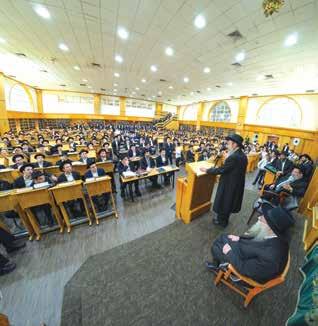
when was learning in Chevron Yeshiva, all of the other talmidim used to speak with him in learning. Rav Cohen’s brilliance in learning propelled him to become rosh yeshiva of Chevron, one of the most prominent yeshivos in Eretz Yisroel. He is renowned for his clarity in learning,

his wide-ranging yedios haTorah, and his modesty and sensitivity.
Today, Rav Cohen’s influence spans beyond the walls of his yeshiva, as he serves as a guiding light to thousands of bnei Torah across the world.
His visit left a deep impression on
Photos by Naftoli Goldgrab
Darchei’s talmidim, providing them with inspiration and chizuk as they strive to grow in their own learning and avodas Hashem.





August is an expensive time; families have just paid for camp for their children, schools are requesting deposits for the upcoming year, and on top of that, children want brand new backpacks and school supplies for a fresh new start in school. For families
that struggle to make ends meet, buying new school supplies can fall by the wayside because they simply cannot afford to pay school deposits and purchase new backpacks and supplies. Given this reality, JCCRP steps in to fill the void.
On August 14, 2024, JCCRP hosted



their annual backpack distribution, distributing school supplies and insulated lunch boxes to families in need in our neighborhood. JCCRP’s new backpack campaign initiative allowed camps to participate in donating new school supplies to the campaign. As camp ends, local campers have learned about how children and their parents in their bunk or class who are neighbors and friends are struggling. They want to assist their friends in need in the most dignified manner possible, and that is why they want to support what JCCRP does to assist struggling families throughout year. Thank you to Camp Hillel for participating in donating brand new school supplies to the JCCRP campaign! After many weeks of competing bunks aiming to reach the most donations, we are excited to share that BUNK G2C was the winner! This is an important community endeavor that ensures every student starts off the school year with new backpacks and school supplies.
JCCRP offered private appointments for families to pick up backpacks over the course of two weeks; choosing backpacks

in their preferred patterns and colors to ensure families’ dignity. Brand name school supplies were separated into section for pens, pencils, crayons, markers, glue, and more for families to take what their children needed for the upcoming school year. Additionally, all families that arrived to pick up backpacks were offered a variety of foods from JCCRP’s fully stocked, all-kosher food pantry. Families with infants and toddlers selected diapers in the appropriate sizes for their young children as well. Many thanks to Congresswoman Grace Meng and Met Council for their wonderful diaper bank, which allows JCCRP to distribute diapers at no cost to the community. Thank you to UJA-Federation of NY and Councilwoman Selvena Brooks-Powers for all of your support to make this community event a success!


The school year is off to a great start at Gan Chamesh! The children are happy and enjoying getting used

to their new environment. We are looking forward to a fantastic year!

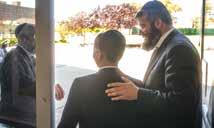




With tremendous excitement, HANC Early Childhood Center in West Hempstead opened its doors to welcome the youngest students. With great fanfare, the children entered the building with smiley faces that were captured in their keepsake first day of school photographs. The children were greeted by Morah Trudy Rubinstein, Early Childhood Director, and proceeded to their new teachers and were escorted to their colorful, inviting classrooms. Once the children had an opportunity to acclimate to their new surroundings, the students were treated to a Rosh Chodesh Elul celebration, including singing and enjoying special cookies and snacks. Later in the day, the Nursery Aleph and Bet children were delighted to be the first children to play in the brand new playground designed just for them. The beautiful new play space included climbing areas, play houses, slides, jungle gyms and many creative play equipment and structures for the yeladim to explore and enjoy.
Morah Kayli, our wonderful music

teacher, joined the classes with beautiful new Hebrew songs in addition to some of the old favorites that the yeladim sang at their first Shabbat party. At the end of a short but very busy week, the children celebrated the approach of Shabbat in their classrooms, learning the parsha and enjoying special treats to usher in the joy of Shabbat. The yeladim had a wonderful time in the ECC and can’t wait to see what adventures they will have next week with their new morot and new classmates.
Ezra Academy has launched its new school year with an inspiring theme centered around “V’halachta B’drachav,” which translates to “And you shall walk in His ways.” This theme emphasizes the importance of middos and encourages students to act in ways that emulate Hashem’s kindness, patience, and compassion. By focusing on this profound concept, the school aims to guide students not only in their academic growth but also in their personal and spiritual development. The theme aligns with the school’s mission to cultivate well-rounded individuals who live their lives with purpose and integrity.
To bring this theme to life, Ezra Academy has creatively decorated its hallways with road signs and maps, symbolizing the journey of life and the directions we follow to become better people. The decorations, introduced during the orientation, serve as visual reminders of the moral and ethical choices we face daily. Each signpost represents a different mid-
dah, such as kindness, respect, and humility, and encourages students to take those “roads” in their interactions with peers and teachers. The maps provide a metaphor for the spiritual journey each student embarks on, with the Torah as their guide and Hashem’s ways as their destination. Students will also participate in projects and learning throughout the year focusing on this theme. This initiative at Ezra Academy fosters a learning environment where students are constantly reminded to reflect on their actions and decisions. The road sign and map imagery ties seamlessly into the year’s theme, making it both engaging and educational. As the students walk the hallways, they are not just physically moving through the school – they are symbolically navigating their paths toward becoming better versions of themselves. Ezra Academy is ensuring that middos and the desire to emulate Hashem remain central to the school experience throughout the year.





By Hadassah Bay
As Anglos seek new opportunities in Israel, several lesser-known neighborhoods are quickly becoming attractive alternatives to more established areas. From the evolving landscapes of Jerusalem’s Katamonim and Arnona Residence to the suburban growth of Carmei Gat in Kiryat Gat, these communities offer a blend of modern living, tradition, and connectivity at more affordable prices. Each neighborhood provides unique advantages for those looking to make their home in Israel.
Katamonim, once a modest part of Jerusalem, is now undergoing significant redevelopment that could reshape its future as a hub for Anglo residents. A prime example of this transformation is the visionary Berger Towers project, led by the Berger Group. With 390 high-standard units at prices far below those of more familiar Anglo areas, the project is set to redefine expectations. The development, designed with a strong sense of

community in mind, includes amenities such as a private synagogue and plans for a school under the leadership of Rabbi Shmuel Silber from Baltimore.
Meir Sand, one of the driving forces behind Berger Towers, emphasizes the project’s focus on building community.
“We wanted to create a place where people can live near friends and family, have all the amenities they need, and still pay much less than in other parts of Jerusalem,” he explains.
The Berger Towers will feature plenty of retail spaces, gyms, pools, and other desirable amenities. The project’s strategic location, close to major roads and future light rail lines, makes Katamonim an increasingly appealing neighborhood option for those seeking affordable, well-connected living in the heart of the city.
In contrast, Arnona Residence offers a more upscale alternative. Located in one of Jerusalem’s most prestigious areas, this project by Azorim showcases two 22-story luxury towers, complete

with rooftop terraces, a state-of-the-art gym, and lush green spaces. The neighborhood’s mix of historical charm and modern urban convenience draws Anglo residents looking for a combination of prestige and accessibility.
Arnona’s proximity to key sites like the city center and the Old City, as well as major roads like Hebron Road and Highway 16, ensures easy travel throughout Jerusalem. Its balance of private living spaces, ornamental gardens, and street-level commercial areas adds to its appeal as a haven for those seeking a refined urban lifestyle.
Beyond Jerusalem, Carmei Gat offers an alternative for Anglos willing to look outside the capital. Established in 2017, this growing community in northern Kiryat Gat has quickly become known for its affordability and quality of life.
With amenities such as Israel’s largest Sportek, shopping centers, and recreational spaces, the neighborhood is a family-friendly environment where community spirit thrives. Synagogues like
Carmei Zion and Kehilat Shalem further support the welcoming atmosphere for English-speaking families.
What sets Carmei Gat apart is not just its community feel, but its affordability and investment potential. With property prices far lower than in Jerusalem or Modiin—around $650,000 for a four-bedroom apartment—this neighborhood offers a more accessible entry point into Israel’s real estate market. Its excellent connectivity to major cities via train and Route 6 makes commuting convenient, allowing residents easy access to employment hubs and urban centers.
For those looking to explore these rising Anglo neighborhoods in Israel, the upcoming Real Estate Event provides a valuable opportunity. The event will offer exclusive deals, expert advice on financing, real estate law, home management, and more. Register for the event near you at https://www.expoisrael2024.com.



HALB parents, students and faculty had a blast at the Back-toSchool Color Run! The PTA arranged for a fun day with a color run,
bouncy houses, obstacle course, balloon animals, face painting, Rita’s and pizza.
We are looking forward to a great school year!

Opening day of 5 Towns Flag Football brought to you by FM Home Loans was a huge success! All the boys were so excited to compete and play with their new team. In the Pre-1A league, Rabbi Jeremy Fine introduced the boys to the concepts of running and catching the football. In the first grade division, the boys played great and showed how much they improved since last season. In the second grade division, the Eagles tied the Patriots, the Vikings tied the Jets, and the Broncos beat the Giants. In the third and fourth grade division, the Jets beat the Packers, the Eagles beat the Seahawks, the Vikings beat the Patriots, the Saints beat the Falcons, the Steelers
By Ben Horodenker
For Anglos who own homes in Israel, managing a property from 7,000 miles away can be a daunting task. Fortunately, a range of expert services are available to help make the process seamless, whether you want to generate rental income, use your home as a holiday getaway, or both.
Bayit Property Management: Your On-the-Ground Partner
Bayit Property Management is a onestop shop for all your property management needs. From ensuring your utility bills are paid on time to conducting regular inspections and repairs, Bayit helps keep your property in top shape. Beyond maintenance, Bayit can also help you maximize your investment by managing short-term or long-term rentals. They handle everything from finding tenants to ensuring the property is clean
and welcoming between rentals. Bayit also serves as your local point of contact, so anyone who needs to reach you regarding the property has a reliable representative on the ground.
With years of experience in Israeli real estate, Bayit’s operational manager, Avinoam Tekuzener, assures property owners: “Our professional service gives you peace of mind, knowing your property is in trusted hands.”
TCS Telecom: Staying Connected, Hassle-Free
Another critical aspect of owning property in Israel is dealing with local communication services. TCS Telecom bridges the gap for foreign homeowners by offering comprehensive services in English, including internet, TV, landline, and cell phone packages.
Eitan Gross, VP of TCS Telecom, highlights their customer-first approach: “We provide premium customer service in
English, known for its speed and efficiency.” With support available from 9 a.m. to 11 p.m. (4 p.m. EST), TCS ensures that homeowners, even from abroad, stay connected without stress.
Gross also understands the importance of keeping telecom services active for those renting out their properties. “Whether it’s for the security alarm or the TV, we make sure everything is ready and connected whenever homeowners or their tenants need it.”
For attendees of the upcoming Real Estate Event, TCS Telecom is offering a special promotion: the first month of service free for new customers.
When purchasing property in Israel, having the right legal representation is crucial. Yitzhak Steinberg, head of Steinberg & Co. in Jerusalem, specializes in helping foreign residents navigate the
beat the Broncos and the Giants beat the Dolphins. In the fifth and sixth division, the Panthers beat the Dolphins, the Giants beat the Broncos, the Steelers beat the Patriots, the Packers beat the Seahawks, and the Raiders beat the Jets. In the seventh and eighth grade division, the Patriots beat the Jets, and the Eagles tied the Vikings.
Sportsmanship of the Week Award: 1st – Yechiel Katz; 2nd – Asher Rodin; 3rd and 4th – Yehuda Markowitz; 5th and 6th – Baruch Dachs; and 7th and 8th – Shlomo Davidson
What a great week to start off the new season! We hope to see everyone on the field for the second week of Flag Football.
complexities of real estate transactions in Israel.
Steinberg emphasizes that foreign buyers should be mindful of currency fluctuations, which can significantly impact the final cost of a property. While most transactions are in Israeli shekels (NIS), buyers may attempt to negotiate in their own currency to mitigate risks.
“Even small fluctuations in exchange rates can lead to large financial consequences,” says Steinberg, advising clients to plan accordingly.
You’re invited to meet these experts and many more at the upcoming Israel Real Estate Event. Discover the hottest new Anglo neighborhoods and take advantage of the exclusive deals. Register for the event nearest you at https://www. expoisrael2024.com



The talmidim of Siach Yitzchok are off to an amazing start for the new school year. From davening to learning and all the fun in between, each boy ends their day filled with satisfaction and great achievement.





Shulamith’s back-to-school carnival offered a fun-filled day with a bouncy house, a petting zoo and a range of games for our incredible students and families. Here’s to a wonderful and exciting year ahead!

The new school year is off to a vibrant start at HAFTR, with our hallways filled with the joy and excitement of students ready to learn and grow. From exploring new STEM initiatives to deepening their understanding of Limudei Kodesh, students are diving into innovative lessons and enriching experiences. Expanded extracurricular activities offer even more opportunities for students to connect and thrive in their personal and academic journeys.
As we approach the one-year commemoration of October 7, Israel remains central in our hearts. This past week, all divisions dedicated their learning and davening in memory of the six neshamot lost, fostering a sense of unity and commitment to our homeland.
Our second annual N-8 HAFTR Day brought students together in a meaningful ceremony featuring Tehillim and

songs that celebrated the unity of Am Yisrael. A beautiful art project, “HAFTR Sticks Together,” is underway, symbolizing the bond between our students and Israel.
At HAFTR High School, students are excited about new academic and Israel-related initiatives. Big Sibs welcomed freshmen, ensuring a smooth transition into high school, and everyone is looking forward to strengthening friendships and unity at the upcoming school-wide Shabbaton.
With so much to look forward to this year, we move ahead with optimism, excitement, and a shared commitment to the future of our yeshiva and community. Together, we will make this school year one of inspiration, growth, and connection – both to one another and to our homeland, Israel. Here’s to a successful and fulfilling year ahead!

At the Friendship Circle, there’s never a dull moment. With incredible volunteer-led programs and events happening all year round, children, teenagers, and young adults with special needs always have something exciting to look forward to. In fact, at the end of this past August, we held one of our most highly-anticipated programs of the year: our annual, three-part End of Summer Camp program.
The camp kicked off on Thursday, August 22, with a busload of Friendship Circle kids setting out on a fun-filled trip to Chuck E. Cheese. Each child was paired with a dedicated teenage volunteer who ensured that the experience was both safe and memorable. During the visit, the kids had a blast playing arcade racing games, air hockey, skeeball, whacka-mole, and the like. Others enjoyed jumping on trampolines, taking pictures of themselves in little photobooths, and exploring the indoor play buses. Smiles were seen all around. After the two-hour experience, the group returned to Chabad
of the Five Towns, where they ended the day with the beautiful mitzvah of hafrashas challah. One young girl, with her mother proudly watching, separated the challah before the dough was distributed to the rest of the kids. It was unbelievably moving to see the young girl’s face light up with joy as she enthusiastically said the bracha, after which she turned to our staff and exclaimed, “This is my very first time separating challah! Thank you so much for giving me the opportunity to do this special mitzvah!”
The second trip took place on Monday, August 26, when the group visited the Prospect Park Zoo, an experience that, according to most of the kids, was even more enjoyable than Chuck E. Cheese. During the trip, the kids split up into groups and explored different sections of the zoo at their own pace. They began by feeding tiny food pellets to the goats, watching the swans and seals swim, and observing other animals, such as red pandas, toucans, and snakes. The kids often stared and pointed excitingly,


sometimes even laughing, at some of the animals’ absurd behaviors. When asked what their favorite part of the trip was, most of the kids had the same answer: the monkeys. At one point, the group watched two adorable baby monkeys playfully fighting with one another. And later, the kids giggled as large monkeys angrily showed their teeth and pounced around energetically.
The third and final trip, which was held on Thursday, August 29, was truly exceptional. All the kids and volunteers got on a coach bus and traveled to LifeTown, an incredible 53,000-square-foot town in Livingston, New Jersey, designed specifically for Friendship Circle kids. The day began with a visit to the bank, where every child received a wallet and twelve dollars to spend at the various shops and centers in LifeTown. Some kids headed to the movie theater to buy popcorn and watch a film, while others bought snacks at LifeTown’s grocery store and enjoyed treats at the ice cream stand. Many visited the pet store, made custom t-shirts at the t-shirt shop, and


bought books at the bookstore. There was also a bike shop where kids could rent a bicycle to ride around the town, a salon, where they could make real appointments, and many other attractions. After shopping, the group went on to play in LifeTown’s jungle gym, sensory room, sand room, and basketball court. It was a truly extraordinary day that the kids will, no doubt, never forget.
The Friendship Circle, a project of Chabad of the Five Towns, is an organization dedicated to bringing joy and friendship to the lives of children, teenagers, and adults with special needs. With help from our teen volunteers, we offer a wide range of exciting weekly and monthly programs, including Friends at Home, Judaica Circle, Fun and Fitness, T-YAD (Teens and Young Adults Division), and Kugel and Kumzitz. If you are interested in volunteering, donating, or joining the Friendship Circle family, please visit fc5towns.com for more information.


Recovering from an attempted suicide may require moving through a series of three stages, according to new research published in the journal Archives of Suicide Research. This new model for recovery could change the way people who have attempted to take their own lives learn to find meaning in their lives again.
“So often, suicidal individuals feel this pressure to be ‘fixed,’ and if they’re not, they’re a failure,” said Dr. Yosef Sokol, PhD, author of the new research and a Touro University School of Health Sciences professor.
“Our extensive analysis of the research on recovery shows that it is better thought of as a journey with stages that people pass through as they move from crisis to recovery.”
The new study shows that the slow process of putting one’s life back together after a suicide attempt tends to follow a common three-stage path: precontemplation, contemplation, and active growth.
Precontemplation. This is the early phase, where people don’t see recovery as possible or meaningful. They may feel trapped in an overwhelming situation with no ability or coping skills to lift them out.
Contemplation. There is growing awareness and consideration of the possibility of recovery and change. It’s a murky phase where they start to disengage from suicidal thoughts and start to see glimpses of their meaningfulness to others.
Active Growth. Individuals begin to take small steps forward. Little by little, people develop new coping skills, strengthen their relationships, and rediscover a sense of meaning and purpose.
The Foundation of a Life
“This last stage becomes the foundation for their unique life worth living. They continue to work within this stage to maintain their growth as challenges occur,” said Dr. Sokol.


Yosef Sokol
The new model draws on the Transtheoretical Model of Change, a framework to understand how people overcome addiction. That model outlines five stages that people pass through on the way to lasting change: precontemplation, contemplation, preparation, action, and maintenance.
It also builds on Dr. Sokol’s prior research developing the COURAGE model, which outlines seven key components of a thriving life after suicidal despair: choosing life, optimizing identity, understanding oneself, rediscovering meaning, acceptance, growing connectedness, and empowerment.
“We often think of recovery as this monumental, binary thing — either you’re ‘cured’ or you’re not,” said Dr. Sokol. “We want people to know that recovery is a process, and it looks different for everyone. But it is absolutely possible to find

meaning and hope again,” said Dr. Sokol.
Each year, over 1.6 million Americans attempt to take their own lives. The research team hopes this work will lead to better support for recovery after a suicide crisis that is based on the person’s own stage of recovery and their unique recovery needs.
“The recovery process is long and hard, but the stages move forward. There is always hope for those who know where to look.” said Dr. Sokol.
There is help available for those experiencing crisis. In the U.S., call or text 988 for the Suicide and Crisis Lifeline – free confidential, and available 24/7. For international resources, visit the International Association for Suicide Prevention’s website at https://www.iasp.info/ resources/Crisis_Centres/.



HALB eighth grade theme heads broke out the Middle School theme of Directions with an incredible dance to this year’s theme
song. Elul is a perfect time to think about Directions – taking stock of where we are and where we want to go and grow!

New York State Assemblywoman
Stacey Pheffer Amato was honored to be invited and asked to speak at The Beach Shul’s annual dinner. She spoke about her unwavering and unapologetic support for Israel despite constant criticism, and the fight against antisemitism. In the 2024 New York State Budget Assemblywoman Pheffer Amato secured an unprecedented increase in security grant funding for Shuls and Yeshivas. As the only Jewish elected official in South Queens she has and continues to successfully work to provide funding and





This past week, we joyfully welcomed our students back into the building as we embarked on our 33rd year of Torah, Midos, and Excellence!
At Freshman Orientation, the boys had the honor of being the first to enter the building this year and were given full rein to explore and make themselves at home. On their first day, they met some of the staff, received their lockers, and enjoyed a fun-filled day of bowling and bonding.
The following day, all grades were present, and the day began with an assembly in the shul, where we introduced
our new leadership team and discussed the new initiatives directly with our students.
Rabbi Avi Herschman, a member of the Rambam class of 2009 and our newly appointed Rosh Mesivta, opened by reflecting on his 10 years in Rambam, with stints as the hockey coach; being a Rebbe; his tenure as Assistant Rosh Mesivta; and his active involvement in the construction of our new building.
Mr. Hillel Goldman, our newly appointed Principal and former Associate Principal and Director of Student Activities, spoke next. He reassured the students that, even in his new role, he will

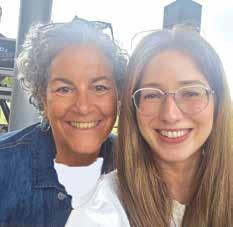
On August 6, 2024, JCCRP employees attended National Night Out by the Far Rockaway boardwalk organized by the NYPD 101 Precinct. Assemblywoman Stacey Pheffer Amato, Councilwoman Selvena Brooks-Powers, Queens DA Melinda Katz, JCCRP, RNSP, Achiezer, and the local Community Board were also present at the event. A big thank you to Menashe Friedman of the NYPD 101 Community Affairs Committee, who orchestrated kosher pizza pies and Rita’s Ices for the kosher attendees!

English teacher.
Both Rabbi Herschman and Mr. Goldman expressed their HaKarat HaTov to Rabbi Zev Meir Friedman, now Rosh HaYeshiva, and Rabbi Yotav Eliach, Principal Emeritus, for their invaluable contributions in shaping Rambam into the Mesivta that it is today. Rabbi Friedman will remain active on staff, teaching halacha to our seniors and engaging in oneon-one learning sessions with students. Meanwhile, Rabbi Eliach will persist in his passionate advocacy for Medinat Yisroel, taking an active role in addressing the many challenges it currently faces.
Several other faculty members also spoke to the students, providing a brief overview of their roles. Among them were Mrs. Marcy Farrell, Director of College Guidance; Coach Jeff Bieder, our new Athletic Director who brings his championship pedigree from Magen David; Rabbi Ilan Schimmel, the newly appointed Director of Israel Guidance; Assistant Principal Rabbi Avi Haar, who discussed the school’s Masmidim Extra Learning Program; Rabbi Dr. Andrew Sicklick, who will lead the new Parsha Yomi initiative; and Rambam Class of 2014 alum, Rabbi Yitzie Milworn, a former IDF soldier and new Rambam Rebbe, who will teach a class on Zionism and has also taken on the role of Director of Student Activities.
Students were also introduced to several new initiatives launching at Rambam this year, offering them fresh
details about their family and role. This initiative is a meaningful way for our students to feel more connected to our brothers and sisters serving in the IDF for Medinat Yisrael.
Another exciting program, launched by seniors Avi Katz and Elazar Schwartz, is the Big Brother/Little Brother Club, which pairs freshmen with seniors to foster mentorship, friendship, and support throughout the year.
We ended the week on a high note, putting the boys in the perfect Shabbos spirit with a special kumzitz led by the talented up-and-coming kumzitz maestro, Eli Dachs.
The boys have so many exciting events to look forward to! Among the highlights are our Camp Seneca Getaway Sports Extravaganza, featuring Divrei Torah, sports, boardgames, videogames, ruach, singing and our 12th Annual Flag-Football Tournament and our 14th Annual Homerun Derby and Gold Glove Tournament! We will also have another Kahoot Tournament! Trophies and glory! They’ll also enjoy the West Hempstead Tisch at Mr. and Mrs. Goldman’s home, the Shiur Shabbaton, and other thrilling sports getaways.
It was a wonderful start to the school year, and we look forward to helping our boys grow into true Rambam Men, creating a meaningful year filled with Torah, Midos, and Excellence.


At YUHSB/MTA, Torah learning is a top priority. The day begins with shiur and other limudei kodesh classes every day. The goal is not just to cover blatt Gemara and perakim in Tanach but to instill the Torah values and priorities that MTA talmidim are known to have.
Rabbi Kerner, a beloved Rebbe at YUHSB/MTA, teaches a motivated group of tenth graders. This past year, he took time to teach the mussar sefer Orchos Tzaddkim for ten minutes every morning. Though good headway was made, the sefer was far from completed.
Rabbi Kerner’s talmidim asked if it
would be possible to continue learning the sefer over the summer, for a few minutes every day. Though the boys were on many different programs, in several locations, they made time to listen to Rabbi Kerner’s voicenotes over WhatsApp to continue their learning of this sefer. By the end of the summer, most of the sugyos were completed!
YUHSB appreciates the dedication of their rebbeim to continue their teaching over extended breaks and is proud of their talmidim for their hasmada!
(Pictured here is Rabbi Kerner with many of his talmidim from last year.)
The administration and staff at HANC Elementary School in West Hempstead have been working tirelessly to prepare for the opening of the new school year. Prior to opening day, the staff joined together for two days of professional development in order to enhance the instruction and experiences of the students for the coming year.
HANC invited Dr. Rona Novick PhD, Dean Emeritus of the Azrieli Graduate School at Yeshiva University, to enlighten the staff about children’s evolving brain chemistry. Dr. Novick shared best practices for teaching children according to how they learn best while devices compete for their attention. She elaborated on the skills that are essential for children to develop in order to thrive in the classroom. Guiding children towards a positive, growth mindset when faced with challenges and helping them to develop self-awareness and self-regulation will enable them to proceed with determination to learn and master not only new material but also the skills to succeed in the classroom and in life. Everyone left the session inspired to empower and equip HANC students with the abili-


After a summer full of preparation, including three full days of professional development, the YCQ faculty warmly welcomed back their amazing talmidim and talmidot last week. Students were thrilled to see one another and their teachers as they streamed into the building ready to learn and grow.
Wednesday was a day of orientation
for Nursery and Kindergarten students. They had the opportunity to meet their morot in small groups and acclimate to their new classrooms. Students and their families returned that night to come together for the annual YCQ PTO PreSchool Bash.
The YCQ family is looking forward to a wonderful year ahead!
ty to reach their full potential and thrive in the years ahead.
On Wednesday morning, the doors of HANC Elementary School blasted open to great fanfare as the excited young neshamas walked the red carpet and bounced happily into the building, greeting their former teachers and reuniting with old friends. It was a magnificent sight to witness as the HANC family reconnected after a summer away at various camps and summer vacations. They were warmly welcomed by the engaging smile of their new rebbe, morah, or teacher. The students eagerly joined their new classes to embark on a year of learning and maturity. Their teachers are equally excited in anticipation of a wonderful year with their new classes.
As is the custom at HANC, the week concluded with the much anticipated Rabbi Yehuda Kelemer zt”l Shabbat Assembly. It was evident from the smiles on their faces that the children had a fabulous first week and were so happy to sit and sing with their friends. Rabbi Ouriel Hazan, Director of HANC West Hempstead campuses, also shared an inspiring video of thousands of people gathered

at the Kotel, davening Selichot together. It was truly remarkable to see so many people singing together in this holiest of places in Israel. After stories and singing of familiar and new songs, the exuberant dancing that ensued ended the week with great joy. Finally, all of the teachers were asked to go up on the stage, and each teacher was introduced as they had their turn to walk the red carpet. With such an incredible start, the students at HANC Elementary School are truly set up for a successful year ahead.
On Sunday morning, under a crystal clear blue sky, the entire HANC family

gathered at the Elementary School for a beginning of the year Carnival. The children had a fabulous time bouncing on and sliding down inflatables, painting rocks, tossing balls into hoops and even playing checkers on a giant checkerboard. Cotton candy and popcorn were served, and each child received either a HANC Kippah or a HANC hair bow as a “Welcome Back to HANC” gift. It was a fun-filled morning for families and a great opportunity for children to see their friends in other grades as well.

As rabbinic positions go, Rabbi Aaron Kleinman’s is among the most unique. A commander in the U.S. Navy Chaplain Corps, his role includes overseeing kashrus on various warships — a challenge he recently shared with over 90 men from the U.S., Canada, and Panama, who are working in, or eager to join, the kashrus field, at the Orthodox Union’s ASK (Advanced Seminars in Kashrus) OU Kashrus Education Program. ASK OU offers in-depth insights and hands-on experience in the kashrus industry via two unique educational programs; a one-week course and a three-week internship.
This year’s seminars took place at the OU’s New York headquarters coupled with site visits around the Tri-State area. Rabbi Kleinman’s session, Kosher at Sea, touched upon the intricacies of keeping kosher while serving in the U.S. Navy.
“We had a really fun session,” he says. “After a brief overview of the Navy, Marine Corps, and their operating environments, I talked about some of the different platforms, including destroyers, amphibious assault ships, and aircraft carriers, and some of the special aspects of kashrus in each of them. We covered a scenario that actually happened to me: the task of preparing a post-Rosh Hashana services meal on a non-kosher aircraft carrier that I wasn’t stationed on. We really got into the scenario; participants shared how they would do things and actually gave me some good ideas. I wish I had had their brain trust at the time I needed it — the meal would have been even better than it was!”

A division of the Orthodox Union, OU Kosher is the world’s largest and most widely-recognized kosher certification agency, certifying over one million products manufactured in 13,000 plants, in 106 countries. ASK OU was launched by Rabbi Yosef Grossman z”l, who served as senior educational rabbinic coordinator and director of Kosher Educational Services at OU Kosher. The ASK OU Summer Kashrus Training Program has run annually on alternate years for men and women since its inception, with the exception of the Covid period. It just completed its 16th cycle.
“The ASK OU Summer Kashrus Training Program presents a chance to demystify what goes on behind the scenes in kashrus and to observe practical applications in real-life context,” says Rabbi Eli Eleff, managing director of Community Relations at OU Kosher, who oversees the program.
Led by the OU’s world-class rabbanim, poskim, and administrators, ASK OU’s weeklong program provides
On Thursday, August 29, HANC incoming freshmen attended an orientation to introduce them to life at HANC High School. Students were greeted on the lawn by administrators, directors and the student senate, exciting music, great food and great vibes.
After a warm welcome by Rabbi Slomnicki, the students participated in team building workshops which included Human Foosball, Simon Says, See Run Build, among other collaborative challenges. The goal was to expose students to the values of communication, perseverance, creativity, problem solving and teamwork – all important lessons for a
high school student both in and out of the classroom. Additionally, these activities allowed students to meet new faces, learn new names and discover what they have in common with their new classmates.
Students also received schedules and Chromebooks, set up lockers and emails, and met with administrators to ensure a seamless transition to a successful high school career. The evening ended with a pizza dinner and Mincha.
During the first days of school, the freshman had class meets to help them acclimate to the school year. Students learned about school culture and the particulars of school life.
an overview of the processes and implications of kosher certification through hands-on seminars and visits to food service providers. A concurrent three-week internship geared for semicha students, rabbanim, and avreichim, includes the one-week program and explores the intricacies of kashrus and halacha in greater depth. Participants gain hands-on experience at food-processing plants and at OU headquarters and network with worldwide industry experts.
This year’s seminar leaders included HaRav Hershel Schachter, shlita, who led a Hilchos Kashrus seminar followed by a Halachic Q & A session; OU Kosher Chief Executive Officer Rabbi Menachem Genack, who spoke about The State of the Orthodox Union; OU Kosher Chief Operating Officer Rabbi Moshe Elefant, who led an Ask the Rabbi session; and numerous OU Kosher rabbanim who presented myriad topics, including How to be an Excellent Mashgiach; Shabbos Appliances; The Wine Industry; Cybersecurity; The Transportation of Commodities;
Red Flag Ingredients; Cheese, Whey and Related Products; and Mesorah of Birds. Participants also learned about industrial and retail kashering and how to establish a local vaad hakashrus.
“Kashrus does not exist in a vacuum, and there are certain ways that it’s applied,” notes Rabbi Eleff. “Whether in New York or out of town, each vaad hakashrus has its own nuances and specific requirements. We wanted participants to understand that kosher is really quite broad, rather than one size fits all.”
Visits to OU Kosher certified restaurants Wall Street Grill and Reserve Cut and tours of OU Kosher certified processing plants including Newburg Egg, Biazzo Dairy Products (which manufactures specialty cheeses), Hanover Foods (which manufacturers canned and frozen vegetables), and Empire Poultry, among others, offered a glimpse into kashering operations and facilities’ unique kashrus issues.
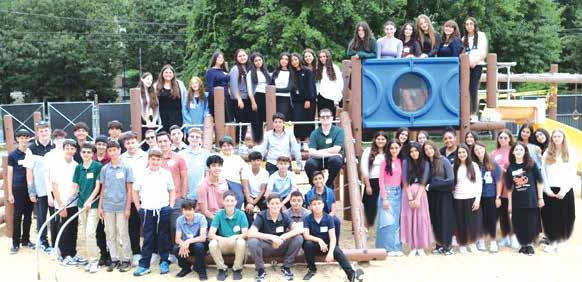







To kick off the new school year, HANC High School held their annual Opening Ceremony and Back to School Senate Event. Seniors, freshmen, and new faculty were introduced to the student body with warm welcomes. Prior to the ceremony, the Class of 2025 received their senior shirts and then made their grand entrance into the auditorium with ruach and excitement. In traditional HANC ruach, the parade of departments marched down the aisle, props in hand, celebrating the new academic year.
Students had the opportunity to hear from Rabbi Slomnicki who, in his mulit-media presentation on the art of Norman Rockwell, discussed the value of self-reflection and their individual role in a community. The student body also
heard from Student Senate President, Leora Peyser, and Noam Traegar spoke passionately of the many exciting ideas and events in store this coming school year.
The entire school had lunch on the lawn and at the end of the day were then invited to an outdoor Back to School Senate Ice Cream Event where students reunited with friends and faculty. It was awesome to see everyone again after the summer vacation.
“The first days of HANC were epic! The high school’s 51st year has begun with increased enrollment, energy and ‘simcha’ in a time when Klal Yisrael needs the strength of our youth,” said Rabbi Slomnicki.
Welcome home HANC High School; we look forward to an amazing year.
Mercaz Academy in Plainview is proud to share the news that their Director of Educational Technology, Mrs. Lynda Last, has been announced as one of sixteen “Sphero Heroes” worldwide.
“This diverse group of educators has been selected for their innovative use of Sphero robots, littleBits, and Blueprint engineering kits to inspire students and create engaging learning environments. These educators are pushing the boundaries of what’s possible in STEM education,” wrote Amanda Vaden of Sphero News. “Each Sphero Hero brings a unique approach to their classroom and school, utilizing hands-on technology to foster creativity, critical thinking, and a love for learning.”
Mrs. Last uses programmable robots–including the classic Sphero as well
as Sphero indi cars–to teach the usage of programming algorithms in an exciting, hands-on way. As the creator of many innovative lesson plans for Early Childhood and elementary school students, she was delighted to be selected as one of the latest Sphero Hero cohort, representing “the very best in educational leadership and passion for STEM.” Teachers in the Sphero Hero cohort will have the opportunity to test and offer input on new robots, consult on innovative teaching methods, and collaborate on projects with fellow Heroes.
“I’m so excited about this because as a Sphero Hero, I will have access to all the latest and greatest technology to use with my Mercaz students,” said Mrs. Last. “I’m looking forward to getting started–we’re going to do amazing things with technology this year!”

The Central Wildcats are coming home! This week, the Yeshiva University High School for Girls faculty and staff returned to campus for the 2024-25 school year. Faculty, staff, and students reunited with a high-energy week filled with learning and programming.
“It was an incredible way to start the year, giving all of us strength to persevere during such a challenging time for all of Am Yisroel,” said Central’s Head of School, Ms. Bracha Rutner.
The year began for faculty on Tuesday, September 3 with a day of professional development, which welcomed new staff members and offered a review of Central’s updated AI Policy, with a tutorial on new AI innovations available to educators from Central’s Director of Technology, Mrs. Marci Karoll. Central’s Director of Guidance and Humanities Department Chair, Mrs. Rena Boord, introduced the staff to SCOIR, a new college planning platform that promises to make this year’s application process easier for students, parents, and teachers alike, and Ms. Leah Moskovich, Associate Principal, went through the year’s calendar and important updates. The afternoon session offered faculty members an opportunity to embrace the new theme of the 2024-25 school year, “Cultivating Courage,” with the workshop “Self Reflection as a Way to Strengthen Our
Teams” by education consultant Mrs. Alanna Kotler, which challenged the group to start the year with some fearless self-inventory.
The following day, Central hosted the class of 2028 on campus for freshman orientation, which included breakfast and an introduction to the building in the form of a scavenger hunt. The scavenger hunt was led by Central’s G.O., allowing Central upperclassmen to give the newest Wildcats a warm welcome. Family Fun Night offered food, games, and community time for faculty, staff, and their families that evening.
Thursday, September 5, was the first official day of school for all students and faculty.
“The energy, excitement, and love of Central was palpable as every bus pulled up to school. We are so thrilled to welcome home our students,” said Central’s Associate Principal, Ms. Leah Moskovich.
This first week back is only the beginning of what will be an exciting, productive fall semester. Upcoming events include Central’s annual schoolwide Shabbaton, which will take place at Camp Kaylie in just a few weeks. As we join together as a school right before Yom Kippur, our theme of the year will extend into Shabbaton, as we dig deep to find “The Courage to Crown.”

This past Sunday kicked off a new season of events at the Israel Chesed Center. Over 750 people came to the “Israelis for Israel Fair” at the Chesed Center, enjoying a beautiful Sunday while supporting our brothers & sisters in Israel.
Thank you to the 4th Precinct and Hatzalah for providing security and crowd control, enabling young and old alike to enjoy pizza, frozen yogurt, face painting, cotton candy and jewelry making. And of course, Chabad was on site helping people put on tefillin and make brachot as a zechut for our chayalim and chatufim
Our next big event – the Pre Yom Tov Shuk – is scheduled for Sunday, September 15 (see ad on page 79). From 10-6 on Sunday, numerous local vendors will be
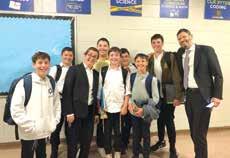
on site offering tastings and the opportunity to pre-order food and wine for the chagim, with proceeds benefiting Acheinu B’nei Yisrael Spruce D’vine will be offering tastes of over 20 wines, whiskeys and liqueurs, while local food favorites Crave, Iced, The Cheese Store and Fruit Platters & More will be handing out tastings of their fare. Adam’s Meats, the Chesed Center’s neighbors, has assembled a full menu of fresh meats, platters and dips available for order for yom tov. Jerusalem Florist will be displaying a number of flower arrangement options, and the Chesed Center will have booths selling jewelry, gifts and Judaica at various price points. Finally, the Succah Spot has a number of sukkah options on display in the parking lot, and will be on-hand to take orders for


sukkot, schach and decorations. They will also be selling Arba Minim at the Chesed Center during the days leading up to Sukkot.
Visitors will also be able to sign up for future Chesed Center events, including the Bake Sale (Sept. 28-29) and the October 7 commemoration and community


art project.
Come down to the Israel Chesed Center – 1315 Peninsula Blvd., Hewlett, on Sunday from 10am-6pm to enjoy the Pre Yom Tov Shuk and to support Israel.
For more information, contact israelchesedcenter@gmail.com.


SHS seniors began their week with an expedition intended to help them develop as the newest leaders of the Shulamith student community. Through team and trust-building activities, they worked on navigation through communication, relying on guidance from peers in order to succeed in various missions. The leader of the Empower Leadership course, Dan, emphasized their job as role models for the rest of the student body, making them aware of their influence and power to help young-
er students adjust and feel welcome within their new space.
The second half of the day involved reaching new heights – up in the trees, ziplining through the forest. The course presented a challenge to some students who weren’t fully comfortable with heights, but they pushed themselves to give it a try and zipped with flying colors. The day was filled with vibes of unity and bravery within the grade, while also focusing on the theme of respect and inclusivity with underclassmen.
Anew beginning is in the air at Stella K. Abraham! Freshly painted walls, floors stained and polished, clean notebooks, sparkling supplies, inspiration waiting to be gained and shared. The start of the school year always brings an air of excitement and freshness with it, and this year’s start has far exceeded expectations at SKA! The senior class brought the “ruach and spunk” as they decorated the hallways and greeted the rest of the school on the first day singing and dancing. The energy was electric as the girls entered their
Did you know?

home away from home with excitement for what lies ahead in a fresh new year. On the first day of school, cotton candy, snow cones and popcorn peppered the lawn during lunch for all to enjoy. Looking forward to a great new beginning at SKA!
President Franklin D. Roosevelt and President Theodore Roosevelt were fifth cousins. Franklin’s wife, Eleanor, was Theodore’s niece (the daughter of his brother Elliot).

This past Sunday marked the season opener of the JSL 2024 Fall Season sponsored by FM Home Loans, and things kicked off smoothly! The 1st-8th Hockey division began their regular season after completing player evaluations the week before, while other divisions conducted their evaluations this past Sunday. The boys were excited and eager to start the new season! 1st8th Hockey players sported brand-new dri-fit JSL jerseys, and everyone received special water bottles from Wieder Orthodontics. The league extends a big thank you to our league sponsor, FM Home Loans, and our MVP sponsors: Town Appliance, Wieder Orthodontics, Smash House Burger, and Maidenbaum. We also appreciate our Super Star Sponsors, SR Whee and Marciano Pediatric Dentistry, along with all of our team sponsors, as we embark on this exciting new season!
SL Juniors
K/P Hockey: Refael Rosenberg and Eli Samuel showcased impressive skills during evaluations, even scoring a few goals during the Week 1 exhibition evalu-
ation game! Asher Prince outmaneuvered the orange team, finishing with a beautiful goal. The boys in K/P looked sharp as they prepare for their promising JSL careers.
K/P Soccer: Levi Rose stood out with his incredible ball control and finesse, while Asher Brill delivered some powerful shots on net. Moshe Obadia looked like Lionel Messi, weaving through defenders and scoring with ease!
Football: Shua Gordon executed a slick step-back move on offense, while Meir Feuer caught a pair of impressive long touchdowns! Shragi Klein showed excellent route running with sharp cuts, and Daniel Grabie played outstanding defense.
1st: Yaakov Kret delivered a thunderous slap shot, propelling Town Appliance to a bright and breezy 9-1 victory over Seasons Express. Michoel Ruzohorsky dazzled with a cheeky through-the-legs goal as Simcha Day Camp skated to a fun-tastic 6-3 win against John’s Automotive. The first goal of the season came


from ex-goalie Meir Kopelowitz, while team MVP Dov Stein added two more for John’s Automotive. Despite a stellar performance from goaltender Avrumi Sinensky, John’s Automotive fell short, earning our sportsmanship award for their grit! Jake Ptalis made a clutch save as Wolf Phone Repairs narrowly edged out PlumbPro with a phone-tastic 4-3 win.
2nd/3rd: Akiva Greenspan showcased a spectacular wrist shot from half court, leading Smash House to a smashing 6-4 triumph over The Gallery. Ezra Frenkel hit the top shelf with a stellar wrist shot, guiding SR Whee to an elevated 8-5 victory over S!I!N!G! Entertainment! Dovid Krigsman scored a hat-trick, including a cheeky goal between the goalie’s legs, as Newman Dental claimed a toothsome 5-1 win over Maidenbaum.
4th/5th: Gavriel Levine was on fire with 8 goals, leading Russo’s Pharmacy to a medically-superior 10-3 win over Target Exterminating! An incredible wrist shot gave BlueBird Insurance the lead in their coverage-rich 8-2 victory against Marciano Pediatric Dentistry. Dovid Schwadel scored 5 goals, helping Smash House clinch a smashing 7-6 win over Town Appliance.
6th/8th: Goalie Yoseph Treuhaft was a wall, helping Wieder Orthodontics cruise

to a braces-tastic victory in a game they never trailed. Yaakov Rosenberg added to the success with solid puck control and a goal, leading Wieder Orthodontics to an 8-4 win over NY Custom Closets.
3rd/4th: David Bauman displayed excellent ball handling skills, while Eitan Greenspan consistently found the bottom of the basket! Sam Robinson and Josh Kohn were relentless on defense, and Yeshaya Pinter impressed everyone with his sharp performance in the 1-on-1 evaluation drill.
5th-7th: Josh Mashiach stood out with his exceptional play, and Avi Abramson had a near-perfect shooting percentage in the evaluation game! Solomon Licht wowed the evaluators with his incredible skills and command of the basketball and the game.
In the 2nd/3rd Hockey Week 1 opener, Built By Nate and PIP Printing were evenly matched, with neither team able to pull ahead! The game was tied 7-7 as the clock ticked down. In the final seconds, PIP Printing advanced the ball down the court and got off a great shot, but Yosef Gordon made an incredible diving save to the left, securing a thrilling 7-7 tie for Built By Nate against PIP Printing!
Rav Shimon Dov Notis, maggid shiur in Mesivta Chaim Shlomo, sharing divrei zikaron about his rebbi, Rav Avrohom Ausband, zt”l, with the talmidim of Yeshiva Darchei Torah’s middle school
by Rabbi David Ashear
Each Drop
The month of Elul is a time of introspection, a time to think about what we might be doing wrong and accept upon ourselves to improve. Rabbi Moshe Alexandrov said he used to see his rabbi, the Chofetz Chaim, weeping during Elul. On one occasion, before Selichos, he heard the rabbi rebuking himself. “Yisrael Meir,” he cried, “did you thank Hashem enough for giving you the seichel (intellect) to write your book, Sefer Chofetz Chaim? Did you thank Hashem enough that people are learning from it?” And his list continued.
It is incumbent upon us all to recognize and thank Hashem for all He gives us. Thanking is not reserved for when Hashem miraculously saves us from some big problem or when He brings a yeshuah for a long-standing issue. Thanking is something we are supposed to do every day, for the regular, everyday blessings Hashem gives us.
In a certain shul in Eretz Yisrael, whoever sponsored the kiddush on Shabbos morning also spoke during the seudah.
One week, the speaker got up and said, “I’m donating the kiddush today to thank Hashem for the refuah sheleimah He gave me for the sickness I had.”
The next Shabbos, the speaker declared that he was thanking Hashem because he was in a horrific car accident and walked away without a scratch.
The week after that, the sponsor said there was a fire in his house. Baruch Hashem, he got everyone out in time
and wants to publicly thank Hashem for that.
For the next few weeks, every speaker told a similar story of salvation.
One week, as the sponsor rose from his seat to speak, everyone waited with bated breath to hear what he had gone through. He said, “I’ve been listening to all the speeches this year, and I’m very inspired. I don’t have any miracle to tell you about. I was not saved from any difficult circumstance. I am sponsoring the kiddush today to thank Hashem that I did NOT endure an illness, I was NOT in a car accident, and my house did NOT catch fire. Baruch Hashem, everything is running smoothly.”
We don’t have to wait to be saved to thank Hashem. We can thank Hashem for all the potential harm from which He spared us.
Thanking Hashem should be part of our daily routine. The first bracha we say in the morning in the Birchos HaShachar is “Hanosen lasechvi vinah l’havchin bein yom u’vein loylah.” Simply explained, we’re thanking Hashem for giving the rooster the ability to discern the difference between day and night. The sefer Chai B’Todah asked: Should this really be the first bracha we make to thank Hashem? Hashem gives us so many blessings that we’re about to thank Him for: our eyesight, our strength, the ability to move around. Why do we start off thanking Him for the wisdom He gave the rooster?
He quotes the Alter from Slabodka who explained, based on the Gemara (Brachos 59b) that asked: What blessing should we recite to thank Hashem for

rain? Rav Yehudah answered: “Thank You, Hashem, for each and every drop [of rain] You provided for us.” Rain gives us so many benefits. It waters the fields, causes crops to grow, quenches our thirst. The rabbi could have included in that blessing something about those benefits, but instead, he talked about thanking Hashem for each drop of rain individually. One droplet of rain does not give much benefit. Nevertheless, Rav Yehudah is teaching us that the way we are supposed to thank Hashem is to take notice of every little detail, to say, “Thank You, Hashem, even for that.”
Wisdom is the greatest gift given to mankind. It is what enables us to do everything we do in life. The first droplet of wisdom, so to speak, says the rabbi, is the wisdom given to the rooster. It is the smallest amount of wisdom in creation, and we’re saying, “Hashem, thank You for every drop of wisdom You gave us — even for that.”
If we could train ourselves to thank Hashem in our own words for every drop of bracha He gives us, each “thank

You” will eventually turn into an ocean of “thank Yous.” Besides the immediate benefits we gain by being appreciative people, one day we will see how much spiritual gain we received every time we expressed our gratitude to Hashem.
Reprinted from Living Emunah on Yomim Noraim by Rabbi David Ashear with permission from the copyright holder, ArtScroll Mesorah Publications.




Your kids set 14 alarms and still miss the bus but somehow wake up at 6 AM on Shabbos morning.

You wish that “Common Core” was a gruel ing new workout, rather than just a math puzzle designed to break adults.

School emails now arrive more frequently than spam offers from Nigerian princes.

You are thinking of volunteering to teach a class at your kids’ schools just so that you have a designated parking spot for all of the orientations.


The last thing you hear before you go to sleep is something like, “Oh, yeah, my project is due tomorrow. Can you help me with it??



You forgot what your living room floor looks like under all the backpacks and random worksheets.

Your Google search history is now 90% “how to do 7th-grade math” and 10% “cheap wine deals.”
Summer is not even over, and you’re already praying for snow days...so you can sleep past 6 AM.
Despite the Ozempic, you realize that it’s hard for a 6’1” middle-aged guy to sit in a 2nd grader’s desk (are we meant to be humiliated like that at orientation?).

You’ve stopped caring what’s in the lunchbox as long as it doesn’t crawl back out.

You walk into a school supply store and instantly get PTSD from the summer shopping spree.

Your grocery bill has tripled, and 90% of it is for snack bags.
One day Jimmy got home early from school and his mom asked, “Why are you home so early?”
He answered, “Because I was the only one that answered a question in my class.”
She said, “Wow, my son is a genius. What was the question?”

Jimmy replied, “The question was ‘Who put crazy glue on the teacher’s chair?’”
1. Boston Latin (High) School is the oldest continuously operating school in the U.S. When was it founded?
a. 1635
b. 1726
c. 1789
d. 1832
2. Which U.S. state has the highest number of public schools?
a. New York
b. Texas
c. California
d. Florida
3. What is the average public school teacher’s salary in New York?
a. $42,351
b. $68,449
c. $87,163
d. $102,468

4. What is the national average student-teacher ratio in U.S. public schools?
a. 10:1
b. 16:1
c. 22:1
d. 30:1
5. What is the annual tuition at Manhattan’s Think Global High School?
a. $47,000
b. $62,500
c. $78,2000
d. $94,000

6. How many required school days are there in New York?
a. 155
b. 180
c. 210
d. 275

Answers:
Wisdom Key:
5-6 correct: You know all the answers. Tell me, how many snow days are we going to have this year? Please, I need to know!
2-4 correct: You would make the New York Department of Education proud because you know a little bit but not too much.
0-1 correct: Let’s just say that you did not attend the Think Global High School.
What is the similarity between “2 + 2 = 5” and your left hand?
Answer: Neither is right.


By Rabbi Berel Wein
In this week’s parsha, the Torah portrays for us an accurate and unforgiving view of war and its personal consequences. No one who participates in a war escapes unscathed from these consequences. The ones who are killed or wounded have suffered these consequences on their very physical bodies. But even those who have survived the battle whole are affected by the consequences of that struggle.
That is the supremely important, albeit subliminal message of the beginning
of this week’s parsha. A Jewish soldier, who according to the ritual requirements of becoming such a soldier and being accepted for the battle as outlined in last week’s parsha, a G-d-fearing patriotic and observant person, somehow enters into a relationship with a non-Jewish woman, a relationship which Rashi points out to us will only bring him future grief and regret.
The heat and passions that war and combat engender within a person cannot be limited to the actual battlefield alone.


They carry on within the psyche and body of the combatant and find different ways of expression in all other areas of human life and experience.
The observant Jew, who under ordinary and usual non-combat circumstances is scrupulously pious and moral in one’s behavior, now enters into a physical relationship with a non-Jewish stranger. Is this not the strongest message possible that the Torah wishes to communicate to us about the consequences and effects of war?!
War requires the abandonment of personal inhibitions. That will help ex-
affairs, Israeli society has been affected and even shaped by the presence of constant combat and warfare. Much of the rough spots that still exist in our society –the divisiveness, the absence of mannered courtesy, the unnecessary assertiveness, etc. – are all consequences of our being in a constant state of war. Inhibitions and piety are hard to maintain under such conditions and consequences.
Peace is not merely an absence of a hot war. It is a state of mind that induces tranquility, rationality and all around general goodness. That is why peace is so exalted in the works of the prophets
Is this not the strongest message possible that the Torah wishes to communicate to us about the consequences and effects of war?!
plain the scenario portrayed for us by this opening parsha of this week’s Torah reading. Without inhibitions, there can be no morality or piety.
But as all of us living here in Israel are well aware of, war is a constant state of affairs in our national and personal life. The Jewish people have been at war here in the Land of Israel for almost all of the years of the past century. These wars may not be of our choosing or our initiative, but they are omnipresent in our lives and society.
And because of this difficult state of
and throughout the Talmud and Jewish tradition. And that is why we pray three times daily that its presence should be felt amongst us. With peace – both inner and outer – such events as portrayed for us at the beginning of this week’s parsha simply do not occur.
There are no people that long for peace as greatly as do the people of Israel. May the L-rd bless us with the achievement of peace and thereby restore us to normalcy, piety and eternal goodness.
Shabbat shalom.


By Rav Moshe Weinberger
Adapted for publication by Binyomin Wolf

This parsha has more mitzvos than any other parsha in the Torah, but the first three mitzvos mentioned are some of the hardest to understand. Chazal tell us that these three mitzvos represent a causal progression. First are the guidelines in connection with taking a woman captive and marrying her. Rashi explains that such a relationship will lead to one marrying another wife whom he loves more than her, such that the Torah has to tell us that he may not give a first-born inheritance portion to the son of his beloved wife if the son of the captive woman is his firstborn. Finally, if children grow up in such a strife-filled house, the result will be a rebellious son.
The mitzvos related to the rebellious son are the most difficult of all to understand. If a bar mitzvah boy steals from his parents and eats meat
and drinks wine, the Torah shockingly tells us (Devarim 21:21), “And all of the people of his city shall stone him, and he shall die.” Our only consolation is the fact that Chazal tell us (Sanhedrin 71a) that “The [death penalty for] the rebellious son never occurred and will never occur.” What, then, is the point of this mitzvah if it will never be carried out? The Gemara answers that the Torah teaches these rules in order that we “learn it and receive reward.”
But we must understand what we can learn from this mitzvah that applies to our lives on a practical level if such a thing can never happen according to the accepted view of Chazal.
In order to understand this, we must first see why a rebellious son is killed. We know that although what he did is bad, stealing from one’s parents and eating meat and drinking wine are not
capital crimes! Rashi, quoting the Gemara in Sanhedrin (72a), explains that the rebellious son is killed to prevent him from becoming guilty in the future. The Gemara says, “The Torah understands the depths of his mind. In the end he will use up his father’s money and he will seek to satisfy his habits but will not be able to. He will then stand at an intersection and rob people. The Torah therefore says, ‘Let him die innocent [of the more serious crimes] and not die guilty.’”
In other words, this young man is headed down a path of guaranteed failure. But because there are so many variables and possible paths, it is difficult for beis din to be sure that his path will eventually lead him to rob and murder. The Torah’s teachings make one thing clear though. A person’s current direction is connected to his ultimate destination. This lesson is so important that
the Torah says about it, “Learn it and receive reward.”
Many of us are bothered by the following question raised by the Mizrachi: The Torah says (Bereishis 21:17) regarding Yishmael, “And G-d heard the voice of the boy. And an angel of G-d called to Hagar from Heaven and said to her, ‘What are you worried about Hagar? Do not be afraid because G-d has heard the voice of the boy at the present time.’” Rashi, quoting the Gemara (Rosh Hashana 16b), says “[The phrase [‘at the present time’ means that] he is judged according to his actions now and not according to what he will do in the future. The ministering angels were prosecuting and saying, ‘Master of the World! You want to create a well for someone whose seed will kill your children with thirst in the future?!’“ While the Gemara was referring to a specific incident, based on
the aggravation and terror the Jewish People and the whole world would suffer from the descendants of Yishmael, we can certainly sympathize with the angels’ question! But Hashem answered, “‘Now, is he a righteous person or a wicked person?’ They said to Him, ‘A righteous person.’ He said to them, ‘I will judge him according to his deeds now. This is why [the Torah said Yishmael was answered] ‘at the present time.’”
Based on this Gemara, the Mizrachi asks why the rebellious son is judged based on what he will do in the future while Yishmael was judged based purely on his actions at the present time. He gives a very simple answer. He explains that the difference is that Yishmael was on a perfectly righteous path and so could only be judged based on his present righteous state, while the rebellious son was already on a destructive path and was therefore judged based on the destination his path was already leading him on.
Especially as we approach Rosh Hashana, we now understand what Hashem wants us to learn as we read about the rebellious son. Rav Chaim Goldvicht, zt”l, the Rosh Yeshiva of Kerem B’Yavneh, expressed it this way.
The question before every person is: Where are you holding “at the present time”? Are you like the rebellious son whose evil is progressing and developing within him as a ‘root full of rot and wormwood,’ or are you like Yishmael, cast out into the desert crying out to Hashem from the depths of your heart?
on even small aspects of his character which could lead him down the path of the rebellious son.
But on the other hand, our focus should be on the present, ensuring that our “present state” is the good path. Rather than thinking about what happened yesterday or what we will be like
Rather than thinking about what happened yesterday or what we will be like in the future, we have to focus our attention on the present moment.
If it is the latter, then even if you experience failures in the future, you are judged according to your present state. What a powerful lesson! On the one hand, one may never close his eyes to his faults which could evolve over time into a way of life which is completely against Hashem’s will. He must certainly work

in the future, we have to focus our attention on the present moment. We learn from the Torah’s message regarding the nexus between the rebellious son and Yishmael that our present state is the most important thing. There will always be failures along the way, but if we’re on a good path, Hashem will look
at the goodness of our present state. We must not let ourselves be discouraged by the past or the unknown future.
Rav Goldvicht noted that perhaps this is why we read the story of Yishmael on Rosh Hashana. Everyone on earth can read this story and realize that he can turn a new page at any time and create a new “present time” for himself. As we say on Rosh Hashana, “This day is the beginning of Your work.” On a simple level, this refers to the fact that Hashem began creating the world on Rosh Hashana. But according to what we are learning, it also means that today is the day when we begin our own work, where we redefine who we are and where we are headed.
May Hashem grant all of us the wisdom and will to redefine our “present state” for the good and be judged immediately for good life and peace.
Rav Moshe Weinberger, shlita, is the founding Morah d’Asrah of Congregation Aish Kodesh in Woodmere, NY, and serves as leader of the new mechina Emek HaMelech.


By Rabbi Shmuel Reichman
The essence of life is growth and progress, as we strive to fulfill our true purpose. And as we explained in our previous article, the only way we can genuinely change, transform, and evolve is if we have the capacity to assert our inner will and to create a new reality within ourselves. This requires a complete re-creation of self within our consciousness – a remolding of our inner world. While yesterday we were the type of person who did one thing, today a new decision is formed and a new reality is created within our inner world. This requires a complete assertion of willpower, an overcoming of self, and a breakdown and reformation of inner drive and character. This means giving up who we are for who we want to be; sacrificing what we think we want for what we truly want. (See Rambam, Mishneh Torah, Gerushin 2:20, where he discusses the relationship between our true ratzon [“rotzeh ani ”] and our lower self.) It means overcoming the emotional and overwhelming pull of current desire and generating a new “want” within our very core. This is why the Rambam places his seemingly philosophical discussion of the concept of free will amongst the halachos of teshuvah; free will is the very root and foundation of hilchos teshuvah. Without free will, one could never change and one could never become something else, someone new, and someone better.
Strikingly, Rav Eliyahu Dessler explains that many people never experience a true assertion of their free will due to its immense difficulty. This is why many people do not change. Change is hard, uncomfortable, and often requires sacrifice. One must fully and wholeheartedly believe in their new future in order to give up their current lifestyle. However, when we push with all our might, expressing a full force of our inner will, we get a taste of truth, an experience of destiny, and a glimpse of our true self.

However, this understanding of teshuvah, namely, that of return, has an even deeper layer to it. After all, if teshuvah is an act of return, what or whom are we returning to?
Teshuvah: A Life’s Journey
Genuine teshuvah is not just about fixing our mistakes in Elul and Tishrei; it’s about self-expression, returning to our true and higher selves. As we previously discussed, while we were in the womb, we were in a perfect and transcendent state of being, and a malach taught us kol haTorah kulah (Niddah 30b). As the Vilna Gaon explains, this refers to the deepest realms of Torah, a transcendent Torah that lies far beyond this world, beyond the confines of space and time. (Quoted in Maalos HaTorah by Rabbeinu Avraham, brother of the Vilna Gaon. See also Even Sheleimah 8:24.) This Torah is the very root of reality, and you were granted complete understanding of its every detail. Not only were you shown this level of Torah, but you also learned your specific share of Torah; you were shown your unique purpose in the world and
how your unique role fits into the larger scheme of the human story as a whole. You were given a taste of your own perfection, of what you could, should, and hopefully will become. And from this transcendent realm, you were birthed into the physical world with the mission to actualize everything you were shown in the womb while in your primordial, perfect state.
In essence, your job in this world is not to create yourself but rather to recreate yourself; to re-attain your original state of perfection, as you were shown by the malach. This time, however, it must be done through free will, i.e., by choosing to become great. Only by overcoming challenge and difficulty, and only by asserting your willpower, can you fulfill your true potential. In essence, our entire life is a story of teshuvah — returning to our original, higher, true self.
This theme is the mystical root of creation itself. All of existence is meant to return to its original true, higher form. When Adam was created, his mission was to return to his root and source, i.e., Hashem. When Adam sinned, all of ex-
istence fell; our goal became to return the world to its higher form and repair a fractured world. In essence, our goal is threefold: to return to our individual higher selves, our collective higher selves as a nation, and our absolute root self –Hashem.
We can now return to our original question regarding how to stop the downwards momentum of failure and bad decisions. The answer is a simple, single-word answer: decide! Choice is the most powerful tool Hashem has granted us. The power of choice allows us to accomplish anything. When life begins to fall apart, and bad decisions start piling up, we must cut off the downward momentum before it grows out of control and before it destroys us. The key is making the decision, asserting your inner will, and focusing its full force toward cutting off the momentum. If you can stop the momentum of bad decisions, of a lifestyle that is draining the life out of you, you can stop it from spreading. With nowhere to spread, negativity is like a flame without oxygen; it peters out and disappears. It all starts with a single decision to turn the tide – to begin building positive momentum, to start climbing uphill, and to start heading toward your ultimate destination. If you can take that first step and push toward your greatness, you will suddenly begin riding that new wave. This is the power of choice; this is the power of positive momentum.
The single most important psychological factor involved in this decision is our response to failure. When we fail, we often become convinced that we are a failure. We believe that by making a mistake, we become the mistake. We integrate past experience into our present identity, and we therefore lose faith in ourselves, our
hopes, and our values. As a result, we begin to cascade downwards, sliding with negative momentum.
The key to avoiding this slide is to disconnect our failures from our identity. We all fail; we all have times where we give in to temptation and do things that we regret. But failing does not make you a failure. It makes you human, a work in progress, someone who is growing and learning. If we learn to view our failures as learning opportunities and as wakeup calls instead of perceiving them as crippling obstacles, we can use them to grow and improve. When we make a bad decision, we cannot let ourselves get depressed. Regret and remorse are essential, but we cannot get lost in these feelings. They must be used in a healthy, balanced, and positive way. When we slip up, take a step backwards, and fall down a notch, we have to immediately stop the downwards movement, pick ourselves back up, learn from our mistakes, and continue our upwards climb. This is the character of one who has a growth-mentality — one who does not get crushed by life but learns from it instead.
It is therefore no surprise that the To -
rah is replete with lessons of the importance of will and the power of decision.
An opinion is quoted in the Gemara (Rosh Hashanah 10b) that man was created in Nissan. Why then do we celebrate Rosh Hashanah in Tishrei? Tosafos suggests that although Hashem created the world in Nissan, His decision to do so took place six months earlier on the first of Tishrei. The decision itself serves as a form of creation, which is why man is considered to have been created in Tishrei.
The Gemara (Kiddushin 49b) rules that if a man marries a woman on the condition that he is a tzaddik (righteous), we consider the marriage as halachically binding – even if he is wicked! How can this be? The Gemara explains that perhaps he had decided at that very moment to do teshuvah (hirhurei teshuvah) and to become a tzaddik, and that intention itself would be enough to validate his statement. Based on this possibility, we must view his marriage as possibly binding. This example, once again, displays the spiritual significance of a decision. There are applications of this idea regarding Shabbos observance as well. If one is outside a city on Shabbos, he cannot walk further than two thousand amos from where he is located at the moment

Shabbos begins. However, the Mishnah in Eruvin notes that if one is in the midst of traveling right before Shabbos begins, he can point into the distance and say that he intends to be at that place in the distance, and his two thousand amos will be measured from that point. Essentially, halacha recognizes us to be in the place where we want to be, where we decide to be.
The Root of Teshuvah
Free will – choice – is the root of teshuvah. Teshuvah is about reengineering our will, recreating our desire, and rewiring our wants. It’s about the decision to be better, to be great, to become our best and truest selves. As the Ramchal explains in Mesilas Yesharim, if you change what you want (akiras ha’ratzon), you change who you are. When you make a new decision, you create a new reality for yourself. When the shofar blows this year, let us truly awaken. In some sense, we all need a shofar for the shofar; we need a wakeup call to listen to this year’s wakeup call. Many are numb to the wordless blast, deaf to its existential calling. Some have given up on change, while others are too busy with life to stop and truly consider the possibility of more, of a greater life. May we all be inspired to fully utilize this
idea, to embark on a journey of genuine teshuvah, and continue the process of becoming our ultimate selves.
Rabbi Shmuel Reichman is the author of the bestselling book, “The Journey to Your Ultimate Self,” which serves as an inspiring gateway into deeper Jewish thought. He is an educator and speaker who has lectured internationally on topics of Torah thought, Jewish medical ethics, psychology, and leadership. He is also the founder and CEO of Self-Mastery Academy, the transformative online self-development course based on the principles of high-performance psychology and Torah.
After obtaining his BA from Yeshiva University, he received Semicha from Yeshiva University’s RIETS, a master’s degree in education from Azrieli Graduate School, and a master’s degree in Jewish Thought from Bernard Revel Graduate School. He then spent a year studying at Harvard as an Ivy Plus Scholar. He currently lives in Chicago with his wife and son where he is pursuing a PhD at the University of Chicago.
To invite Rabbi Reichman to speak in your community or to enjoy more of his deep and inspiring content, visit his website: ShmuelReichman.com.
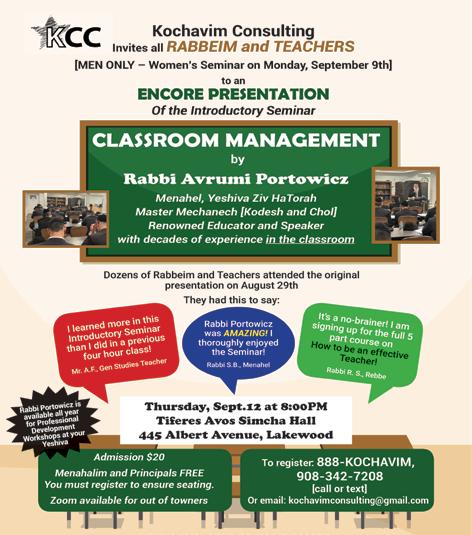
By Rabbi Avrohom Sebrow
In 1961, Edward Lorenz used a numerical computer model to rerun a weather prediction. As a shortcut on a number in the sequence, he entered the decimal .506 instead of the full .506127 the computer would hold. The result was a completely different weather scenario. Lorenz published his findings in a 1963 New York Academy of Sciences paper: “One meteorologist remarked that if the theory were correct, one flap of a seagull’s wings could change the course of weather forever.” Later speeches and papers by Lorenz used the more poetic butterfly. According to Lorenz, upon failing to provide a title for a talk he was to present at the 139th meeting of the American Association for the Advancement of Science in 1972, Philip Merilees concocted, “Does the flap of a butterfly’s wings in Brazil set off a tornado in Texas?” as a title. Hence the popular term “The Butterfly Effect.”
How does the Torah view The Butterfly Effect? Would one be responsible for a possibly unforeseeable consequence of his actions?
The Gemara relates an interesting episode (Bava Basra 73b). Rabbah bar Bar Chanah came across geese in the desert who were excessively fat. Their feathers were falling off because of their corpulence. Underneath them, rivers of oil (excess fat) flowed. Following Rabbah bar Bar Chanah’s query about whether he was destined to receive any part of them as his reward in the World to Come, one of the birds raised its wing and another its thigh, intimating that they represented his reward. Rebbi Elazar commented that Yisrael would have to give reckoning for this.
What did Rebbi Elazar mean by his enigmatic statement? The Rashbam explains that he was referring to Klal Yisrael committing sins, thereby delaying Mashiach’s arrival. As a result of the delay, these geese were getting fatter and fatter, causing them increased suffering. Klal Yisrael will be taken to task for causing these geese to suffer. Presumably, if a person sinned, he

would be unaware of these birds. Yet the totally unintended consequence of his action is that geese will suffer. The sinner is held accountable even for that!
A Daf Yomi learner would know that this story is the tenth in a series of fantastic and wild stories. Perhaps one may argue that this story, like the others, is not meant to be taken literally. It seems from the Rashbam that this one is meant literally. However, there is no need to debate this. The same lesson can be derived even if the story is understood homiletically. The Ritva explains that the geese in the story represent the nations of Yishmael and Edom. They do not recognize Hashem and engage in sinful behavior. When Mashiach comes, they will realize the error of their ways and repent. Rebbi Elazar says that a Jewish sinner will be held accountable for delaying Mashiach’s arrival and thereby postponing the repentance of these nations.
When a sinner sins, does he realize that he is delaying Mashiach, thereby postponing Yishmael or Edom’s teshuvah? Certainly not. Yet Rebbe Elazar is teaching us that one is responsible for the consequences of his actions, even unintended ones. My rebbi and father, shlita, remarked that one can derive a similar lesson from Neviim.
Yehonasan heard his father, King Shaul, pronounce a death sentence on his dear friend Dovid for rebelling against him. Yehonasan advised Dovid to flee from his father but did not offer any food for
the journey. While fleeing, Dovid passed Nov, a city of kohanim. Since he had no provisions and was sick from starvation, he asked the high priest, Achimelech, to give him bread. Dovid led Achimelech to believe that he had been hurriedly sent out on some urgent errand by the king and therefore possessed no food. The Kohen Gadol trusted Dovid and handed him bread. Consulting the Urim v’Tumim about whether he should assist Dovid further, he was answered affirmatively. He then delivered to Dovid the giant Golias’s sword, which was stored in the Mishkan. Doeg, who was studying Torah in the vicinity of the Mishkan, found out about Dovid’s visit to the city of Nov.
Doeg, who secretly harbored great animosity towards Dovid, told King Shaul, “I saw Dovid appear before the high priest Achimelech in Nov. Achimelech supplied him with provisions and gave him Golias’s sword after he first inquired of the Urim v’Tumim regarding him.” These were slanderous words, insinuating that Achimelech and Dovid were in intimate association, conspiring together against the king. In particular, the report that the High Priest had consulted the Urim v’Tumim on behalf of Dovid could not miss its effect, for it was forbidden to consult the Urim v’Tumim for a private person; their advice was sought only for the king himself or for an emissary of the community. Shaul would conclude, Doeg knew, that Dovid was proclaiming himself king in front of the people.
Shaul accused Achimelech, saying, “Why did you support Dovid by giving him bread and a sword? You acknowledged him as the king, or else why did you inquire of the Urim v’Tumim for his sake? You are conspiring with him, attempting to demote me!”
Achimelech was most surprised at this charge and answered in all sincerity, “Is this the first time that I have inquired of the Urim v’Tumim for Dovid? I thought he was an emissary of the community for whose sake it is permitted to consult the Urim v’Tumim! Chas v’shalom that I should rebel against you! I have no idea what you refer to!”
However, Shaul was adamant. “For this threat to my throne, you all must pay with your lives,” he decreed.
Shaul commanded his generals Avner and Amasa to slay all the kohanim of Nov for being in conspiracy with Dovid, thereby committing treason which warranted the death penalty.
However, these two generals refused, knowing that according to Torah law, one must disobey the king should he demand a service that involves the transgression of the Torah. Certainly, slaying the kohanim was sinful because Shaul’s verdict was based on slander, and he had not investigated the matter objectively. Shaul then turned to Doeg, telling him, “You claim that the kohanim deserve capital punishment. It is the witnesses’ duty to assist in the execution of the accused!”
Doeg agreed and singlehandedly slew 85 kohanim and had the entire city of Nov – men, women, and children – exterminated, thus demonstrating what would happen to anyone lending support to Dovid.
Shaul’s punishment for the annihilation of the city of Nov was his death and the death of three of his sons in battle. Doeg was punished with a premature death and lost his share in the World to Come.
According to the Gemara in Sanhedrin (104a and Rashi there), Yehonasan was
punished as well for causing the death of the city of Nov, Shaul, and Doeg. Yehonasan?! What did he do wrong? He simply failed to provide some food for his friend Dovid when they were making an emotional and tearful departure. Yet that one simple oversight set the whole story above in motion. He is, therefore, held to some degree responsible for all the deaths that resulted.
Let us consider how unforeseeable the above story was from Yehonasan’s point of view. Of all the cities that Dovid would flee to, would he choose Nov? The Kohen Gadol resided in Nov. It was his use of the Urim v’Tumim that cemented the treason charge. If Dovid had fled to any other city, the results would likely have been different. Was the use of the Urim v’Tumim foreseeable by Yehonasan?
Further, what were the odds that when Dovid sought help from Achimlelech, Doeg would be learning nearby?
Further, Doeg was revered as a gadol b’Yisrael. He was appointed to one of the highest rabbinical posts, the av beis din, head of the Torah courts. Why should Yehonasan even entertain the thought that Doeg would transgress the Torah prohibition against slander and malign the city of Nov to King Shaul?
Further, King Shaul himself was a big tzaddik. So much so that sometime after his death, Hashem brought drought and famine upon Eretz Yisrael because he was not eulogized and appropriately mourned in the way befitting a man of his outstanding spiritual stature. Was it foreseeable that he would accept lashon hara and wipe out an entire city without
us to bring an Eglah Arufah, then all the more so for all of these souls! And if the men sinned, did the animals sin? [And if the men sinned, did the women sin? Pirkei D’Rebbe Eliezer 44.] And even if the adults sinned, did the children sin?’” He was reluctant to wipe out Amalek, the sworn enemy of the Jewish people. Could Yehonasan foresee that he would the do the very thing
It is awesome to contemplate the tremendous responsibility we have for the consequences of our actions, no matter how far afield or unforeseeable they are.
performing a proper investigation which was against halacha? Achimelech offered a credible explanation of his actions. Could Yehonasan have foreseen that his father would be blinded to the truth? Further, King Shaul was a very compassionate person. The Gemara in Yoma 22b relates, “On his way to wage war against Amalek, Shaul said, ‘If for one dead soul the Torah tells
that he found abhorrent to his own people?
Moreover, even if Shaul decided to wipe out the entire city, is it foreseeable that he would find people to carry out his orders? Avner and Amasa, his generals, refused because it was against halacha. Doeg nevertheless agreed. Once again, is it foreseeable that the av beis din would willfully violate halacha?
Yehonasan is held accountable for more than the deaths of the inhabitants of Nov. He is held responsible for the death of his own father and brothers. Since Yehonasan did not give Dovid bread, Dovid was forced to beg for food in Nov. Shaul wiped out the city of Nov, so Hashem punished Shaul. Yehonasan is held accountable for causing Shaul’s punishment. Can we even conceive that Yehonasan in any way wanted his family to perish? Obviously not. Yet, Yehonasan is to some degree held accountable for the deaths of members of his immediate family, Doeg, and the city of Nov.
It is awesome to contemplate the tremendous responsibility we have for the consequences of our actions, no matter how far afield or unforeseeable they are. Baruch Hashem, the bright note is that whatever is valid for aveiros is also true for mitzvos. If our actions cause someone to do a mitzvah, we will get credit no matter how unforeseeable or far afield it is.
Rabbi Avrohom Sebrow is a rebbe at Yeshiva Ateres Shimon in Far Rockaway. In addition, Rabbi Sebrow leads a daf yomi chaburah at Eitz Chayim of Dogwood Park in West Hempstead, NY. He can be contacted at ASebrow@gmail.com.

By Rabbi Yair Hoffman

It is well known that the world of Brisk is one of meticulous observance of mitzvos. It is also well known that Rav Refoel Soloveitchik was the right-hand man of his saintly father, the Brisker Rav.
A story is told by Rabbi Avrohom Chaim Brim (1922-2002) about Rav Refoel Soloveitchik (1924-1996), the son of the Brisker Rav. One Erev Sukkos, Rabbi Brim was a bit desperate. He had not found a suitable set of arba minim yet. He asked Rav Refoel Soloveitchik that if he finds a better set than the one that he had obtained, if the Rav could sell him the lesser quality one and that he, Rav Chaim Brim, would purchase it at any price.
Rav Soloveitchik answered, “Actually, I do not have a Sukkos set of arba minim yet, and I am not as concerned because if I do not find one, I can always use someone else’s. I am concerned now and dealing with a different set of arba minim. What arba minim do I mean? Hashem’s arba minim – the Levi, the ger, the yasom and the almanah. It is Erev Sukkos and many of the yesomim and the almanos do not have where to eat, where to stay, and what to do with
themselves. I need to worry about their accommodations and look out for them. The arba minim that you are seeking, I can always borrow.”
The story is quite poignant because not only does it emphasize our Torah obligations to yesomim and almanos and gerim, but it also alludes to the fact
When matters were settled, he went back to his general silence.
Rav Yaakov Chalofsky was very close to Rav Chaim Kanievsky, zt”l, and his saintly wife, Rebbetzin Basheva, a”h. Once, Rebbetzin Basheva asked Rabbi Chalofsky to deliver some borsht she had made to a poor almanah in the
After he gave her the borsht, the almanah tearfully told him, “I wait for this every day. You have no idea what this means to me – it gives me chizuk.”
that they are not on everyone’s radar.
Rav Chaim Pinchos Scheinberg, zt”l, did not say any extraneous words on Shabbos. He made one exception. If there was any situation where an almanah needed something, he picked himself up and attended to it, not measuring his words in any form of silence at all.
neighborhood. He did so. After he gave her the borsht, the almanah tearfully told him, “I wait for this every day. You have no idea what this means to me – it gives me chizuk – it strengthens me. It shows that people do care.”
Rebbetzin Rishel Kotler, a”h, was the wife of Rav Shneur Kotler and the moth-
er of many of Lakewood’s Roshei Yeshiva (and mother-in-law). Her practice was to call an almanah daily and speak to her on a regular basis and listen to her, so that she would have someone to talk with.
It is not just gedolei Torah who can do this mitzvah – we can all do it and we must do it. So let’s make a list of whom we can invite for a Shabbos or yom tov meal. It is important to remember that they have extraordinary yechus – they are the daughters of Avrohom Avinue, Yitzchok Avinu, and Yaakov Avinu. We will discover that the experience is very rewarding as well.
Practically, this is what can be done:
• Show you are thinking of them.
• Call them regularly and take an interest in what they are doing.
• Invite them.
• Yomim tovim are key – help them plan.
This article should be viewed as a halachic discussion and not practical advice. The author can be reached at yairhoffman2@ gmail.com.

By Simcha Zelig Witkin
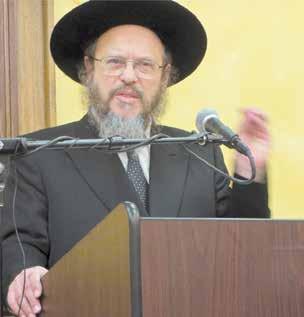
The sweet sounds of the Gemara reverberate loudly throughout the Beis Medrash with the usual Riverdale grandeur. Rows of bachurim are swaying back and forth with intensity, completely enveloped in the sugya. Suddenly, a bochur bursts in, confused and anxious, and cries out, “Someone should get up and say Tehillim!”
Without knowing who or what, us bachurim begin reciting “Shir Hamaalos” and “Lam’natzeiach.” Did something happen to the Rosh Yeshiva, chas v’shalom? we are wondering with mounting anxiety. No, it couldn’t be. Why, just this afternoon the Rosh Yeshiva had given us a brilliant shiur on Tosfos in Perek Meruba, with his typical vigor, lomdus and depth.
Something terrible must have happened in Eretz Yisroel, we conclude. Therefore, we say “Acheinu” with fervor and dive right back into the Gemara.
Minutes later, emergency vehicles are spotted in the yeshiva’s parking lot, prompting us back to our Tehillims a second time. The awful murmurings were already spreading, “Rosh Yeshiva, Rosh Yeshiva…”
Two kapitlach later, a Hanhala member walks in and announces a mournful, “Kohanim zollen arois gein!”
The kohanim leave, and immediately the rest of us collapse, bawling like small children.
“Nafla Ateres Rosheinu”
How could it be? Our beloved yet revered leader, the one who had planted us, nurtured us, and built us. To whom can be attributed our hasagos in Yiras Shamayim,
our avodas ha’tefillah, and most notably, our derech in limud haTorah.
And now, suddenly, no longer.
I think back six long years ago, to the day I entered ninth grade. How far I have come since then.
My davening: as in, step number one, according to the Rosh Yeshiva…is to get out of bed on time! “A bed is a bochur’s palace,” he would say, “zug nein tzu der yetzer hara, un gei arois fun dein palace!”
“Modeh ani l’fanecha. Thank the Abishter that you can get up in the morning. Nisht alle kenin oif shtein!”
“Birchas HaTorah – remember that it’s the Abishter’s Torah, and through it, we come close to Him!”
Pesukei D’zimra in Yeshiva are always loud and always provoke feeling and awe. “What a zechus we are given to be able to sing praises of the Ribbono Shel Olam, what an incredible joy!”
Onto Birchos Kriyas Shema: for me, they have taken on a whole new meaning after hearing the Rosh Yeshiva repeatedly depict the awesome scene of the Seraphim and Chayos Hakodesh praising Hashem with kedusha and tahara.
And no matter where I will ever daven, the voice of the Rosh Yeshiva being mekabeil ol malchus Shamayim will always thunder in my head.
The Rosh Yeshiva changed our Shemoneh Esrei with the story of “Itzick the Schneid,” who, after entering the Telzer Beis Medrash in Lita and seeing Rav Yosef Leib, zt”l, davening Shemoneh Esrei, couldn’t help but cry out, wow! “Er ret duch mit em alein” – he is actually speaking
with the Ribbono Shel Olam himself. Reb Dovid Goldberg, Rosh Yeshivas Telshe, Cleveland, mentioned at the levaya that witnessing the Rosh Yeshiva’s Shemoneh Esrei made us all feel like “Itzick the Shneid.”
Unlike most yeshivos, it simply wasn’t realistic to wait for the Rosh Yeshiva to finish Shemoneh Esrei, as he would usually be davening for well over twenty minutes! Rather, the Chazan would say Kedusha extra loud so the Rosh Yeshiva could be yotzei via “shomea k’oineh.” He would gather talmidim every few days to tell them a new darher he was mechadeish in tefillah. The Rosh Yeshiva was a living example of why Chazal call tefillah an avodah.
The Rosh Yeshiva’s crying and choking up whenever the Beis Hamikdash and Yerushalayim were mentioned in tefillah or in a shiur daas gave me a connection to galus and the Churban that I don’t believe I would have ever gained without witnessing these feelings that were from a different generation.
Rav Shmuel Rozovsky, zt”l, said at Rav Chatzkel’s, zt”l, levaya that from Rav Chatzkel’s kapittel Tehillim one could become a baal teshuva. The same can be said from just one kapittel Tehillim said by the Rosh Yeshiva. It wasn’t said; it was lived.
Every Motzei Shabbos, the Rosh Yeshiva would give a shmooze, the shmooze which contains the secret as to where the Yiras Shamayim of his talmidim come from.
The Rosh Yeshiva lived by the pasuk in Mishlei, “V’ohavo shicharo mussar ” – that when one truly loves someone, he raises him with mussar. It is through this exact princi-
ple that he produced shining stars in the worlds of Torah and Yiras Shamayim.
“The Rosh Yeshiva is bullets,” said one of his sons in explaining his koach to give mussar. He was able to hit the target on the bullseye every time by zeroing in on just the nekudah that needed to be fixed. His descriptions of the yetzer hara were terrifying: an angry gorilla, a “blub of dirt,” a horse, that wants nothing more than ga’avah, teivah, and kavod. But then he would continue by explaining that we shouldn’t feel bad. “Avrohom Ausband has the same wants and desires, but he wants to give them a kiss, because by overpowering them, I am getting Olam Haba – zug nein to the yetzer hara!”
His chashivus for a life of Torah, coupled with his disgust for the “gos ” – the street, for those who live their life as one big money chase – was a focus in all shmoozen. He would scream, “We didn’t come to this velt tzu machin gelt.”
He would say that in Europe the nisayon was the Haskala, while now the nisayon is to “enjoy life.” This was a term that upset him the most: “Enjoy!” “Don’t tell us to enjoy, we didn’t come to this world to enjoy, but rather to be mekadeish shem Shamayim” was his message. It taught us we are not just “Americaners” but rather “bnei Torah which live for one tachlis – l’sakein oilam b’malchus Shin-Daled-Yud.”
The Rosh Yeshiva would say over on Chuf Tammuz, the yahrtzeit of Kedoshei Telz, the famous memra from his grandfather Rav Yosef Leib, zt”l , who would walk over to the cradle of every child after birth and say, “If you live for kavod Shamayim, then you are needed, and
if you aren’t going to live for kavod Shamayim, you aren’t necessary.” That was how the Rosh Yeshiva lived his life on a daily basis – only for kavod Shamayim. Rebbi, how much we grew from those shmoozen! The amount of hours the Rosh Yeshiva would spend on a question in the sugya was unfathomable. It wasn’t
oilam had an answer. Many times, the oilam would come close but were missing a lot of the kneitzin and lomdus “Nu, zug besser,” the Rosh Yeshiva would demand. Finally, the Rosh Yeshiva would say, “The pshat is” and would go on to explain the vort with extreme clarity.
enough just to learn; he taught us to “horve in learning.”
It could be his tenth time learning the same Gemara, but he would still come across difficulties that wouldn’t allow him to give shiur that day. It was always with a frishkeit and emeskeit of that of a young bochur. When he would find an answer, the simchas haTorah was palpable. He would come into shiur and ask a question and see if the

Chazaras hashiur wasn’t limited to sedarim. There was fighting that could be heard at lunch, supper, and throughout the hallways of Yeshiva all day regarding what the Rosh Yeshiva had truly meant with every kneitch. The doubts were later clarified after Maariv when we would have the zechus to crowd around the Rosh Yeshiva in what the bochurim had nicknamed “Huddle.” The milchamto shel Torah was unreal! Names like “am haaretz!” and “shoite!” were fired as the Rosh Yeshiva ripped apart the questions of the best bochurim with his special clarity and havana . He would use a much quieter tone when addressing the newer bochurim who needed to be drawn in. That was part of the Rosh Yeshiva’s koach in being mechanech each bochur al pi darko. After a big vort was said, there would be an overpowering uproar until things calmed to allow for the next question. We would gain a passion and fire in learning as we were led by our leader who was on fire from the aish haTorah. After “Huddle,” the bochurim would separate into different groups to dissect every vort the Rosh Yeshiva had said.
How will our shiur be able to learn Yevamos next year without the Rosh Yeshiva’s havana in the issur eishes ach? We all lost a Rosh Yeshiva not only for the next two years in Yeshiva but a mentor for life.
“Mi yiten lanu temuraso.”


By Barbara Deutsch
Idid not grow up with summer camp, ski vacations, or cross country travel as vacation. As immigrants, my father struggled to put food on the table by working every minute he could as a salesman. He wanted to be a doctor, but the war stopped him in his tracks.
My mom was busy raising the children – that’s how it was in those days – and when we three were in school, she found work in a hot and steamy sweater factory.
One of the happiest days of her life was her last day in that place.
I never felt that I missed out because all my cousins and friends were in the same situation as I was, and you don’t miss what you don’t know.
As I got older and my world expanded, I learned that there was such a thing as a ski vacation and that people traveled far and wide for the best snow.
When my husband and I found ourselves able to afford a short family winter vacation with our kids, we went with a close circle of friends to the Catskills luxury resort, the Concord.
There, we found great food and snow. The problem we encountered was no skis and no skills. The Concord provided both. The very first day, all of the grownups and the kids lined up to be fitted for skis, and everyone enrolled in ski school. In short order, the kids were off, a bit wobbly but determined.
After much ado about size and fit, Bob and I were relegated to the class below beginners. I think it was a toddler’s class, but they too were soon on their way. No matter how hard we tried, we could not make it up the snowy hump between the shack that supplied the skis to the gate entrance.
We failed even before we started, never to slap on any skis again.
Since we arrived in Israel almost two months ago, we have been trying to make sense of our new surroundings and the opportunities. We are open to trying the new and becoming more comfortable with the familiar.
For a recent Nefesh BNefesh event for new Olim families, we went to their mag-
nificent space in Cinema City in Jerusalem. As the hour was late and the kids’ party was winding down, we were greeted by older Olim peers in our advanced age category. It was surprising to us to see how many people there are who have made aliyah as singles and older.
There is more to share about that.
Everywhere we go – stores, parties, buses, walking in the street or whatever – when people hear we are new Olim, they stop, make eye contact, smile and say mazal tov.
Now that we have accepted the three rules for getting questions answered or given guidance in Israel, we are in a better place. Steps: 1) ask politely; 2) scream (we are told this shows strength); 3) cry!
So far, we have tried 1 and 3 and have not resorted to 2, although tempted many times.
Attitude is the most important element to success. Our friend Eddie (he and his
used on the apps; we have not figured that out yet and are hoping to find out at Ulpan.
Everyone we share our navigational adventures with tells us the same thing: “What do you expect? It’s Israel, and that’s the way it’s done here.” Everyone also says, “We love it anyway and would live nowhere else.”
Here are two stories from just this week.
We went to an outdoor klezmer concert in Yad Vashem; we traveled by light rail, shuttle bus and foot. The view from the mountaintop surrounded by artifacts of despair infused with the haunting klezmer sound made it a night we will long remember. Yet, that was not the most significant part of the night.
As the sun set, a call for Maariv went out. In no time, more than a hundred men gathered in prayer in the back of the concert garden.
That’s Israel.
Everywhere we go – stores, parties, buses, walking in the street or whatever – when people hear we are new Olim, they stop, make eye contact, smile and say mazal tov.
wife Dora came in May and as a result are so much senior to us in experience) met an old friend at the party for Olim who ironically arrived on our early July flight. His response when asked how it’s going: “Lousy!”
Not simple, yes, but why lousy?
One of our aliyah advisors, Liz, came over to check in with us at the party, “How’s it going?” we told her that our biggest glitch so far was figuring out the bank. Her response, “Don’t go unless you have to. Use the app!” She invited us to stop by the office, and she would help us figure it out.
The major problem is that even when you learn Hebrew, it’s not the language

of getting it back to him as I did not have a name. I figured we would meet again, and I would be able to return it when we did.”
That’s Israel.
The new school year has begun; there is so much to teach and for everyone to learn. It gave me so much pleasure to see the boys and girls at their bus stops, dressed in their new uniform shirts and blouses with pin holes still visible, waiting for their buses on the first day of school. Knowing that their brothers and sisters in America are dressed in blue and white in solidarity with them gave me such a warm feeling.
Our Israel family was brought to its knees this week when the reality of six hostages, among them the American hostage Hersh, were murdered days within rescue.
Just days before, the image of his mother Rachel screaming encouragement into the Gaza desert flooded the airwaves.
Liz told us a story about her visiting brother. The family was in a cab touring Jerusalem when he lost his special hat. Somewhere along the way, he lost it. It was upsetting but these things happen and so he went home without it. Many months later, Liz’s mother was exiting a cab when the driver asked her if she had a son who had visited lately. Her response was, “Yes, why do you ask?”
The Israeli cab driver answered, “A few months ago, I was driving a family around Jerusalem; the son was wearing a distinctive hat. When I got home, I noticed that he had forgotten it in the car. I had no way
Despite flunking out of ski school all those years ago, we are not quitters. It is our determination to make the most of every single day we get to live in Jerusalem. We are Israeli Jews, and that’s what we do!
Barbara Deutsch is the former associate principal at HANC, middle school principal at Kushner, and Dean of Students at Yeshiva of Flatbush. A not-retired educator, she is trying to figure out life in Israel through reflections on navigating the dream of aliyah as a wife, mother, grandmother, great-grandmother and friend.

The election is less than 60 days away, and Tuesday night was the first time that both candidates faced each other on stage to answer questions that the American public demands. But both Vice President Kamala Harris and former President Donald Trump hardly gave the nation substantial policy rhetoric while standing behind their podiums. Instead, much of the 105-minute session was filled with barbs, snide remarks and platitudes – a “nothing burger” without any real substance that could sway voters. Harris clearly was prepped for the debate. She answered her questions and filled her replies with lots of remarks designed to enrage Trump. That was her goal: to get him unsettled. And Trump took the bait. She told him that world leaders were laughing at him and called him
By Avi Herz

a “disgrace.” She said he was “weak” and “wrong” and told him that 81 million vot-

ers fired him in last election – the number of people who voted for Joe Biden in 2020. Viewers were disappointed that Harris, when she finally spoke to voters, was clearly unsure of her policy. True, she seemed more calm than Trump, but she was also evasive and vague about her planned policy for her upcoming administration. The moderators hand-held her throughout the debate, showing their bias for the Democrat candidate. Indeed, Trump quipped that there were three people at this debate: Trump, Harris, and the moderator.
“The ABC moderators were not journalists, they were pro-Kamala activists who baselessly attacked President Trump leading to a 3 on 1 debate, while allowing Kamala to lie repeatedly,” House GOP Conference Chairwoman Elise Stefanik, R-N.Y., said after the debate.
Although the debate covered many topics, the subject of cats came up repeatedly. When talking about illegal immigration, Trump said that migrants were eating Americans’ pets.
“They’re eating the dogs, the people that came in, they’re eating the cats, they’re eating the pets of the people that live there,” Trump said, after Harris criticized him for tanking the immigration bill.
Harris seemed puzzled by Trump’s remarks and said that his claims were untrue.
ABC News moderator David Muir added that city officials denied any evidence
that migrants in Springfield, Ohio, were actually eating pets. Trump, though, noted that people were saying that it was happening, concluding, “We’ll find out.”
Both candidates battled it out on the topic of abortion, with Harris seeming sympathetic to women’s struggles. She said that IVF treatments were in question. Trump, in response, said that the question of abortion is now up to the states – and not to the federal government.
“Now it’s not tied up in the federal government,” Trump said. “I did a great service in doing it. It took courage to do it.”
When asked if he would veto a nationwide abortion ban, he repeated that the topic is up to the states to decide and not the federal government. He also maintained that he is a big supporter of IVF treatments.
Harris claimed to be an advocate for middle-class voters.
“Donald Trump has no plan for you,” she said in response to a question on the economy, looking into the camera in a direct appeal to voters. She called herself a “middle class kid” and said that she would provide tax cuts for families and small businesses.
“I will tell you, the one thing you will not hear him talk about is you. And I’ll tell you: I believe you deserve a president who actually puts you first,” she said.
But Trump told voters that all they have to do is look back a few years at the economy and see how he will benefit the American people.
“I created one of the greatest economies in the history of our country,” he said.
Trump tied Harris to President Biden and his administration, pointing out that she served as Biden’s vice president for four years.
“She is Biden,” he said.
“The worst inflation we’ve ever had,” Trump added. “A horrible economy because inflation has made it so bad. And she can’t get away with that.”
Harris responded, “Clearly, I am not Joe Biden, and I am certainly not Donald Trump. And what I do offer is a new generation of leadership for our country.”
Trump noted that Harris has been striking a more moderate tone in this election, in contrast to the progressive positions she took in the 2020 Democratic presidential primary.
“She’s going to my philosophy now,” Trump said, pointing out that Harris has adopted some of his policies. “In fact, I was going to send her a MAGA hat. But if she ever got elected, she’d change it.”
Turning to international politics, the two battled it out on the topic of the war in Gaza. When asked by the moderators how Harris would secure a hostage-ceasefire deal and about her remarks from months ago that “Israel has a right to defend itself, but it matters how,” Harris, in her typical style, started by explaining how the war in Gaza was triggered.
“And so, absolutely…Israel has a right to defend itself; we would,” she said. “And how it does so matters, because it is also true that far too many innocent Palestinians have been killed, children, mothers. What we know is that this war must end, it must end immediately, and the way it will end is we need a ceasefire deal and we need the hostages out. So we will continue to work
around the clock on that.”
She insisted on charting a course for a two-state solution, which she said should ensure security for Israelis and “in equal measure” for Palestinians.
Trump said he would negotiate with Prime Minister Netanyahu and Hamas to free the hostages and to prevent more killings in Gaza. He added that the war
her own way, she hates the Arab population, because the whole place is going to get blown up: Arabs, Jewish people, Israel. Israel will be gone,” Trump went on. “It would have never happened. Iran was broke under Donald Trump… Iran had no money for Hamas, or Hezbollah or any of the 28 different spheres of terror… horrible terror… they were broke.
That was her goal: to get him unsettled. And Trump took the bait.
wouldn’t have started on his watch and said that Harris “hates Israel.”
“She wouldn’t even meet with Netanyahu when he went to Congress to make a very important speech. She refused to be there because she was at a sorority party of hers… She hates Israel. If she is president, I believe Israel will not exist within two years from now,” he claimed. “I’ve been pretty good at predictions, but I hope I’m wrong on that one.”
He continued, “At the same time, in

“Look at what’s happening with the Houthis in Yemen. Look at what’s going on in the Middle East. This would have never happened. I will get that settled and fast.”
Asked to respond to Trump’s claim that she hates Israel, Harris said, “That’s absolutely not true,” describing herself as a lifelong supporter of the Jewish state.
Trump noted that the war in Ukraine wouldn’t have happened if he was in the
White House.
Harris said, “It is well-known that these dictators and autocrats are rooting for you to be president again,” Harris said, “because it is so clear they can manipulate you with flatter and favors.”
Trump fought back there, recalling his push to get NATO member nations to pay more into the alliance and slamming Harris for Biden’s refusal to do the same, before saying the vice president “does not have the courage to ask.”
Trump repeatedly brought up the dismal withdrawal of the U.S. from Afghanistan. He said he would have fired the generals in charge, as it was such a disastrous decision, one that occurred under Harris’ watch.
Trump brought up Hungary’s Prime Minister Viktor Orban.
“Orban said it, he said, ‘The most respected, most feared person is Donald Trump. We had no problems when Trump was president,’” Trump said.
According to a flash poll conducted by CNN after the debate, about 6 in 10 debate-watchers said that Harris outperformed Trump, while about 4 in 10 said that Trump did a better job. Before the debate, the same voters were evenly split on whether Trump or Harris would win.


By Samuel Haft as related to Barbara Bensoussan
My story begins back in 2012, as I was finishing a degree in accounting at Lander College. I was learning with my chavrusa, and after a few hours, I began to feel my voice getting tired. We paused for a bit and resumed learning afterward, and I didn’t think much of it.
But as time went on, I began experiencing voice fatigue more and more, with all my chavrusas. I would have to either take a break or ask that they do all the reading so I could rest my voice.
I had always loved singing in synagogue and the Shabbos table, and now I couldn’t sing as well as I used to.
“It looks like Hashem is taking away my singing voice so that I’ll have to start actually paying attention to the words,” I joked.
At first, I thought I was simply suffering from a winter cold, but as time went on, things escalated to the point where it hurt to say anything. When learn ing with my chavrusas became impossible, I knew I had an issue.
Soon, things got worse. My voice was so vulnerable that if I overused it at any point during the day, I would need to rest it for three days to recover. And it affected me in so many ways, big and little. Sometimes, people wouldn’t hear me well, and I’d simply agree with them rather than have to answer them. When I asked the gas station attendant for $25 worth of gas and he said, “I didn’t hear you, did you say $35 of gas?” I just nodded; it was easier that way.
“I’d like the chicken burger,” I’d tell a waiter when going out to eat, but when he repeated, “Did you say the beef burger?” I’d just resign myself to that.
pists, hoping they would have the answer, but none of them were able to fix the problem long term. In 2017, I met a dentist who believed the problem was due to a jaw misalignment that affected my nervous system, and that the braces and retainer I wore growing up may have wreaked havoc with my body that would take years to undo now (it may be that the braces were not done properly or that my body just didn’t react well to them). He seems to have come closest to truly understanding the root of the issue. Since starting his protocol, wearing an orthotic on my bottom teeth that the dentist adjusts every few months to move the jaw into better alignment, I’ve begun feeling stronger and better overall, and I’ve been working with him with him ever since.
As the situation progressed, I found myself unable to speak for more than a few minutes, which was obviously terribly disruptive
25 women there, and the idea was to spend two or three minutes with each one before moving to the next person. I made it past the first woman, but by the time I got to the second one, I literally couldn’t speak anymore. The poor woman saw I was struggling, so I had to tell her, “I just can’t do this anymore” and leave. Today, when I think back on it, it’s kind of comical that I wasn’t able to last even five minutes, but at the time, I was mortified.
My vocal challenge hit me unawares, but in retrospect, I can see that my childhood and upbringing had prepared me with the endurance I’d need to face this trial. Even as a child, I’d forged the strength of character to insist on getting where I wanted to go.
I grew up in a Modern Orthodox family in Woodmere, New York, a middle child with three sisters. A popular, athletic kid who achieved high marks, I attended Hebrew Academy of the Five Towns and Rockaway (HAFTR) elementary school and then Davis Renov Stahler Yeshiva High School (DRS).

Of course, my lack of voice went much farther than just affecting my gastronomical options. I never knew in advance if I’d be up to a visit from a friend or going out on a date. A few times people hit or scraped my car (nothing major, thankfully), but I just waved it off; the alternative – a long discussion and an exchange of phone numbers and insurance information – was beyond my abilities.
Between 2013 to 2015, the problem came and went. After graduating, I’d taken a job as a CPA, where I managed to get by; fortunately, the work didn’t require too much speaking to people. I wasn’t able to socialize much, but I could still have a 20-minute phone conversation or a one-hour face-to-face conversation.
I consulted doctor after doctor – I must have gone to 20 different ones over the years – but no one could get to the source of my problem. “It’s a vocal cord issue,” said one doctor. But the medicine he prescribed didn’t help. “Allergy-related,” said another, but the meds he prescribed didn’t help either. “It might be psychological,” said a third, but the psychologist I saw at his urging was also a dead end.
I didn’t stop there. I visited many speech thera -
As time dragged on with no solution in sight, I became like a boxer in a ring who has been punched so many times, he loses the will to get off the mat.
embarrassment at being unable to respond to people who addressed me led me to start avoiding people. Even when friends and family would text me, I ignored them. I simply couldn’t relate to others who weren’t suffering; I felt that we spoke different languages.
When I went to synagogue, I would closet myself in the women’s section so that I would remain unnoticed and could avoid speaking to anyone. At work, I’d avoid my colleagues and find ways to get around assignments that required a lot of speaking. I would avoid entering a crowded elevator with people I knew, preferring to wait for it to empty or at least to hold people I didn’t know (and didn’t have to speak to).
As a 24-year-old, I wanted to date, but the voice issue made it so challenging. I had to keep dates short because my voice would give out. Unless I had a really exceptional first date, I wouldn’t be motivated to go out a second time. A number of times I became so frustrated that I couldn’t express myself properly, it ruined the whole experience for me.
I once made the mistake of attending a speed dating event in New Jersey. There were probably about
Before high school, I didn’t learn much Gemara or have any particular rebbi, so DRS gave me my first exposure to this approach to learning Torah. As ninth grade progressed, I found myself drawn more deeply to religion. My mind had begun to mature, and I began to think more deeply about the big questions: Does G-d exist, and if so, how do we serve Him? What is the proper way to live? It was the first time I began questioning my life and trying to identify the source of happiness. Exposed to American media such as television, Hollywood movies, and People magazine, I saw that secular society revolved largely around seeking pleasure and the “good life.” Yet I also perceived that the achievement of such “good life” goals like status and popularity were uncomfortably out of my control.
Within the framework of Judaism, on the other hand, my goals were much more attainable simply through exercising my own willpower and effort. I was the one who determined how much time and effort to put into praying, learning Torah, and performing other mitzvos, and this gave me a handle on my success.
This epiphany, coupled with an exposure to real learning when I studied with an older high school student who was a serious learner, led me to become much more religious. When ninth grade ended for the summer, I would ride my bike every day to shul to learn by myself or with a chavrusa, and I really enjoyed it. I was supposed to spend that summer in Los Angeles with my grandparents, which would have almost certainly led me to hang out with the wrong type of crowd, but at the last minute, I changed my plans and decided to attend the NCSY Kollel, a learning program for Modern Orthodox teenagers that solidified my new religious direction.
After a year in DRS, my high school trajectory was unexpectedly interrupted. One day, while sitting in the car with my father, he brought up a startling idea.
“Now that I sold my business, your mother and I were thinking of moving to Israel,” he said. “You know it’s something we always wanted to do. But we don’t want to go if it will make you unhappy. What do you think?”
“Actually, I would be open to it,” I responded. “I’m more religious now than most of my crowd at school, and it would be easier to start at a new school that’s closer to the level I’m at.”
My father flew with me to Israel to check out high schools, and I wavered between two schools, one more modern and the other more yeshivah-style. When I got home, though, I met “by chance” a Chofetz Chaim talmid who exposed me to his yeshiva – my first experience of a “real” yeshiva. That propelled me to choose the more right-leaning Nehora high school in Mevo Choron with my parents’ support.
We stayed in Israel for just a year and returned to Woodmere when I was 16 and entering eleventh grade. By this point I was a serious Torah student who needed a serious yeshiva. I enrolled in Yeshiva of Far Rockaway, where I was very much an anomaly because the vast majority of my peers had come from ultra-Ortho dox backgrounds, but I was happy just to be pursuing my own truth and happiness and didn’t care much if I stood out as different.
When I went back to Israel at age 18 to continue my learning in Yeshivat Kerem B’Yavneh, I found myself back among guys like me – people who had grown up in Modern Orthodox homes but were serious about learning. I had the good fortune to learn under Rav Menachem Mendel Blachman, who left a very deep impression on me. He is famously demanding of his students, and in my two years there, he taught me how to think and gave me the confidence that I had the ability to think things out on my own.
His talmidim need a thick skin to handle his sometimes-brusque manner, which he adopts for the purpose of chinuch, but I loved the challenge. (He himself likes to say, “I’m a poodle at home, but a Rottweiler in yeshiva!”) In fact, the few times I was able to win an argument against him were life changing. They infused me with self-confidence and the faith that I really can think deeply and logically.
lem, my family suggested I move to California, near my grandparents in Los Angeles. As I’d never liked the pressured pace of New York or the cold winters, I easily acceded. In the summer of 2015, I transferred jobs and moved.
I was hoping my condition would improve, but not only did it not, but I also developed other medical conditions such as IBS and some gum recession, unusual for someone my age. Doctors weren’t sure if these were related to my voice issue or not, although surely my mental stress must have left me more vulnerable to developing physical disorders.
On the marriage front, things weren’t going so easily either. I tried some long-distance dating through Skype. Once I met a woman three times and thought things were good enough to continue, and the shadchan proposed that I fly out to meet her.
“I don’t know if I can do that,” I said. “I’ve been dealing with this voice issue.”
“How can we help?” they asked. But what could they do? They couldn’t give me a voice, and they were just as clueless as I was. People had good intentions, and many tried to communicate by texting, but I was so tired of not having a voice that I lost interest and sent only very brief responses. The two years from 2016 to 2018 found me suffering literally in silence. Drained by isolation, I reached a psychological breaking point. I can’t say I was suicidal, but I definitely would have felt relieved to go to bed and not wake up the next morning. During the first four years in New York, I thought the problem was temporary, and that gave me hope and the mental fortitude to keep going. But as time dragged on with no solution in sight, I became like a boxer in a ring who has been punched so many times, he loses the will to get off the mat.

By defining happiness differently – as a life of balanced serenity and avodas Hashem –I could be eligible for happiness.
After two years in Israel, I enrolled in Lander College in Queens, New York, with a major in accounting. Here, as at Kerem B’Yavneh, I was among my own kind, other young men who had grown up in more Modern Orthodox homes yet had veered toward deeper levels of observance. My path forward seemed clear and straightforward. I would be graduating college in September of 2012, qualified as a CPA, and I would start to date.
Then, out of the blue, I started losing my voice.
After three years of struggling with the loss of my voice in New York, I needed a change. When I was told that perhaps a warmer climate would help the prob -
“Well, if you don’t feel you can handle that, maybe you should take a break from dating altogether!” she responded.
It was a bitter pill to swallow, but by 2016, at age 27, I concluded that my dating life would have to be put on hold indefinitely until my voice issue was resolved.
By now I had been dealing with voice loss for four years. As the years passed with no resolution in sight, I began to despair. I was terribly lonely and cut off, even spending Shabbosos and yamim tovim in isolation, davening in the ezras nashim on weekdays to avoid contact with people and sometimes walking a few miles away during yom tov to a shul where everyone spoke Persian. At one point, I was eating Shabbos lunch in a shul that offered a large kiddush with challah, but I’d go only at the very end, when the crowd had left and the janitor had begun cleaning up. It turned out I wasn’t the only one who waited. I was joined by a few homeless people, with whom I felt a kinship, since we were all cut off from “normal” society.
My family was deeply concerned for me.
We’re all social creatures who need contact with other humans. My Hebrew name is Yaakov, and I often thought of the pasuk, “Vayivaser Yaakov levado” (Bereishis 32:25), describing how Yaakov was left alone, wrestling with a malach. My inability to communicate left me bereft of human contact, and I was becoming terribly lonely. The isolation and pain in my life so outweighed the positive, I felt little motivation to wake up in the mornings. I continued to work, because I knew that going to work was the only way I was going to survive. Simply staying home in that mental state would have been dangerous. Somehow, we human beings are wired to keep going even under the most trying circumstances – my 95-year-old grandfather, may he be well, survived the Holocaust – yet, I knew my situation was untenable. I had to find a path forward or perish spiritually and emotionally. Fortunately, I had always been a truth seeker and a deep thinker. Desperate to find answers, I began to delve into Jewish and secular sources to figure out how I could be happy in my imposed silence. I listened to TED talks about philosophies like stoicism; I read Viktor Frankl’s Man’s Search for Meaning and Rabbi Akiva Tatz’s Letter to a Buddhist Jew. I started to learn Shas again, starting from the beginning, and read volumes of Torah hashkafah such as the Chovos Halevavos, Rambam Hilchos De’os, Mesilas Yesharim, Derech Hashem, Tanya, Michtav M’Eliyahu, Rav Aharon Feldman, Rabbi Dovid Gottlieb, Rabbi Lawrence Kelemen, and more.
It’s one thing to theorize and pontificate about happiness when it’s an abstract issue, and another to dive into the topic because it’s your own life that’s on the line. I was desperate for answers.
Yamim tovim were extremely challenging, because I spent them alone and couldn’t pass the time listening to podcasts or classes; a three-day holiday seemed interminable. Ultimately, I realized they were beneficial, because the time I spent home alone allowed me to delve deep into my thoughts.
And then, during one three-day Shavuos, I arrived at a paradigm shift that changed my entire view of happiness.
That Shavuos morning, I davened at home, and after I finished, I went for a walk. It was a gorgeous day, sunny, and as I walked, I thought, This is crazy, but I feel pretty content!
Even in the midst of all that silence of the threeday chag, I realized, I was also not suffering the emotional pain that comes when the pursuit of pleasure is thwarted.
“Who’s to say the life I’m living is a bad one?” I asked myself.
I had been relying on the secular definition of happiness, which characterizes happiness as pleasure where one’s goal in life is to maximize all experiences that bring pleasure. According to this worldview, fun, comfort, excitement, financial success, status, popularity, and so on are the things we strive to attain. As my lack of a voice precluded me from attaining most of these things, I could not be happy according to this school of thought.
My sudden clarity enlightened me: taking myself out of the running for goals like status, popularity, and fun also meant I was spared the kind of anxiety, wor ry, frustration, and dissatisfaction that are the conse quences of valuing these goals and failing to achieve them. Retreating from goals that are, ultimately, only superficial forms of happiness meant that I suffered no disappointment when they didn’t come through for me. There is an emotional cost to pursuing pleasure – it always comes with strings attached – and that cost is emotional suffering in the form of anxiety, disappointment, and emptiness.
Which life is better? I asked myself. Is it better to live life on an emotional rollercoaster, experiencing the highs of fun, comfort, and excitement along with the lows of anxiety, worry, and disappointment? Perhaps it is better to eschew that volatility and pursue a more emotionally neutral life of serenity, contentment, and peace of mind (in Talmudic language, yishuv hadaas or menuchas hanefesh). For me, a serene life is better than a life spent frantically chasing emotional highs and physical pleasures. By defining happiness differently – as a life of balanced serenity and avodas Hashem – I could be eligible for happiness.
us in life. We can put int our best efforts, but in the end, it is only G-d who determines if our efforts bear fruit. There are attractive, kind people who never find a spouse while unexceptional people do; some athletes fall ill while some smokers live long lives; smart people lose fortunes whereas others become rich simply by being in the right place at the right time. It is surely futile to invest ourselves emotionally in pursuing goals that are often not dependent on our own efforts. By striving for mental equilibrium and a life of effort and service, we bypass reliance on external circumstances to make us happy.
Once I made that paradigm shift, my life changed. Little by little, I was able to stop worrying about whether I’ll recover fully, or if I’ll be able to hang out with friends or marry and have children. I focused on maximizing learning and service rather than pleasure per se. I replaced my old diet of pizza, burgers and cookies with sprouted wheat bread and vegetables and chicken, exercised more,
Is it better to live life on an emotional rollercoaster, experiencing the highs of fun, comfort, and excitement along with the lows of anxiety, worry, and disappointment?
Yechiel Perr, zt”l, Rav Moshe Brown, Rav Mordechai Willig, and Rav Akiva Tatz. I even heard from some of them, “This piece of Torah has been somewhat lost due to the heavy influence of secular values, but you should revive it.”
My parents had once spoken to a kabbalist about my situation, who told them, “Rest easy, he is going to save lives.” None of us had any clue what that meant then, except that perhaps my ideas could help people with depression and emotional problems. But when I showed my ideas to Rav Blachman, he commented, “They are pikuach nefesh tzibburi,” and I realized I could also help people who are struggling spiritually.
Yes, sometimes, we do need to give ourselves breaks and indulge in pleasurable activities just to rest and refresh. But like the basketball player who drinks Gatorade on the side so he can get back on the court with renewed vigor, a bochur who has been spending many hours learning might need to rest his brain by listening to music or a mother might need to relax with a cup of tea and a novel after finally getting her children settled for the night. In all these cases, the recharging plays second fiddle to the primary goal.

of shiurim and reviewing my learning.
Even without a voice, even being cut off from most people, I could find my own path to happiness and emotional health.
Most people want to maximize pleasure and minimize effort. From my new point of view, the goal became completely inverted: to maximize effort and minimize pleasure. Effort now becomes valuable, while pleasure is merely a fortuitous, but not guaranteed, byproduct.
I began to analyze all areas of life according to this new criterion. Take marriage, for example. If my goal is to get married, I won’t be happy until I find a mate. But if I’m focused on mental equilibrium and striving to serve G-d and others, I can be happy even if I do not marry. Maybe I can stop worrying about not getting married, I told myself.
We have very little control over what happens to
Realizing I was still eligible for happiness under my new definition felt like a rebirth. Even before my losing my voice, I had always had a goal of figuring out what was meaningful in life and what constitutes happiness. Now I felt a great sense of accomplishment knowing I had gained so much clarity and achieved this new level of understanding.
I became very absorbed with working through these ideas, and starting in 2018, when I first conceived them, I began many email exchanges with friends and rabbis. I went back to Jewish sources, and found that my theory is actually the Jewish approach to happiness. Pirkei Avos states that the wealthy man is the one who is content with his lot, regardless of his circumstances (the Alei Shur elaborates on this in Happiness from a Torah Perspective).
I was encouraged when I received haskamos from such distinguished rabbanim as Rav Blachman, Rav
My isolation has given me the perspective to see what really matters and what really makes us happy. My original impetus to become more religious – the realization that worldly pleasures aren’t under my control, but spiritual fulfillment always is – turned into a full-fledged, well-developed hashkafah as a result of my personal trials.
People say, “You’ve been in isolation so long. I feel so bad for you!”
But I respond by saying (writing, really), “Just the opposite – I feel bad for you, in a way, because your attachment to the pursuit of pleasure takes you out of This World and the Next!”
I feel a little like Yosef Hatzaddik, l’havdil, who told his brothers, “Don’t worry, I was sent on this difficult path so I can now offer you support.”
I know that personal accounts often finish with a happy ending, tied up in a bow. Mine doesn’t. I don’t know what the future holds in store. I pray to Hakadosh Baruch Hu that my voice will be restored completely, that I’ll get married and have children, and live an otherwise “normal” life. But I know that even without these things, I am still eligible for the greatest life in This World – one of serenity and self-development – and the greatest life in the Next World.
The author can be reached at haft2115@gmail.com
This article originally appeared in print in the Mishpacha Magazine. Reprinted with permission.
After spending a decade in isolation, Samuel Haft has developed a philosophy on happiness that has been endorsed by rabbinic leadership and is now disseminating throughout the world to promote authentic Jewish practice and emotional well-being in today’s society. He can be reached at haft2115@ gmail.com.

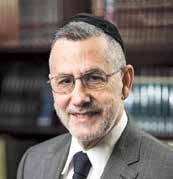
By Eliyahu RosEnBERg
magine you’re walking down an aisle at your local supermarket, pushing along an empty shopping cart as you scan the shelves for a food item you’re not so familiar with. After a moment or so, you spot the item you’re looking for, grab it, and give it a good look before dropping it into your wagon. You scan the front of the package, the back, and the sides until you spot a tiny symbol – what we call a hechsher – in one of the corners. Content, you drop the item into your cart and con-
tinue shopping.
For Orthodox Jews around the world, the instinctive “search for the hechsher ” task is perhaps one of our most relatable modern-day rituals. And it shows in the way we talk. “Does that have a hechsher?”
“I don’t hold by that hashgacha.” “I didn’t buy it, because I didn’t see a hechsher.” “Does that even need a hashgacha?”
As frum Jews living in the twenty-first century, it’s easy to take hechsherim for granted. We rely so heavily on reliable ko -
Talmud Torah k’neged kulam. That is what defines us.
The study of Torah is what makes the Jewish people unique.
Vision is an essential ingredient of leadership. a s the scriptures tell us: Where there is no vision, the people perish.
abraham l incoln represents the very best of the united states. of course, he did a lot to transform the united states. a nd, to me, he always had a certain Jewish quality to him. First of all, he grew up with basically no education…but he wrote the greatest prose in a merican history. he was a man of such wisdom and principle. We can all learn from abraham l incoln.
sher certifications (such as the OU or OK symbols) – so much so that it’s difficult to imagine a world without them. Think about it for a moment: What would we have to do if hechsherim (like that little O symbol with a U inside) didn’t exist?
Well, such was the case – to some extent, at least – during the childhood of Rabbi Menachem Genack, the CEO of the Orthodox Union’s Kashrus Division. In Rabbi Genack’s youth, there were far fewer products with hechsherim than there are nowadays, and Jewish communities didn’t enjoy the same convenience and comfort in shopping that we do today.
“When I was growing up, we didn’t have all these hashgachas that we have now,” Rabbi Genack recalled. “So, what we’d have to do is sort of read the ingredient panel. But people don’t realize that there are a lot of components in an ingredient and in a formula that might not be listed and that might not be kosher… Also, [an ingredient] could have been made with non-kosher equipment.”
But, if you go back just a short century ago, the Orthodox Union’s kosher certification agency didn’t even exist. In fact, the kashrus division celebrated its 100th birthday last year, marking a century since the world first saw the now-ubiquitous OU symbol – on a can of Heinz vegetarian baked beans. By the 1970s, under the leadership of then-CEO Rabbi Alexander Rosenberg, the OU had certified 2,500 food products. And today, thanks to Rabbi Menachem Genack, who has served as OU Kosher’s CEO since 1980, and his talented team of halachic experts, the OU symbol can be found on over 1 million food products all around
the world. Rabbi Genack has played no small role in leading the OU to certify countless, iconic foods that we all know and love today.
“Now, we have around 100 people working in the kashrus department just in our office in New York. When I hired people, I wanted [the agency] to ‘look’ like the Orthodox Jewish community, namely that it’s not just YU, it’s not just Chaim Berlin, but we really have people from every category,” Rabbi Genack shares, noting that he recently hired a rabbi who is a Satmar chassid. “So, you’ll see people from every yeshiva, whether it’s Lakewood, Chaim Berlin, Torah Vodaath – we’re across all the so-called divides. And that also helps in terms of, so to speak, the market; there’s credibility. Many of the people working there – I’d say, almost all – are serious talmidei chachamim.”
While the Orthodox Union is best known for its kashrus agency, its impact extends far beyond food, encompassing a wide range of organizations and programs. To name a few of the OU’s projects, there’s NCSY, which seeks to inspire Jewish teens through kiruv; Yachad, an organization that supports people with disabilities; and the Orthodox Union Advocacy Center, an institution based in Washington, D.C., which is involved in public policy as it pertains to the Orthodox Jewish community. Incredibly enough, all these organizations and projects are funded by the Orthodox Union’s Kashrus Division.
“The money that comes in from kashrus – it’s not insubstantial – is, so to speak, reinvested in the Jewish community through all these multifarious
programs,” Rabbi Genack notes. “The OU gives supervision to something in the range of twelve-and-a-half thousand manufacturing facilities in over a hundred countries… Since when I first came, the [Kashrus Division] has grown exponentially. Just in terms of, for example, income – it’s grown by at least a factor of over fifty!”
* * *
As CEO of the Orthodox Union’s Kashrus Division, the biggest kosher certification agency in the U.S., Rabbi Menachem Genack relies not only on his and his team’s extensive knowledge of halachic issues but also on his own professional ability to deal with societal issues and make connections with important individuals and companies. You’d imagine that it would be rather straightforward to decide whether to certify a particular food product as kosher or not: just give hashgachas to foods that are kosher and don’t give hashgachas to foods that are treif – it’s as simple as that! But, as Rabbi Genack explains, there are often other factors at play.
For example, put yourself in the OU’s shoes for a second and ask yourself this: Would you give a product called “Impossible Pork” a hechsher? On the one hand, although it tastes like pork, it’s completely plant-based and is made with no non-kosher ingredients. But, on the other hand, wouldn’t it be a bit insensitive and distasteful to put the OU symbol on a product called “pork”?
“When I go to shul and take a poll –‘Do you think we should give supervision on something that tastes like pork and is called pork?’ – there’s a divide; half say yes and half say no… I spoke in a shul recently between Mincha-Maariv, and it was literally 50-50. I’d say it was a little bit more that we should not give supervision,” Rabbi Genack recalled.
As Rabbi Genack explains, the Jewish people have an inherent aversion to pig – and, by extension, pork – due to our

history with the animal. During times of intense persecution, our enemies, lo aleinu, forced us to eat pork. And during the times of the churban Beis Hamikdash, the Romans sent pigs when there were no karbanos left. Indeed, the pig is a symbol of Rome, Rabbi Genack adds. On the outside, the animal seems to be kosher because it has split hooves, but internally, it’s treif, as it doesn’t chew its cud. Similarly, Rome presented itself to the world as though it were a sophisticated society. But on the inside, Rome was really barbaric and corrupt.
At the end of the day, the pig is the most “iconic” treif animal, perhaps symbolic of all other non-kosher creatures. As frum Jews, we can’t help but feel an aversion to the idea of consuming pork – even if it’s just an imitation.
“Impossible Burger is a very popular product, which is completely plant-based and tastes like a burger. It’s a wonderful product and our relationship with them is an important and a very good one, but this [concern with Impossible Pork] was primarily, so to speak, a sensitivity or marketing decision,” says Rabbi Genack. “So, at least initially, our position is that we’re not going to give Impossible Pork a hechsher.”
* * *
The author and editor of several sefarim, Rabbi Genack is a world-renowned halachic expert. In addition to his role at the OU, Rabbi Genack is the rabbi of Congregation Shomrei Emunah in New Jersey, a teacher at Yeshiva University’s rabbinical ordination program, and a member of Touro College’s board of trustees. He also, notably enough, is deeply interested in American politics.
Rabbi Genack was chavrusas and close friends with the late Senator Joe Lieberman before the senator’s passing earlier this year. The two used to learn Maseches Brachos together every Friday. And more recently, they would speak about the parsha of the week and talk
about politics. With Rabbi Genack’s help, Senator Lieberman published a few books with the Orthodox Union’s publishing house, OU Press.
Perhaps most notably, Rabbi Genack has a decades-long relationship with Bill Clinton, stretching back to when the former president was the governor of Arkansas and a presidential candidate competing against George Bush Sr., the incumbent in that election.
“I was at an event, and I was the one who introduced Bill Clinton. At the time, George Bush the First was criticized for a lack of vision. So, in my comments, I cited a pasuk in Mishlei. I said, ‘Vision is an essential ingredient of leadership. As the Scriptures tell us: Where there is no vision, the people perish; b’ein chazon yiphra am,’” Rabbi Genack recounts. “The amazing thing about Bill Clinton is that he’s really extremely smart. He was a Rhodes Scholar. Whenever I’d quote a book to him, he’d already read it. And he’s also very familiar with the Bible. So, if you quote a pasuk to him, he’ll know it.”
Bill Clinton enjoyed Rabbi Genack’s comments so much that, as a presidential candidate, he decided to adopt “where there is no vision, the people perish” as his campaign catchphrase. Clinton even referenced the maxim in his convention speech and featured it on Bush-Gore campaign bus banners. Soon enough, the two became good friends. Rabbi Genack would often visit the White House and spend time with Clinton, sometimes even helping the president write a speech. And during the signing of the Israel-Jordan peace treaty, Rabbi Genack traveled with Clinton as part of the president’s delegation.
Rabbi Genack and President Clinton’s friendship is less about politics and more about their shared love of Biblical wisdom. Over the span of fifteen years, Rabbi Genack would frequently send letters to President Clinton with inspiring and relevant Biblical essays, and the president would often send back notes with his own
thoughts, encouraging Rabbi Genack to send more letters.
Over written correspondence, Rabbi Genack sent more than 100 essays to President Clinton. Eventually, Clinton suggested that Rabbi Genack compile the letters together and publish them as a book. Rabbi Genack went on to publish the book titled, Letters to President Clinton, with a foreword from President Clinton, an introduction from Rabbi Jonathan Sacks, and writings from top rabbis, Nobel Prize winners, and other important individuals.
Rabbi Menachem Genack has, no doubt, helped and inspired Bill Clinton quite a lot, but Rabbi Genack maintains that President Clinton has also, on several occasions, returned the favor. For instance, while Clinton was still in office, four chassidim were incarcerated and given long, unfair sentences. After news of the Yidden’s imprisonment came out, the Skverer Rebbe met with Rabbi Genack to discuss potential ways of helping the chassidim. At that point, Rabbi Genack decided to turn to Clinton for help.
The then-president agreed to speak about the issue with the Skverer Rebbe in the Oval Office. And thankfully, on Clinton’s final day in office, he gave each of the four chassidim presidential pardons.
The essays and thoughts that Rabbi Menachem Genack has sent to Bill Clinton are not political in nature. Rather, they’re inspiring, uplifting, and – perhaps most of all – exceptionally relevant. They demonstrate how the Torah’s wisdom is insightful and ageless. Although the Torah was given thousands of years ago, it still, till this very day, has the profound ability to touch the lives of people all around the world – from a Jewish rabbi who deals with hechsherim to a non-Jewish world leader. With no exception, the Torah continues to bring meaning and light to every part of our lives – even bringing holiness to something as mundane as a tiny symbol on a box of cornflakes.
Moderated by Jennifer Mann, LCSW of The Navidaters

I’m overwhelmed and looking for some much-needed advice. I am in my late twenties and have been dating for many years, without much luck. Recently I’ve come across a girl who I like very much. I come from a pretty mainstream family having grown up in the Five Towns. I work in finance and go into the city two to three times per week. The girl I’m dating had a similar upbringing and grew up in Brooklyn. She does graphic design and is extremely creative. We have been going out three to four times a week for around two weeks.
On our last date, she asked me when I was planning on proposing. This caught me by surprise as we have only been going out a relatively short amount of times, and I didn’t know marriage was on the table this soon. I’ve always seen myself as one to take my time. Since I haven’t been in any relationships, I’m not sure what to think of this. Should I propose and stop overthinking this?
Sincerely,
Gershon*
Rebbetzin Faigie Horowitz, M.S.
Gershon, it’s OK to say you need more time. It’s honest, and open communication is healthy and good. It’s not healthy to be pressured into a commitment in a short time.
Caring people in healthy relationships will say, “Take the time you need.” It hasn’t been a long time that you are in this relationship. They understand that people don’t move along in their feelings at the same pace.
It’s also been a lot of dates per week. The pace you are keeping plus your work commitments in the city make for a hectic schedule. Taking time is not overthinking. This is a very big decision which you will come to in due time.
Michelle Mond
Timing when it comes to getting engaged is a very personal decision. It cannot be rushed nor should the other person be pressured. At the same time, it is a valid question for a young woman from Brooklyn to be asking. She feels that things are going very well and sees a future with you. In many communities, this feeling is followed up with a proposal shortly thereafter. You must communicate with this girl exactly how you feel about the relationship. Communication is an art; you must learn to express yourself in a way which is emotionally sensitive to her while adequately relaying your thoughts and feelings. Validate her emotions and make it clear to her that you believe things are going in a positive direction. Give her a timeline that you think is reasonable in your mind, so that
Dear Yehoshua,
Thank you for writing into the panel. How wonderful that you have met someone you really like. I’m wondering if both of you could benefit from a little bit of slowing down and communication. I am not here to comment on how long people date in different circles. I have nothing but respect for all walks of life and honor everyone’s values and traditions. I also don’t know what both of your expectations are or were going into dating or this relationship per se, but it is clear that
there is some breakdown in commu - nication.
As I was reading your email, the first thing that came to mind is that maybe she was teasing in a very direct way. This may not be the case at all. The nature of her comment and the lack of context is a bit startling and needs to be unpacked before you should “ propose and stop overthinking this.”
Most couples typically have conversations around their feelings before
she does not feel strung along. Hatzlacha and hope to hear good news soon!
Dr. Jeffrey Galler
“Audentes fortuna iuvat” (Terence, Roman Playwright, 161 BC) --- fortune favors the bold.
Because you work in finance, you understand that there are circumstances where the prudent approach is to be slow, cautious, and conservative, and there are circumstances when it is imperative to act boldly, decisively, and aggressively.
This is the time for you to be bold and decisive. You do not want to risk losing this girlfriend.
May I suggest you tell her:
“All my adult life, I dreamt and hoped that I would find someone just like you. You made me very happy when you mentioned ‘proposing,’ because it showed me that we are both very serious about this relationship.
A relationship is a lifelong conversation where both parties’ feelings matter and should be taken into consideration.
“Let’s first spend some more time together, and get to know each other’s families.
“I want you to recognize that I am very serious, so I hope you enjoy this gift.”
And then, hand her a very beautiful, very expensive necklace.
Audentes fortuna iuvat.
abruptly asking to be proposed to and assuming that is something you want. So, before you even speak with her (and you just know I’m going to suggest that), I think it is imperative to first assess within yourself how you feel about this woman. Is she the one? Are you excited to see her? Can you see yourself being best friends? Do you find her emotionally and physically attractive? Can you see yourself working together as a respectful team through life’s challenges? Do you like how she treats others? Have you seen her around others yet? These things are all really important, no matter what anyone may tell you.
The second check-in is with her. Here is a potential script...
I’m really enjoying dating you and getting to know you. I’d like to have some important conversations before we think about getting engaged.
Forgive me if I’ve misunderstood your email and you have had these conversations. “When are you going to propose?” is very different from “I really like you and I’m starting to see a future with you. How do you feel?”
It is really important that both of you are constantly checking in with each other and making the other’s feelings a priority. A relationship is a lifelong conversation where both parties’ feelings matter and should be taken into consideration. Wishing you all the best, Jennifer
As the am hanivchar, we are careful to focus on our spiritual health. This time of year, especially, we improve our middos, increase our Torah learning and reflect on ways to further grow. It’s only natural to want to stress the internal while devaluing the external. Ideally, we don’t want our children to dwell endlessly on their clothing, hair and shoes.
With our priorities heading in the right direction, we still need to be concerned with our child’s appearance. How we present ourselves externally is part of the first impression we give those we meet, and people initially judge others based on how they choose to represent themselves.
Clothing is known to have an effect on a person, and this is seen throughout halacha. We are told to wear special clothing on Shabbos and yom tov. A talmid chochom is forbidden from going out in dirty attire. In many ways, the person themselves is affected by the clothing they wear. Our children – descendants of royalty – certainly need to
By Sara Rayvych, MSEd

dress in a way that reflects their status. There is another, more somber side to this discussion. A person can be ashamed to go out in undignified clothing. Kids, especially, can be teased for looking different. Even those of us that aren’t as externally mindful need to be conscious of the feelings of our children. Periodically, all parents need to take the time to evaluate their child’s appearance and how their youngster is presenting themselves to the world. It seemed like an opportune time for this discussion as our children are starting a new school year, and there is already a focus on their wardrobe.
As adults, we are generally tougher and more immune to the negativity of others. Additionally, adults are expected to act maturely, and it would be embarrassing for an adult to shame their peers over a poor clothing choice. We rarely experience peer pressure to the extent a child does in the classroom or playground.
Our children are more sensitive than we realize to how others perceive them. Teens, in particular, are very attuned to the opinion of their peers. As they get dressed in the morning, it’s normal for a child to care about what others think and for teens to think “everyone” is staring at them. It takes years of growth and maturity to realize that other teens are just as insecure and not likely to notice every flaw in their friend. We can’t change the world around our child – nor should we – but we can give them the confidence to meet the challenges around them. Eventually, most of that confidence comes from building them up emotionally, teaching them to recognize their self-worth and obtaining the skills to interact with others. That takes years of development. In the beginning, part of this confidence comes from feeling comfortable in how they look and being able to fit in.
The Standard
One summer years ago, our neighbors returned from sleepaway camp. The kids
were excited to see each other, and our block was filled with children happily running together. After seeing me, my daughter’s friends asked her, “Is your mother expecting?” My kids had not noticed the slight daily changes, but their friends certainly did after not seeing me for two months. When we see our children day after day, we tend to not notice minor changes. The shirt that was clean last month never recovered from a bloody nose. Their new shoes may have recently encountered a mudslide. A scissor accidentally cut their pants instead of their project. A little one suddenly shot up, and now their skirts/pants are too short. Additionally, we’re very busy in the mornings and tired in the evenings, and we may not notice their wardrobe choice. We may need to periodically take a peek at their closet’s contents.
There is a basic standard for clothing. This has nothing to do with brand names, price tags or “but everyone has it!” This standard is especially important on school days when they are surrounded by classmates. On weekends, kids are
at home or spending time with friends. In the classroom, they are with a variety of children, some of whom may not be on your child’s side. It’s this dynamic that is most conducive to teasing and bullying.
I want to reiterate that maintaining the following standard does not require purchasing expensive brands or specific items. It is simply a list of criteria to keep in mind as we are already preparing our children’s wardrobe.
Clothing should not be torn. I know this may seem obvious, but kids tear their clothing very frequently, and they usually don’t want to tell their parents. There can also be damage unrelated to childhood behavior. Hems can come down and seams can rip as part of normal wear and tear.
Clothing should be clean. I understand that what is clean in the morning is no longer spotless in the evening. Baruch Hashem, children are very busy and talented at getting their clothing into the action. Clothes should be laundered and unstained when they are first put on. Kids, too, need to be clean and groomed. They don’t need a new haircut just because their friend got one, but they need to look presentable.
Clothing needs to fit. Clothing that is
ill-fitting can be embarrassing to children and make them look silly. Pants that are too short appear “off.” Short skirts can become below our family’s (or school’s) standard of tzinius. It can be challenging for children – especially
be the style to only wear colorful socks or only bland socks. Whether it’s the style, color or some other inherently meaningless factor, it’s important to them. Even if it appears ridiculous to us, we still need to take our child’s feelings into consid-
We can’t change the world around our child – nor should we – but we can give them the confidence to meet the challenges around them.
younger ones – to walk or run in shoes that are too large. Parents often purchase in a size up so the clothes will still fit when the next growth spurt surprises them. There is nothing wrong with doing this, as long as the fit is appropriate now. It may sound strange to adults, but even kids that wear mandatory uniforms have what is and isn’t “done” in clothing. Perhaps the big girls prefer to wear skirts, not jumpers. Maybe the boys like bright polo shirts, not dark ones. It could

eration and not insist they wear an item that makes them embarrassed.
There are some items that are not the mandatory standard – even if kids think otherwise. Kids maintain an endless list of designer items, expensive brand names and the newest fad. I’m often surprised by the next big “in”: sweatshirts that cost hundreds and aren’t even nice looking. Adorable young
girls wanting cosmetics they don’t need. It seems so many unnecessary items are getting their 15 seconds of fame. Keeping up with this artificially manufactured standard is not only unaffordable, it’s not good for the children. It also creates an unfair expectation for others.
There is an important balance that parents need to constantly take into account. It’s painful for children to feel different or singled out, but it’s also emotionally unhealthy to buy children everything they want. Balancing the times we decide they need something with the times we have to say no is a tricky part of parenting. Each child has different needs that change as they develop, and we have to constantly reevaluate our position.
While teaching our children to value what’s inside themselves and those they meet, we can also educate them in the importance of dressing with the tzinius, dignity and respect that match the beautiful person they are inside.
Sara Rayvych, MSEd, has her master’s in general and special education. She has been homeschooling for over 10 years in Far Rockaway. She can be contacted at RayvychHomeschool@gmail.com.
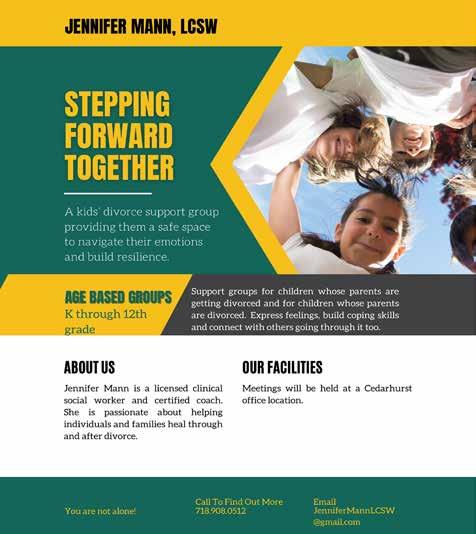
By Etti Siegel


Q:Dear Etti,
I like to have lots of prizes and treats for my kids to motivate them to go to school, do well, and try their best. Do you have age-appropriate suggestions I can stock? I am running out of ideas.
-Motivating Mommy
A:Dear Motivating Mommy, Thank you for writing in.
I am so glad that you are giving me an opportunity to address something I have been wondering about for years.
Why do you (and the many parents I come across who give prizes for going to school and getting good grades) think it is a motivator to present said treats?
I believe it is a de-motivator and causes long-term harm.
Let me explain.
Your child goes to school. It is a given. That is something he/she needs to do. Your child learns material, takes tests, and does all that is requested or expected. That is the nature of school.
By giving prizes for expected behavior, you are turning the message from “Do it for yourself, feel satisfaction for a job well done” into “Do it for me and I will give you a prize.”
Making everything about treats and prizes turns each activity into a task. It shouldn’t be a chore! It should be part of a regular student’s life to be in school and intrinsically want to do well.
Another issue is it changes the way a child acts in school, as stated above, and has ramifications on his/her social life.
Children in school are always clamoring to do their best and try their hardest. As your child becomes con-
vinced that learning and behaving is a task that must be done to make you happy, they might choose not to make you happy or not to invest energy in the task as they are tired and don’t “feel like it.” Whatever the reasons, this becomes a child who is more apathetic in school. The more studious, well-behaved children usually gravitate towards each other and might leave your child out.
Also, teachers tend to view the apathetic child as a struggling child, which perpetuates the cycle of needing to be bribed to perform.
Treats and prizes should be fun, an extra “I was thinking of you,” that is best when not tied to performance.
Making everything about treats and prizes turns each activity into a task.
The message we want to send is “do your best.” A job well done brings its own reward.
Think about a time you worked hard and accomplished your goal. Was it setting up for guests? Baking a cake? A big task at work? Loads of laundry at home? The inner joy of a job well done is something everyone should get to experience.
Research seems to indicate that when we constantly reward children we also send a subtle message that we don’t believe in them. This can become part of a person’s core belief about themselves, and the long-term effects are harmful. Core beliefs are the lens through which individuals interpret their experiences and make sense of the world. The task also becomes a behavior they only do for the reward, rather than for the fact that the task might be interesting, or it that it might be inherently enjoyable. (See studies by Deci et al., 2001 and Kohn, 2018.)
Interestingly enough, we have the ability to create strong core beliefs just by treating people like they can do what we charge them with. Conversely, people will create
core beliefs about themselves that are negative, based on how the people in their lives treat them.
To prove my point, I’ll share a study. Robert Rosenthal and Lenore Jacobson conducted an experiment in 1965 in Oak Elementary School, grades 1-6. Teachers were told that the test being administered would determine the children with the highest IQ’s. They then randomly chose children in every class and told the teachers that these were the children with the highest indicators, but they should not share the results with the class or the parents. Though there was no validity to the list, by the end of the year, those children were the top-performing students in every class across the school. The teachers were stunned to find out that the tests that were administered in the beginning of the year had never even been marked! This experiment was reproduced many times and always had the same results.
So hold off on the prizes and treats. Take them out to ice cream to celebrate the beginning of school (not for going to school) and tell them you believe in them. Ask them if they tried their best instead of asking for 100%. Instill messages of values and family expectations instead of turning their behavior into a tit-for-tat of doing a task and getting a prize.
The good news is that you can turn it all around in a short time, even if you have been bribing them for years. Realize your goals and change your messages.
Have a wonderful and rewarding year watching your children grow into the people they can be and being proud of themselves for what they accomplish.
Kesiva v’chasima tova,
- Etti

By Hylton I. Lightman, MD, DCH (SA), FAAP
Here’s the punchline: Parents should give their children foods containing peanuts. The process should begin early and be done often.
I had been recommending this to my patients for years. Then, in November 2017, the National Institute of Allergy and Infectious Diseases (NIAID) announced its own study and new guidelines began to emerge.
The guidelines: Low-risk infants (those who don’t have family history, eczema or an egg allergy), who have already started solid foods, can be introduced to peanut-containing foods around 6 months of age. Parents can add peanut powder or extract to foods. This is even okay with moderate risk children.
These guidelines say even high-risk infants (those with severe eczema or an egg allergy) can be introduced to peanut-containing foods after they start other solid foods. Importantly, you should have your pediatrician evaluate your baby for risk and safety.
Reminder: Never give whole peanuts or peanut bits to a baby because they can be a choking hazard.
Why was this study important? Peanut allergies have become ubiquitous (though it is rare that a child dies from a peanut allergic reaction) and are rarely outgrown, which means the person has to deal with it for their whole lives.
This protocol has “the potential to stop something in its tracks before it develops,” said Dr. Matthew Greenhawt, chair of the American Academy of Allergy, Asthma and Immunology’s food committee and one of the study’s authors. There appears to be “a window of time in which the body is more likely to tolerate food than react to it, and if you can educate the body during that window, you’re at much lower likelihood of developing an allergy to that food,” Dr. Greenhawt added.
This was a big change. But not for my patients, as my team and I had been championing this way of thinking for a long time.
For years, experts said that the best way

to fight peanut allergy was to avoid peanut products in the first years of life. The American Academy of Pediatrics (AAP) recommended in 2000 that any child at risk of a peanut allergy (such as those with a family history of peanut allergy or other food allergies or eczema) not eat any peanut-containing foods before 3 years of age. However, avoidance did nothing to arrest peanut allergies. If anything, more pea-
King’s College, studied the allergy rates of Israeli Jewish children with those of Jewish children in Britain. He found that the British group was 10 times more likely to have peanut allergies than their Israeli counterparts. This disparity could not be explained through differences in genetic background, socioeconomic class, or tendencies to other food allergies.
The big difference: Israeli children,
Could this be the important difference – that the Israeli children ate peanut products from an early age?
nut allergies were diagnosed. That’s why in 2008 the AAP stopped recommending it. What happened?
The new guidelines have grown out of several studies conducted over the last decade. Some were motivated by anecdotes that Jewish children in Israel rarely suffered from peanut allergies. Dr. Gideon Lack, the senior author of the study and professor of pediatric allergy at London’s
starting in infancy, eat foods containing peanuts, most famously, Bamba, a corn puff made with peanut butter. This peanut food introduces babies and their digestive systems to peanuts. Bamba is less sticky than peanut butter and encourages exploration and improves hand-mouth coordination.
Dr. Lack and his colleagues wondered: Could this be the important difference –that the Israeli children ate peanut prod-
ucts from an early age?
They conducted a study on about 600 babies who had severe eczema or egg allergy, which are known to increase the risk of peanut allergies. They divided them up into two groups: one was given Bamba to eat regularly; if they didn’t like Bamba, they could eat smooth peanut butter. The other was told to stay away from foods containing peanuts. They did this until the children were 5 years old.
What did they find?
3% of the kids who ate peanut products were allergic to them at age 5. 17% of the no-peanut product kids were allergic to them at age 5.
This included children who tested positive for a peanut allergy as infants. Children with strong positive tests, however, were not included in the study.
Wow.
Now, this doesn’t necessarily mean that everyone should run out and buy peanut butter – or that doing so will guarantee that the child never has a peanut allergy. There are questions that still need answers. How much peanut exposure will prevent an allergy? How long does it need to be eaten? Is it okay to eat it a few times and stop? Should families keep giving it? Further, peanut food should not be the first solids introduced into a baby’s diet. You should work with your pediatrician to develop a protocol appropriate to your baby.
This report has been promising and reinforces our 30+ years of experience at Total Family Care: If more parents follow these rules, maybe it will be okay for kids to revert to the old peanut butter-and-jelly sandwich as a lunchroom staple.
As always, daven
Dr. Hylton I. Lightman is a pediatrician and Medical Director of Total Family Care of the 5 Towns and Rockaway PC. He can be reached at drlightman@totalfamilycaremd.com, on Instagram at Dr.Lightman_ or visit him on Facebook.
By Yeshaya Kraus, LCSW
We’re about a week into the school year by now, and hopefully, the kids are settling in. We’d like to think that they’re adjusting to their new schedules, teachers, and responsibilities with aplomb and are maybe even looking forward to whatever comes next for them. Hopefully, parents are also adjusting to the changes and handling the different pressures of the school year gracefully. This time of year has potential to be a really great one. I’m not going to say that the school system isn’t without flaws. There are definitely a few, maybe more depending on what your personal situation might be. For the most part, though, schools do a pretty good job of keeping our children safe, educated, and growing, both intellectually and spiritually, throughout the year.
How do they do it? Perhaps this is a funny question, but how can we, as adults, get some insight from how schools work and apply it to ourselves? As much as we’d all like to think of ourselves as constantly growing and learning human beings, it’s easy as an independent and self-guided adult to fall into a routine that either doesn’t support the growth we’d like or even actively precludes it. What can we take out of the structure of a school experience that can help us get to where we’d like to be?
The first thing that stands out about school is that there are specific reasons for our kids to be there. (Cue the chorus of children saying, “No, there isn’t!” Really, though, there is.) There’s a curriculum, there are milestones, and there’s a structure in place to support reaching the goals in front of our children. That’s the first step on the journey to growth, whether it’s for our children or for ourselves: we need to clearly identify where we’d like to be. The more specific we get, the easier it will be to chart a course towards what we’d like to accomplish. Even putting down a few basic ideas can be helpful, though.
Another important aspect of the school experience that supports growth is the social environment. Whether they like it or not, our kids are surrounded by peers who are ostensibly doing the same things, at the same time, and are hoping to accomplish pretty much the same things. There’s what to be said about the benefit of surrounding yourself with like-minded people. Aside from the practical benefits, like having someone to help you out with the math homework if you get stuck, knowing that you’re not the only one who’s doing it makes the experience much less isolating and can help you focus on the benefits of whatever you’re trying to get to.
This brings us to the next point. One of the single most difficult aspects of follow-through on any goal is maintaining motivation. Motivation is a funny thing; it’s very fickle. Something that may seem worth pursuing today, that we’re really interested in devoting time and effort to, may seem either less important tomorrow or not worth the investment. Good teachers know how to keep things interesting and set up their lessons and their classroom structure in a way that helps maintain both focus and effort. They essentially try to have their students outsource motivation to follow through as much as possible. Whether by keeping the topics interesting enough so that it’s not so hard to keep on going or by incentivizing progress, a classroom setting done right can be a lot less complicated and tenuous than someone who is self-studying.
It’s not just for the classroom. This is a trick we adults can also tap into. Aside from choosing goals that naturally resonate with you and that you feel personally drawn to, you can set up incentives for yourself to boost your motivation and your progress. You don’t have to do it alone, either. Connect with a group that wants to accomplish the same things you do, and all of a sudden, you’re not pushing through all by yourself. Without a group, showing up

in whatever way you need to was entirely up to you (also known as “when I feel like it”). Once you connect with others, you don’t have to worry about maintaining your motivation all by yourself anymore. You’ve got the power of community behind you, sharing your excitement over whatever success looks like, and encouraging you when your pursuits aren’t going so well. You can also find and connect with people who have already done what you’re trying to do. Both of these possibilities make your goals seem much less like unachievable mountains and more like real possibilities. After all, you know someone, or a group of people, who have made it happen. It’s still work, but it’s far closer to the realm of possibility when you have the additional social support.
This next one is one that’s often overlooked and maybe even sounds funny. Let’s talk recess for a bit. Child development is a fascinating process. Look at a baby, or anyone under the age of twenty, when they’re playing. While it looks like they’re playing, and they may be enjoying themselves, there’s a lot of learning and practicing of skills that goes on at the same time. Think about it. A child’s ability to socialize, work as a team, negotiate, and utilize different sets of motor skills are all learned and improved on via a simple game of baseball. Ask a kid what they’re doing, though, and the answer will be something along the lines of having fun, chilling out, or letting loose. In reality, they’re doing both. They’re finding ways to practice skills, with a peer group, in a way that makes it fun. Ask most kids. They’ll
tell you it’s the high point of their day.
I’m not saying we need to organize games of tag for all the men on our block, but there is a real benefit in finding fun ways to maintain skills that we don’t use during the day. What can we do to stay in touch with our ability to run, to think creatively without the pressures of work, or to just let loose? Find some answers, put it together with some social connection, and you have a sustainable way to do things that are enjoyable for you and probably have some serious physical and mental health benefits, too. We don’t often think of recess in those terms, but honestly, most adults could really use it – a lot and frequently.
Obviously, everyone’s situation is different. The degree to which we can implement change and work towards growth, and what kind of change is even needed, is going to be unique to each individual. On whatever level, though, we’re all capable of taking some ownership of our personal growth. Odds are, we don’t have to look far to find the answers.
Yeshaya Kraus, LCSW, is a therapist in private practice in Far Rockaway. He specializes in men’s mental health, parenting, relationships, and dating. He is also the creator of the Building Together workshop for engaged and newly married couples, and speaks publicly on a variety of topics, including dating and marriage. For inquiries or to register for the Building Together online workshop, email him at yykraus@gmail.com or WhatsApp at 917-412-5824.


By Naomi Nachman

◦ 1 tablespoon canola oil
◦ 3 onions, diced
◦ 6 medium zucchinis, chunked
◦ 2 bags frozen cauliflower
◦ 4 cups water
◦ 1 teaspoon kosher salt, plus more for taste
1. Sauté the onions in oil with a teaspoon of salt until light brown.
2. Once the onions are browned, add in the zucchini so they have some color.
3. Add in two bags of cauliflower (you can also use broccoli).
4. Add four cups of water – make sure you add water one inch below the top of the vegetables.
5. Cover and simmer on low for one hour. The vegetables should be fork-tender.
6. Using an immersion blender, blend the vegetables until smooth and creamy. Add salt to taste. Enjoy this (almost) calorie-free recipe!
Naomi Nachman, the owner of The Aussie Gourmet, caters weekly and Shabbat/ Yom Tov meals for families and individuals within The Five Towns and neighboring communities, with a specialty in Pesach catering. Naomi is a contributing editor to this paper and also produces and hosts her own weekly radio show on the Nachum Segal Network stream called “A Table for Two with Naomi Nachman.” Naomi gives cooking presentations for organizations and private groups throughout the New York/ New Jersey Metropolitan area. In addition, Naomi has been a guest host on the QVC TV network and has been featured in cookbooks, magazines as well as other media covering topics related to cuisine preparation and personal chefs. To obtain additional recipes, join The Aussie Gourmet on Facebook or visit Naomi’s blog. Naomi can be reached through her website, www.theaussiegourmet. com or at (516) 295-9669.



By Nati Burnside
High-end kosher dairy restaurants are few and far between. Maybe it’s the feeling that any expensive meal must by definition include meat, or maybe it’s that fancier restaurants are generally only open for dinner and most kosher consumers eat dairy in the morning and afternoon and save their meat eating for later. Either way, you could probably count the number of true five-star kosher dairy restaurants in the country on one hand. However many there are, Teva is not only on the list but perhaps at the very top. Having opened last year on the third floor of the DSN Beach Club, Teva’s allure isn’t just based on the food. When you walk in, you’ll notice a raised seating area in the middle of the floor that sits directly above a retractable roof. (The roof is frequently open at night when the weather cooperates.) The far wall provides seating next to the open kitchen, and the near wall features an elegant bar room for a nice change of space. The two sides feature seating alongside long glass walls. The first faces the beach club’s courts, while the other provides an unobstructed view of the ocean from a few hundred yards away.
Given its location inside the beach club, you must be a member (or dining with one) to get into Teva during the busy season (Shavuot to Labor Day). But as Teva is now open to the public once again, I encourage you to go inhabit the relaxation and luxury of the experience this restaurant provides.
When I was invited to Teva, I opened my menu to the first page and saw several possible opening courses. One I strongly suggest you try is the Bruschette. This is three pieces of house-made focaccia topped with whatever the chef feels like that day. Mine was a trio of the classic tomato-onion blend with ricotta, a fresh avocado cream with feta, and a smoked salmon and cream version that stole the show. Not only were all three fantastic, but the difference in flavor profiles came
together perfectly with one acidic, one creamy, and one salty. The focaccia itself would have been perfect on its own, but the toppings were somehow an upgrade on perfection.
The other appetizer that caught my eye immediately was the Red Snapper e Arance. Making fish with oranges is an Italian tradition, and the red snapper was absolutely delicious after being barbecued and plated with the Cara Cara slices. The crispy pieces of leek that topped the dish were also a nice addition to the texture of the bite, making me wish there was an entrée portion of this appetizer.
But as Teva is an Italian restaurant, the pasta dishes are likely one of the reasons you walk in the door. All the pasta is made fresh, but even within the pasta category, you’ll find some things that look familiar while others are special to Teva if you are a kosher keeper. Let’s start with the Fusilli al Limone. As fresh as the pasta is, the sauce is also refreshing in this case, as the pecorino cheese and Italian Meyer lemons come together to create a creamy yet slightly sweet and acidic sauce. Meyer lemons look and taste a bit different compared to the American varieties. With a higher sugar content, the taste is a bit more balanced. The toppings of breadcrumbs and mint elevate the plate just a little by adding a slight crunch and aftertaste. If it wasn’t for the next paragraph, I would demand you order it.
With apologies to the fusilli, my top recommendation goes to the Tagliolini al Forno. This is the kind of dish you might find in some expensive non-kosher Italian restaurants in America, but I’m not sure any kosher establishment other than Teva is serving it anywhere. The Venetian dish uses a wide, shallow, ceramic bowl, and a spaghetti-like pasta is cooked in a bechamel sauce by being placed in an oven. The big attraction is actually the fact that the bowl is topped with a healthy layer of grated parmigiano that bakes until it forms a



solid golden brown layer that seals the top of the bowl. They bring it to your table and cut it into slices which you are able to eat with a knife and fork. The bottom is a creamy pasta that would be great by itself, but it’s attached to the baked parmesan crust top. The “crunch and mush” texture combination is often said to be the perfect bite, and this is the epitome of that. It is not to be missed.
As amazing as the pasta is, some people will insist on a higher level of protein if going out to a fancy dairy restaurant. If that sounds like you, perhaps try the Bistecca di Tonno. This two-pound tuna steak is wonderfully pepper-crusted, made in a perfect Pittsburgh style (charred outside, raw inside) and comes with a tasty side of crunchy roasted potatoes. I loved the use of the cooking method with the tuna as I enjoy both cooked and raw varieties. Like the other fish dishes I ordered, the portion size was quite large, so plan accordingly. You might want to split a fish entrée and a



pasta one between two people so nobody gets jealous.
Very few kosher restaurants offer a whole, wild caught Dover Sole on their menu, but if that’s something that interests you, Teva’s is magnificent. Your server will bring the fish whole to your table and debone it for you before laying the fish down on a platter large enough to fit the filets. They will then top it with the traditional sauce made of herbs, cream, and capers. And in case you were worried about a side dish, it comes with some of the best dairy mashed potatoes I’ve ever tasted.
At this point, I would usually get into desserts. But Teva had so many great options (10!) that I urge you to just try whatever it is that speaks to you personally. I tried a few things, and they were all amazing. You probably can’t go wrong, so just take your best shot.
Fantastic dining experiences are a delight, and Teva is certainly that. Whether it’s the unique view, cuisine, or experience, Teva is making a name for itself. Go out of your way to be a part of it.
- Italian - Waiter Service
Ocean Avenue North, Deal, NJ 07723 (732)-505-7415
This column features business insights from a recent “Mind Your Business with Yitzchok Saftlas” radio show. The weekly “Mind Your Business” show – broadcasting since 2015 – features interviews with Fortune 500 executives, business leaders and marketing gurus. Prominent guests include John Sculley, former CEO of Apple and Pepsi; Dick Schulze, founder and Chairman Emeritus of Best Buy; and Beth Comstock, former Vice Chair of GE; among over 400+ senior-level executives and business celebrities. Yitzchok Saftlas, president of Bottom Line Marketing Group, hosts the weekly “Mind Your Business” show, which airs at 10pm every Sunday night on 710 WOR and throughout America on the iHeartRadio Network.
Emotional i nt E lligE nc E
In my coaching practice and at Columbia University, I was teaching people to communicate, but there were a few instances where I found that my methods were not connecting with certain people. Something was not working. There was a disconnect every now and then, where my tools were just not resonating. I subsequently found out that for some of those cases, it wasn’t that they weren’t adopting the tactics that I was teaching, but that they weren’t advancing because they were scared to death. They were scared of making a mistake or being judged. So, I went home scratching my head, asking, “How am I going to solve this problem?”
In the 1990s, a Harvard psychologist named Daniel Goleman wrote a book called, Emotional Intelligence: Why EQ Is More Important Than IQ. Goleman talked about the “Four Models of Emotional Intelligence.” These are the
four things that make us who we are: self-awareness, social awareness, relationship-management, and self-management. When I started to teach emotional intelligence, I began to see the tie to communications. Emotional intelligence is driven mostly by self- awareness. Are you aware of your fear? How do we help you remove it? Some people are not aware that they’re afraid. They just act afraid and don’t know how to label it. The more that I could help somebody identify, measure, and monitor their emotional intelligence, the more they could conquer that fear and become a better communicator.
As I said, emotional intelligence (EQ) is largely driven by self-awareness. I once worked for a guy named Mike Bloomberg, who taught me many valuable lessons. He would always say, “I am accountable for whatever anyone in this organization does.” He taught us the importance

Since 2015, Yitzchok Saftlas has been speaking with leading industry experts on the “Mind Your Business” show, sharing insightful business and marketing strategies.
On a recent addition of the “Mind Your Business” show, Yitzchok Saftlas sat down with Chuck Garcia, CEO of Climb Leadership International.
Read on for some of Chuck’s top tools and philosophies for conquering your fears and unlocking your potential.
of holding ourselves accountable, and he led by example, because no matter what was happening, he wanted to take accountability. But he expected just as much from us. He held us accountable and expected us to adopt the same ethos of accountability.
I bring that same mindset of accountability when I’m teaching. It’s on me. If there is something that’s not working, the first thing that I have to examine is myself. I have to be accountable to solve the problem. I cannot assume that this was driven by somebody else. Now, maybe it was, but that should not be my starting point. Before you go pointing fingers and placing the blame, remember that it’s your problem first. This accountability and self-examination are key to developing a sense of self-awareness and EQ.
mE ntal modE l S
Charlie Munger and Warren Buffet often talked about the importance of develop -
ing what they called mental models. They wanted everyone to recognize that we are the sum of three mental circles. The first is our circle of competence, the things that we do. Their encouragement is to go deep into your circle of competence. Don’t work outside of it. There’s plenty to do to within your circle of competence. Be known as the best at what you do. If you want to be known as the best plumber in Brooklyn, don’t go to Manhattan or Queens. That is your circle of competence. The second is our circle of dignity, what is not negotiable to you. That’s how I know who you are, by what you are not willing to tolerate. The third is our circle of trust. Who’s in your circle?
What Buffett and Munger often talked about is, any time there is a circumstance, there is a decision to be made, walk through your circles. “Is what somebody’s asking me to do in my circle of competence? Does it betray my circle of dignity? Who am I going to do this with?” Everything that we approach can fit into a mental model.
Any event that occurs in your life is really driven by how you choose to perceive that event.
I found that I helped people to improve even more when I integrated EQ with this philosophy called “stoicism.” Stoicism is the recognition that I am not what happened to me. Any event that occurs in your life is really driven by how you choose to perceive that event. This relates back to the idea of self-awareness. The philosophy of stoicism says that there’s only one thing on this planet that I can control. It’s not my spouse, it’s not my kids, and it’s not my job. It’s me, my behavior and my sense of accountability. The Roman Emperor Marcus Aurelius wrote in his book “Meditations” that stoicism has its own mental models: justice, courage, wisdom, and temperance. The mental model that really speaks to me is temperance, because I think that is the x-factor in all individuals. Are they calm under the weight of pressure and expectations? Take two people in the same, high-pressure situation. One could have grace under fire and de -
liver above expectations, while the other person, of equal intellect and education, could be crushed under the weight of that pressure. The philosophy and the mental models help us recognize that the majority of things that happen to us are unpredictable. You need to develop a set of guiding principles by simply bringing this ancient philosophy into a modern context. What happens when the sky starts falling? Some people are going to panic, scream, and run. I go through the mental models and ask, “What’s happening here? How do I stay calm? What is the problem I’m going to solve?” Because, if I just go off without any kind of forethought, the sky is going to fall on me. If I stay calm, I’ve got a shot at solving this problem.
I read a book by the New York Times journalist David Brooks called, The Second Mountain. He says, “I’ve met people in my life who have something different

about them. They illuminate. There’s something that makes them just feel different.” And what he found is that many of us have climbed two mountains. The first mountain that we climb is the mountain of self. That mountain is the traditional, “I’m going to succeed and do my best.” It’s all about “me.” But he said that the people that stood out to him were on the other mountain. The second mountain is not about servicing the self but servicing others.
Years ago, I became almost a living embodiment of that metaphor. Because I would climb all of these actual mountains with these wonderful mountain guides that led me, a mere mortal, an average athlete with average intelligence, up these mountains; I was inspired by their service to guys like me, unyielding in their desire to ensure my experience. And I became the kind of teacher I am because of how those guides inspired me. When I came down from Mount Bona in Alaska, I said to myself, “This is my time. I am now on my second mountain. I’m going to go
home, and I am going to spend the rest of my days dedicated to the service of others success.” That is my second mountain. And what a thrilling adventure it has been. Short of raising my children, nothing has been more fulfilling than to see my students go out in the world and succeed.



Internals must look bad.
- Tweet by Tim Carney asserting that the polling must look bad for the Democrats, after the Biden Administration regurgitated the debunked 2016 theory that Russia is trying to influence the 2024 elections

If we could name a favorite candidate, it used to be Joe Biden, but now he’s not participating. He has recommended to all his allies to support Ms. Harris and that is what we are going to do.
- Russian President Vladimir Putin
Her laugh is so fascinating. It means everything is good and if everything is good... there were so many sanctions against Russia that were introduced and if everything is good with Ms. Harris, maybe she’ll refrain from such matters.
- Ibid.
Are you trying to get me assassinated before this even happens?
- Elon Musk, when asked on a podcast what he would do to shrink the government if he was involved in a Trump administration
They had more anti-Jewish, anti-Zionist people who were speaking, starting with AOC – a miserable, anti-Zionist bigot. Then, of course, they had Liz Warren who is one of the most antiJewish people in the Senate. I was disgusted at the Democratic National Convention, absolutely disgusted.
- Lifelong Democrat and famed attorney Alan Dershowitz disclosing on “Talkline with Zev Brenner” that the Democrat convention convinced him that it is time to leave the Democrat Party
To be honest with you, I think the case is nonsense.
- Nicholas Biase, the public affairs director for the U.S. Attorney’s Office of the Southern District of New York (SDNY), talking about the felony case brought by D.A. Alvin Bragg against Trump earlier this year, in a conversation that was recorded with a hidden camera

This debate won’t matter. It was just eliminated as an inflection point. The American people still know nothing about Kamala Harris’ positions. Donald Trump is still Donald Trump. And the legacy media are still a giant flaming dog turd.
- Ben Shapiro summing up the debate on X
Kamala is also trying to reach young voters. That is so important. I am also reaching out to young people, mostly to ask, how do you do that thing on Uber where you add a stop?
- Stephen Colbert
This is the ABC playbook: Moderators: Mr. [Trump], you did or said something that was absolutely terrible. Aren’t you terrible? DT answers. To [Kamala Harris]: “Would you like to weigh in on how terrible he is?” “Thank You.”
- Megyn Kelly summing up the presidential debate on X
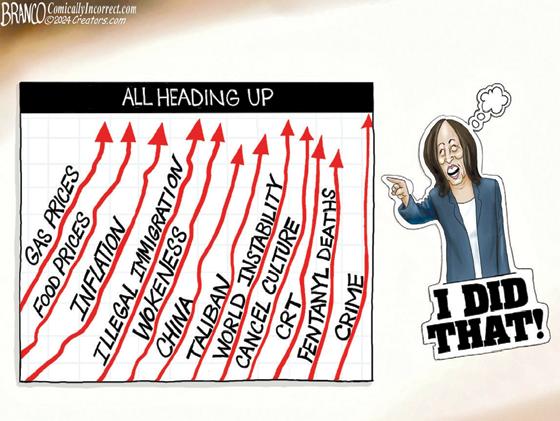
Shut down your office for 10 minutes a day and think about where your Jewish values are. Shut it down, send everyone out, no phones. Spend time alone with your Creator and think, where is G-d in your picture, where are your Jewish values?
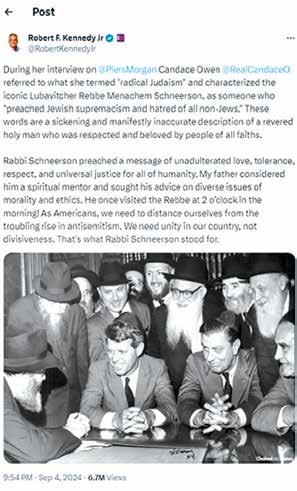

I don’t know what more we could possibly say about Trump.
- “South Park” creator Trey Parker saying that the animated show, which for years made fun of Trump, will not be back on the air until after the election because they ran out of material on Trump…he broke them
You know, we don’t have time to sit around and think about why, over the last few years, certain things may have happened or may not have happened. We’ve got to go win an election. And the vice president’s doing that by talking about her economic vision.
- Harris-Walz campaign spokesperson Ian Sams when asked on CNN to explain why Vice Pres. Harris hasn’t over the past four years done what she claims that she will do in the future
She has a punishing schedule.
- Biden-Harris Secretary of Commerce Gina Raimondo on CNBC explaining why Harris has not spoken to the press since becoming the Democrat nominee, other than one 18-minute interview on CNN
I think those folks who are speaking out loudly in Michigan are speaking out for all the right reasons.
- Vice presidential candidate Gov. Tim Walz complimenting proHamas protestors, in a radio interview
You have described Vice President Kamala Harris as a progressive. She has previously supported Medicare for all; now she does not. She has previously supported a ban on fracking; now she does not. These, senator, are ideas that you have campaigned on. Do you think she is abandoning her progressive ideals?
- Meet the Press Host Kristen Welker to Sen. Bernie Sanders
No, I don’t think she’s abandoning her ideals. I think she’s trying to be pragmatic and doing what she thinks is right in order to win the election.
- Sen. Sanders, in response

Stop buying coffee for $5.50. You got to work and spend $15 on a sandwich – what are you, an idiot?
- “Shark Tank” co-host Kevin O’Leary
It costs 99 cents to make a sandwich at home and bring it with you. You start to add that up every day, it’s a ton of money. Most people, particularly working in metropolitan cities, are just starting on their job, making their first $60,000, [and they throw] away about $15,000 a year on stupid stuff, and that’s what they should stop doing.
- Ibid.
Here in Westby, you know, I’m proud to announce that my — my investments — that through my investments, the most significant climate change law ever — and, by the way, it is a $369 billion bill. It’s called the [Inflation Reduction Act]. We should have named it what it was, but it — but any rate.
– Pres. Biden going off teleprompter at an event in Wisconsin and admitting that his inflation reduction legislation was really just a “climate change” bill in disguise
Speaking of food, in a Netflix Labor Day special, Joey Chestnut beat Kobayashi in a hot-dog eating contest by eating a record 83 hot dogs in 10 minutes. Eighty-three hot dogs in 10 minutes — that’s basically me at every wedding when they pass around the pigs in a blanket.
- Jimmy Fallon
Since the days of Abraham — who, according to Genesis, rescued his nephew Lot after he’d been seized by an invading army — Jewish tradition has placed supreme value on the redemption of captives. It is, in a sense, the fulfillment of a primary, implicit commandment: to be one’s brother’s keeper. It is also a source of Jewish communal cohesion over millenniums to never forsake those who have been taken, even if only to give them a proper burial.
It’s also, to mix references from antiquity, a Jewish Achilles’ heel.
In 2006, an Israeli soldier named Gilad Shalit was captured by Hamas and held in the Gaza Strip. He was released five years later in exchange for more than 1,000 Palestinian security prisoners — a euphemism, in many cases, for terrorists. The deal, which was approved by Benjamin Netanyahu, the prime minister of Israel, included the release of Yahya Sinwar, the mastermind of Oct. 7.
These two reference points are now at the heart of the debate Israelis are having about what comes next in Gaza. Huge demonstrations in Tel Aviv, coinciding with the heartbreaking funerals of six murdered hostages, have demanded that the prime minister agree to a cease-fire deal to obtain the release of additional hostages, at the cost of conceding one of Hamas’ core demands: an Israeli withdrawal from a strip of land known as the Philadelphi Corridor, which separates Gaza from Egypt. Netanyahu has refused, insisting in a news conference last Monday that Israeli forces will not leave.
Netanyahu is right, and it’s important for his usual critics, including me, to acknowledge it.
He’s right, first because the highest justification for fighting a war, besides survival, is to prevent its repetition. Israel has lost hundreds of soldiers to defeat Hamas. Thousands of innocent Palestinians have died and hundreds of thou-
By Bret Stephens

sands have suffered, because Hamas has held every Palestinian in Gaza hostage to its fanatical aims. Hamas was able to initiate and fight this war only because of a secure line of logistical supply under its border with Egypt.
Israel’s control of the Philadelphi Corridor largely stops this. To relinquish it
ative to save the hostages supersedes every other consideration — and that Israel can always retake the corridor if Hamas fails to fulfill its end of the bargain or if Israelis feel their security is again at risk.
That last argument is a fantasy: Once Israel leaves Gaza, international pressure for it not to re-enter for nearly any rea-
He’s right, first because the highest justification for fighting a war, besides survival, is to prevent its repetition.
now, for any reason, forsakes what Israel has been fighting for, consigns Palestinians to further misery under Hamas, and all but guarantees that a similar war will eventually be fought again. Why do that?
The answer, many of Netanyahu’s critics (including Yoav Gallant, his defense minister) would rejoin, is that the imper-
son short of another Oct. 7 will be overwhelming. And Hamas will ensure that any Israeli effort to retake the corridor will be as bloody as possible, for both Israelis and Palestinians, whom Sinwar treats as human shields. Those risks, too, should weigh on the moral scales of what Israel does next.
The more powerful case, especially emotionally, concerns the remaining 95 hostages, of whom 60 are believed to still be alive. Their agony is immense, as is that of their families. Any decent human being must feel acutely sympathetic to their plight.
But sympathy cannot be a replacement for judgment. Israelis — the hostage families above all — have spent the past 11 months suffering the bitter and predictable consequence of the Shalit deal, which also came about on account of intense public pressure to free him.
A good society will be prepared to go to great lengths to rescue or redeem a captive, whether with risky military operations or exorbitant ransoms. Yet there must also be a limit to what any society can afford to pay. The price for one hostage’s life or freedom cannot be the life or freedom of another — even if we know the name of the first life but not yet the second. That ought to be morally elementary. Also elementary: Whatever one thinks of Netanyahu, the weight of outrage should fall not on him but on Hamas. It released a video of a hostage it later murdered — 24-year-old Eden Yerushalmi, telling her family how much she loved them — on Monday, the day after her funeral. It’s another act of cynical, grotesque and unadulterated sadism by the group that pretends to speak in the name of all Palestinians. It does not deserve a cease-fire so that it can regain its strength. It deserves the same ash heap of history on which, in our better moments, we deposited the Nazis, al-Qaeda and the Islamic State group.
There are bright people who say that what Israel ought to do now is cut a deal, recover its hostages, take a breather and start preparing for the next war, probably in Lebanon. Israelis should remember that wars will be worse, and come more often, to those who fail to win them.
© The New York Times

An overwhelming majority of Israelis support Israeli Prime Minister Benjamin Netanyahu’s negotiation positions regarding a hostage deal with Hamas and oppose anti-government demonstrations in Tel Aviv demanding an immediate deal at any price, according to a new, in-depth JNS poll.
Netanyahu’s positions are supported not only by coalition-party voters, but also by approximately one third of voters for opposition parties, the survey found. Direct Polls conducted the survey on Monday evening both before and after the prime minister’s press conference, finding a significant disparity in Netanyahu’s favor in the latter sampling.
At the press conference, Netanyahu set out the rationale for his refusal to


By Caroline B. Glick

remove Israel Defense Forces troops from the border zone between Gaza and Egypt, known as the Philadelphi Corridor, its code name on IDF maps.
JNS asked respondents: “Do you believe Israel should support or oppose a deal that conditions the receipt of between 18-30 hostages on an IDF withdrawal from the Philadelphi Corridor for six weeks, during which Hamas will be able to rearm and smuggle hostages out of Gaza?”
Thirty-five percent of respondents overall said that Israel should agree to such a deal, while 62% opposed it. Three percent had no opinion.
Among coalition party voters, 7% supported withdrawing from the Gaza-Egypt border, compared to 62% of opposition voters. Ninety-two percent of
coalition voters opposed the withdrawal and 33% of opposition voters opposed withdrawing from the Philadelphi corridor.
Notably, 65% of opposition voters polled before the press conference supported withdrawing from the Philadelphi Corridor, and only 57% of opposition voters polled afterwards supported that position. Support for the withdrawal among coalition voters decreased from 8% to 5%.
The disparity between the way opposition party voters polled before and after Netanyahu’s press conference viewed mass anti-government protests on behalf of a hostage deal was even more apparent. Fifty-two percent of opposition party voters surveyed before Netanyahu’s press conference thought
that the demonstrations advanced the goal of getting the hostages home. Thirty-two percent said that the demonstrations had no impact on whether or not a deal would be achieved that would get the hostages home. Sixteen percent said that the demonstrations decreased the chance of getting a hostage deal with Hamas.
After Netanyahu’s press conference, only 42% of opposition voters believed that the demonstrations increased the prospects for getting the hostages home. Thirty-nine percent said that the demonstrations didn’t affect their plight, and 19% said that the demonstrations decreased prospects for bringing them home.
Sixty-one percent of Israelis agreed with the sentence, “Only military pres -
sure on Hamas leader Yahya Sinwar and planned military actions including hostage rescue operations can lead to the release of the hostages.” Thirty-three percent agreed that “Continuing IDF operations in the Gaza tunnels endangers the hostages’ lives.”
Israelis are sharply split over whether Netanyahu bears responsibility for the execution of the hostages. Opposition voters support the claim 69% to 28%, while coalition voters oppose it 94%-6%.
The hostage deal Netanyahu has accepted involves three phases. In the first phase Israel would agree to free hundreds of Hamas terrorists from prison and significantly draw back its forces from Gaza while accepting a six-week ceasefire. Hamas in exchange would free 18-30 hostages. In two later phases of the deal, Hamas would release the rest of the hostages—alive and dead—in exchange for the further release of terrorists from prison and continuation of the ceasefire.
JNS asked Israelis if they believed Hamas would be willing to release additional hostages in later phases of the deal or would refuse to release them.
Sixty-nine percent of Israelis (88% of coalition voters and 50% of opposition voters) believe Hamas will not release additional hostages. Only 24% of Israelis (10% of coalition voters and 38% of opposition voters) said that Hamas will be willing to advance along the deal and release additional hostages.
In other words, 69% of Israelis believe that between 83 and 71 hostages would be left behind in Gaza indefinitely.
Hamas’s negotiating position is that Israel must remove all of its forces from Gaza, including from the 3 kilometer wide security perimeter within Gaza along the border with Israel, the Netzarim Corridor that separates central and southern Gaza from northern Gaza, and the Philadelphi Corridor.
Seventy-three percent of Israelis, (95% of coalition party voters and 51% of opposition party voters) oppose Hamas’s demands. Twenty-two percent of Israelis support it, (4% of coalition voters and 40% of opposition voters).
A majority of Israelis do not trust the Biden-Harris administration’s commitments to support Israel if Hamas breaches the ceasefire-for-hostages deal. In response to JNS’s question, “Do you believe that the Biden-Harris administration will permit or block Israel from reinstating hostilities and reconquering Gaza to defeat Hamas if Hamas

breaches the agreement,” 38% of Israelis said the United States would permit Israel to renew military operations; 56% said the United States would block Israel from renewing its military operations in Gaza. Only 14% of coalition voters believed the Biden-Harris administration
court ruled the strike illegal on Monday afternoon and ordered it stopped immediately. The damage to the economy from the lost work hours is assessed at 2 billion shekels ($541 million).
JNS asked the public whether they believed that the strike advanced a hos -
The Israeli premier’s positions are supported not only by coalition voters, but by about a third of opposition voters, according to the survey.
would support a renewal of operations, while 61% of opposition voters trusted the administration’s support. Eightyone percent of coalition voters said the United States would prevent Israel from renewing its operations if Hamas breaches a ceasefire deal, compared to 31% of opposition party voters.
On Sunday, Arnon Bar-David, the chairman of Israel’s main labor union, the Histadrut, declared a general strike in order to force the government to accept a hostage deal at all costs. A Labor
Barak, the unofficial leader of the anti-government political groups organizing the protests, called for the anti-government groups to work behind the hostages’ families. On Tuesday it was reported that Barak’s associates will begin officially cooperating with the Hostage Families Forum from now on, effectively merging the group representing a fraction of the hostages’ families with the anti-government protest movement.
JNS asked the public whether it believed that the anti-government protest groups have joined the hostages’ families groups in order mainly to help secure their release, mainly to overthrow the government or to advance both goals equally. Fifty-five percent of Israelis (90% of coalition voters and 20% of opposition voters) said that the anti-government groups are helping the Hostages’ Families Forum to overthrow the government.
Twenty percent of Israelis (3% of coalition voters and 37% of opposition voters) said the anti-government groups were supporting the Hostage Families Forum to secure the hostages’ release.
Twenty-four percent of Israelis (7% of coalition voters and 41% of opposition voters) believed they were helping the Hostage Families Forum to advance both goals equally.
In light of Israeli Defense Minister Yoav Gallant’s open opposition to the Security Cabinet’s decision to oppose all withdrawals from the Philadelphi Corridor, JNS asked whether Israelis believe he should quit or be fired, or whether he should remain in his position. Fifty-one percent of Israelis said that Gallant should be fired or resign.
Thirty-three percent (53% of coalition voters and 14% of opposition voters) said Gallant should resign.
Eighteen percent of Israelis (32% of coalition voters and 4% of opposition voters) said that Netanyahu should fire Gallant.
tage deal, had no impact on prospects for a hostage deal or damaged prospects for a hostage deal. Eighteen percent said the strike increased the prospects for a deal, 32% said it had no impact and 50% said it harmed prospects for a deal.
The heads of the anti-government protest groups active since January 2023 and the Hostage Families Forum, which represents a few dozen hostage families, have been cooperating informally since Oct. 7. In December 2023, former Israeli prime minister Ehud
Forty-five percent of Israelis (13% of coalition voters and 76% of opposition voters) said he should remain in his position.
Similarly, 48% of Israelis believe that IDF Chief of General Staff Lt. Gen. Hertzi Halevy should either resign immediately or in the next four weeks and 41% believe that he should leave when the war is over. Only 7% believe he should remain in his position until the official conclusion of his term in 2025.
(JNS)
By Paul Mozur, Adam Satariano, Aaron Krolik and Steven Lee Myers
For millions of people, Telegram is like any other social media or messaging app.
In Brazil, 167,000 people subscribe to a Telegram channel for news about reality shows and entertainment. More than 1 million users in India prepare for government exams in another channel. And in one called Whale with more than 3 million followers, crypto trading tips are swapped in Persian.
Look deeper, and a dark underbelly emerges.
Uncut lumps of cocaine and shards of crystal meth are for sale on the app. Handguns and stolen checks are widely available. White nationalists use the platform to coordinate fight clubs and plan rallies. Hamas broadcast its Oct. 7 attack on Israel on the site.
Telegram has become a global sewer of criminal activity, disinformation, child abuse material, terrorism and racist incitement, according to a four-month investigation by The New York Times that analyzed more than 3.2 million Telegram messages from over 16,000 channels. The company, which offers features that enable criminals, terrorists and grifters to organize at scale and to sidestep scrutiny from the authorities, has looked the other way as illegal and extremist activities have flourished openly on the app.
The degree to which Telegram has been inundated by such content has not been previously reported. The Times investigation found 1,500 channels operated by white supremacists who coordinate activities among almost 1 million people around the world. At least two dozen channels sold weapons. In at least 22 channels with more than 70,000 followers, MDMA, cocaine, heroin and other drugs were advertised for delivery

to more than 20 countries.
Hamas, the Islamic State and other militant groups have thrived on Telegram, often amassing large audiences across dozens of channels. The Times analyzed more than 40 channels associated with Hamas, which showed that average viewership surged up to 10 times after the Oct. 7 attacks, garnering more than 400 million views in October.
Telegram is “the most popular place for ill-intentioned, violent actors to congregate,” said Rebecca Weiner, the deputy commissioner for intelligence and counterterrorism at the New York Police Department. “If you’re a bad guy, that’s where you will land.”
Operating like a stateless organization, Telegram has long behaved as if it were above the law — though that may be changing. Pavel Durov, the Russian-born founder of the platform, was arrested and charged in France last
month for failure to cooperate with law enforcement and complicity in crimes committed on the service, including the distribution of child abuse material, drug trafficking and fraud.
In many democratic countries, patience with the app is wearing thin. The European Union is exploring new oversight of Telegram under the Digital Services Act, a law that forces large online platforms to police their services more aggressively, two people familiar with the plans said.
Telegram’s tolerance for toxic activities begins with Durov, 39, who runs the company with a devout belief that governments should not interfere in what people say or do online. This year, he wrote on his Telegram channel, “Were it entirely up to us, we would always give our users what they ask for: access to uncensored information and opinions so that they can make their own decisions.”
Telegram has benefited people in authoritarian countries who need ways to freely communicate, but the app has also contributed to real-world harm. Hateful discourse that spread on the platform has played a role in recent riots in Britain and arson at migrant housing centers in Ireland.
A disparate collective on Telegram known as Terrorgram, where neo-fascists share messages and videos encouraging violence, has been linked to attacks, including a shooting in 2022 at a bar in Slovakia.
Even as Telegram approaches 1 billion users, it has prided itself on behaving differently from its tech peers. The company, based in Dubai, United Arab Emirates, operates like a startup, with about 60 full-time employees. It has hired just a few hundred contractors to work as moderators, and it steadfastly ignores most requests for assistance from law enforcement agencies.
An email inbox used for inquiries from government agencies is rarely checked, former employees said. When a House committee investigating the Jan. 6, 2021, attack on Capitol Hill sought information from 15 internet platforms, only Telegram did not respond.
In contrast, Instagram, YouTube and TikTok have entire divisions dedicated to complying with law enforcement requests and thousands of moderators scouring their services for illicit and harmful material.
Only Apple and Google, which can expel Telegram from their app stores, have successfully pushed the platform to take down and restrict the spread of harmful material, said analysts, government officials and tech executives. Governments have sometimes turned to the tech giants
for help getting Telegram to act.
Hours after the Times sent Telegram a detailed list of questions, Durov on Thursday posted his first comments to his 12 million-plus followers since his arrest. He said claims that Telegram was “some sort of anarchic paradise are absolutely untrue” and that the company removed “millions of harmful posts and channels every day.”
He attributed the volume of illicit and harmful content to Telegram’s “growing pains,” adding that “that’s why I made it my personal goal to ensure that we significantly improve things in this regard.”
In a statement to the Times, Telegram said that “99.999% of our users” were lawful and that while there was “plenty of work to do,” the platform was making improvements to its features and moderation.
In December 2022, Hayden Espinosa began serving a 33-month sentence in federal prison in Louisiana for buying and selling illegal firearms and weapon parts he made with 3D printers. That did not stop his business.
Using cellphones that had been smuggled into prison, Espinosa continued his illicit trade on a Telegram channel, which was named after 3D printing and the Second Amendment right to bear arms, according to an indictment in June by Manhattan District Attorney Alvin Bragg.
One post in the channel’s “shop” offered a menu of prices for weapon parts, including ammunition clips and devices called auto sears, which empty a magazine with a single pull of the trigger. “DM for International Orders,” the post said.
Telegram combines the anonymity of the dark web with the ease of use of an online marketplace. It is easy to search and find channels selling guns, illicit narcotics, prescription drugs and fraudulent ATM cards, called clone cards. Alongside photos and videos of available merchandise, dealers leave information on how to message them directly.
Often they act like salesmen, celebrating successful deliveries and touting discounted prices.
One reason Telegram has become a haven for such activity stems from its unique features, including “channels” and “supergroups,” which rivals such as WhatsApp were slower to add.
Telegram began as a standard text messaging service similar to iMessage or WhatsApp before it began evolving in 2014 by adding broadcasting features. These “channels” are now one of the plat-
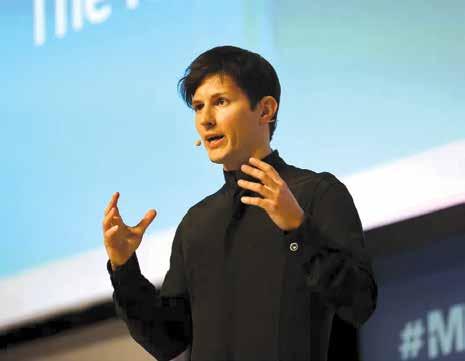
form’s best-known tools for sharing text, images, links and videos by news organizations, world leaders and government agencies.
Telegram then introduced “supergroups,” which harked back to an era of unruly AOL chatrooms. These groups attracted new users but also presented risks.
While WhatsApp kept group chat sizes in the hundreds and limited link sharing to blunt the spread of disinformation, Telegram did the opposite and steadily lifted the cap on group sizes. By 2019, a group administrator could run city-size chat groups with as many as 200,000 users.
Initially, this attracted new users interested in cryptocurrencies. In the crypto world, Telegram became a critical tool for talking about new digital coins and cultivating communities dedicated to, and often heavily invested in, particular currencies.
These tools also attracted a less savory group of users, including extremists, disinformation peddlers and sellers of illicit goods.
“I don’t want to paint with a broad brush,” said Bragg, “but I think the combination of a number of things — the encryption, the ability to reach large numbers of people, the ability to set up subgroups and their posture toward law enforcement — creates an environment in which it’s not surprising that criminal activity is occurring.”
Nor has the platform dedicated significant resources to weed this activity out. As Telegram ballooned, its staff barely grew. Today, it has contractors and artificial intelligence tools to proactively
monitor the public parts of Telegram, which does not include many groups or individual chats.
The company said it had a moderation process, which includes constantly reviewing content, fielding user complaints and publishing daily reports on child abuse materials.
Even so, the Times found at least 50 channels openly selling contraband, including guns, drugs and fraudulent debit cards. One channel that evoked the Wild West with its name called successful deliveries “touchdowns,” a popular slang in such groups.
Telegram’s features — coupled with its refusal to cooperate with the police — have stymied criminal investigations, increasingly frustrating authorities. The company can gain access to messages unless users select a secret chat option with end-to-end encryption, according to two former employees. On at least two occasions, the company has retrieved the messages of former employees, one person said.
But the company, which denied that employees had access to user data, has refused to share information with governments. France charged Durov with complicity in trafficking child [abuse] imagery, among other crimes, because of what the chief prosecutor called “an almost total lack of response” to requests for assistance.
Svenja Meininghaus, a state prosecutor focused on illegal hate speech in Germany, said other major social media platforms had developed practices for working with law enforcement. But “we
don’t get any cooperation from Telegram at all,” she said, adding, “I can’t recall one case.”
Telegram said it was “now working hard to make sure we can process legitimate requests from democratic countries while still defending the rights of our users elsewhere.”
Espinosa’s gun market on Telegram might never have been uncovered except that one of its members was Payton Gendron, who massacred 10 people at a supermarket in Buffalo, New York, in 2022.
Investigators scouring his life online for motives for the shooting discovered the channel, which also featured racist and extremist views he had shared.
Having stumbled across the channel’s illicit trade in components of untraceable “ghost guns,” an undercover police officer in New York City reached out to Espinosa, 24, and bought a handgun, an assault rifle and two silencers from him in August 2023, according to the indictment. A lawyer for Espinosa with the Legal Aid Society could not be reached for comment.
When Hamas attacked Israel on the morning of Oct. 7, it announced the assault on Telegram.
Within 2½ hours of the first incursions, Hamas began posting grisly videos of the carnage. In the first 72 hours of the war, channels affiliated with the group posted nearly 700 times, receiving more than 54 million views, according to the Times’ analysis.
Telegram became so useful to Hamas that the group turned to the platform more than it did an official Hamas app, the Al-Qassam Brigades Android app, which it had built to communicate with supporters. Content posted to both platforms consistently saw 100 times more reach on Telegram, the Times found.
Hamas capitalized on other Telegram features. After Oct. 7, members of its groups and other supporters easily downloaded videos of the violence and posted them to other platforms with little interference. The effect was a surge of grisly clips across the internet.
After Apple and Google demanded some moderation, Telegram relented — but only a little. In late October, the company restricted access to some Hamas-related content on copies of its app distributed through the official Apple and Google app stores. It also sent some users instructions on how to download another version of the app that did not have the content removed.
“If you wish to continue reading those channels, you can do so using the direct version of Telegram for Android which has the minimum possible restrictions,” said a message sent from an official Telegram account that was reviewed by the Times. It included a link to the unfiltered version of the app.
In contrast, Facebook, Instagram, TikTok and YouTube blocked accounts linked to Hamas, as well as posts that were overtly sympathetic to its cause.
In an Oct. 13 post, Durov defended the availability of Hamas-related content. In one instance, he noted, Hamas had used Telegram to alert Israelis of a coming attack.
This month, Hamas used Telegram to release videos of hostages in Gaza who were later killed. One of the videos, which was viewed more than 100,000 times, included English, Arabic and Hebrew subtitles to maximize its audience.
Basem Naim, a Hamas spokesman, declined to comment. After being contacted by the Times, Telegram blocked access to several Hamas channels on Friday.
Durov, who was born in 1984 in the Soviet Union, became known as Russia’s Mark Zuckerberg after he founded VKontakte, a social network similar to Facebook, in 2006.
As VKontakte took off, Durov said the Kremlin pressured him to remove content and report users, wary of the network’s power to organize anti-government sentiment. That inspired him to start Telegram as a method of keeping communications safe from the government’s prying eyes. The app was released in 2013.
In 2014, Durov left Russia. Since then, he has lived itinerantly, working from Berlin, San Francisco, London and elsewhere before landing in Dubai. Worth an estimated $9 billion, he has become a sort of free speech folk hero.
So on Aug. 24, as news of Durov’s arrest in France ricocheted around the world, the events were debated by a group nearly 5,000 miles away in Montana.
They were members of a local Telegram channel for White Lives Matter, a disparate white nationalist group that adopted the name from the movement formed in 2013 to protest police killings of Black people.
The white nationalist group is inextricably linked to Telegram for communication, recruitment and coordination. On the platform, there are nearly 50 chapters of the movement around the world, in places including Florida, Alabama,

A Hamas post on Telegram on October 7
New York, Italy, Russia, Germany and the Czech Republic. They share anti-immigration views and commentary and organize protests or other actions, including unfurling racist banners in public spaces, the Times found.
“Join our team, and let’s make something good happen for a change!” read a recent post in the Montana channel.
The chapters, which typically have a few hundred members, have been linked to violence. One Ohio member firebombed a church that hosted a drag event in Alliance, Ohio, last year, according to court documents.
The movement takes advantage of Telegram’s features. Known as a hub-andspoke model, an international channel with more than 21,000 members amplifies broader messages while smaller local groups focus on organizing and recruiting.
Tinier private channels are where activities, sometimes illegal, are planned, experts in extremist movements said. The result was a feedback loop where local actions, such as a vandalism campaign, were amplified globally, which in turn inspired more action elsewhere.
Other far-right nationalist groups have also sprouted on Telegram. In a channel for the American far-right extremist group Proud Boys, acts of political intimidation were planned, including demonstrations outside election centers in 2022 and a campaign this year to steal and damage rainbow flags. In Ireland, anti-immigration activists use Telegram to share the locations of immigration centers, some of which were later targeted by arsonists.
Some extremist groups have grown more cautious as scrutiny of Telegram has intensified. Messages pinned to local channels instruct new members on how to stay anonymous.
“Remember: This is a public channel, and not everyone who views it is friendly to people who support WLM,” read a post on one channel. “Write and converse accordingly.”
A new member to one chat was instructed by a group administrator to “please setup a non personal profile picture.” To be invited into more private chats, new recruits must first interact with an automated bot, which connects them with a local chapter after vetting their intentions and background.
“We are here simply because we like what Telegram stands for, uncensored freedom of speech,” an administrator of the channel wrote in response to questions. “Condemning ‘It’s okay to be white’ as hate speech is why we are here and will continue to speak and fight against the anti-white narrative.”
Ahead of the U.S. presidential election in November, security researchers are monitoring Telegram for threats of violence. In many public channels, activists are already making claims of voter fraud, with calls to be prepared to act, said Arie Perliger, a criminology professor at the University of Massachusetts Lowell, whose research is partly funded by the National Institute of Justice, a research agency of the Department of Justice.
If former President Donald Trump loses in November, Perliger said, “we need to understand Telegram will probably be a substantial infrastructure for extremists who want to do something about it.”
Several times a year, employees at Apple’s Silicon Valley headquarters send notes to Telegram demanding it remove material that has been flagged as illegal or otherwise harmful.
Apple explains that under its guidelines, the app must have policies to filter out objectionable content and block abusive users, said three people with knowledge of the exchanges who declined to be identified discussing private talks. Telegram often voices its objections, they said, but it almost always bends to
Apple’s demands. Where governments have failed to get the app to act — or even respond — Apple and Google have had some success by using the threat of kicking the service out of their app stores.
With Telegram, the companies are trying to balance the app’s potential harms against its beneficial role as a private communications tool and a critical piece of digital infrastructure in countries such as Ukraine and Russia. They must also consider differing rules about what is classified as illegal speech around the world.
In practice, the most effective way to get Telegram to act is a sort of whisperdown-the-lane approach in which users, advocacy groups, news coverage and sometimes governments draw Apple’s and Google’s attention to the app’s harmful and illegal content. The tech giants in turn notify Telegram to respond.
In addition to Apple’s regular messages to address such content, Google sends requests to Telegram almost weekly, four people with knowledge of the interactions said. Telegram responds quickly when alerted to clearly illegal material like child abuse content, they said, but it is more resistant to demands to address speech-related content that is less clearly unlawful. Telegram said it abided by Apple’s and Google’s moderation rules. Google and Apple declined to comment on Telegram and said their rules were detailed in developer guidelines.
Durov has grown increasingly antagonistic toward the tech giants. He has called Apple a “trillion-dollar monopoly” and chided the company in April for blocking Telegram on its China app store, writing that “prioritizing profits over freedom for users is not a good long-term strategy.”
“The largest pressure toward Telegram is not coming from governments; it’s coming from Apple and Google,” Durov said in an interview this year with Tucker Carlson.
The New York Times analyzed 3,242,664 Telegram messages from 16,220 channels. Prose Intelligence, a company that analyzes Telegram data, provided an initial list of channels. Using those, the Times wrote code to download messages and expanded the network using hashtags, common phrases and forwarded messages.

The Biden administration is preparing a formal “national security memorandum” on artificial intelligence that will explore ways for the United States to “preserve and expand U.S. advantages” in AI technologies that could transform science, business and warfare, according to a senior administration official who has reviewed a draft of the memo.
The new approach won’t propose the “Manhattan Project for AI” that some have urged. But it should offer a platform for public-private partnerships and testing that could be likened to a national laboratory, a bit like Lawrence Livermore in Berkeley, Calif., or Los Alamos in New Mexico. For the National Security Council officials drafting the memo, the core idea is to drive AI-linked innovation across the U.S. economy and government, while also anticipating and preventing threats to public safety.
The new strategy will focus on defense and intelligence agencies, aided by the just-created AI Safety Institute at the Commerce Department and its National Institute of Standards and Technology. The Pentagon, the intelligence community, and Commerce will work to develop partnerships with the five private companies that dominate AI research, all of them American: Microsoft-backed OpenAI, Google’s DeepMind, Elon Musk’s xAI, Meta AI and the start-up Anthropic.
The memorandum will “provide a framework for responsible use of AI, which will enable faster adoption” in the government and private sector, the administration official argued. He said the memorandum should be completed in late September or early October. What’s motivating this effort is the growing possibility of “artificial general intelligence,” or AGI, a hyper-connected future version
By David Ignatius

of the technology that promises superhuman intelligence.
How government should interface with this transformative technology is a preoccupation for policymakers at home and abroad. An early test is an AI safety bill just passed by the California legislature. One of its key provisions requires AI companies to exercise “reasonable care to avoid unreasonable risk” of catastrophes, according to Nathan Calvin, an AI safety lawyer who has been working on the legislation for state Sen. Scott Wiener (D). Silicon Valley tech companies are sharply divided on the bill, and Gov. Gavin Newsom (D) hasn’t said whether he will sign it.
The White House wants to connect future federal oversight of AI with international standard-setting that is already underway. The European Union recently adopted its own AI Act, the world’s first major legislative framework. Britain’s AI Safety Institute helped convene a summit of 28 countries at Bletchley Park in November and a follow-up meeting of the same nations in Seoul in May. China was part of both groups.
AI’s potential is world-enriching and also, possibly, world-destroying. The national security implications received
intense study in July at a meeting of the Aspen Strategy Group, a bipartisan gathering of top former government officials, business executives and journalists. At the concluding session, Philip Zelikow, a former State Department official who teaches at Stanford, presented a provocative proposal for reducing risks.
The government’s first obligation is a threat assessment, said Zelikow. It needs to study what catastrophes could be deliberately created by “the worst people and governments in the world using the most advanced possible models.” The government must also assess the havoc that could be wreaked by a “misaligned,” or rogue, AI. Once government agencies have gauged the risks, they will need to think about countermeasures, which will also involve AI, Zelikow argued.
The Manhattan Project analogy is tempting. “This may be a technology where the first-mover advantage would be world-historically decisive,” Zelikow told me. He noted the oft-cited danger that Adolf Hitler might have developed a nuclear bomb first, if America hadn’t raced to build one.
But even if Washington wanted to drive artificial intelligence in the same way it did nuclear research, it probably
couldn’t, argues Graham Allison, a Harvard Kennedy School professor who has written extensively about AI. Unlike in the 1940s, Allison told me, cutting-edge technologies and cash to fund them are privately held, and the government struggles to keep pace. Public-sector managers are more often obstacles to innovation than enablers of it. Zelikow agrees with Allison’s critique.
Rand, which played a crucial role in early nuclear-weapons strategy, is helping policymakers think about AI risks with a new project called the “Geopolitics of AGI Initiative.” Joel Predd, the project leader, explained to me Thursday that he wants to explore some key uncertainties about whether AGI will emerge gradually or suddenly, and whether the country that obtains it first will have an unbreakable strategic or competitive advantage.
“Our central research question,” he said, “is how the U.S. government should address the deeply uncertain but technically credible potential that world-leading AI labs are on the cusp of developing” AGI.
The debate is just beginning. Already, the tech world is dividing between “doomers,” who think AGI will mean the end of humanity, and “accelerationists,” who see it as “a way to make everything we care about better,” in the words of techno-optimist Marc Andreessen, who co-invented the first internet browser.
Joe Biden is the paradigm of an old-fashioned, analog guy. But in his final months in office, his team is boldly trying to write the rules for a digital technology that will have the capacity to rearrange, for good or ill, every piece of our global mosaic. As Shakespeare’s Miranda exclaims at the end of “The Tempest”: “O brave new world.”
© 2024, Washington Post Writers Group
By Avi Heiligman
Despite being defeated by the Americans during the Revolutionary War, the British decided that they didn’t like American westward expansion and declared war in June 1812. The War of 1812 isn’t understood well by the public, and even its causes are debated by historians. As the anniversary of the writing of the Star Spangled Banner (which was written during the Battle of Fort McHenry in September 1814) approaches, we’ll take a look at some of the heroes of the war.
Francis Scott Key is the most famous person who was involved in the Battle of Baltimore, but there were thousands of soldiers that were important to the defense of the busy port city. Mendes Cohen came from a prominent Baltimore Jewish family and, together with his two brothers, joined the militia to fend off the British attack. Mendes started off serving with the 27 th Regiment but then transferred to an artillery unit called the Nicholson Artillery Fencibles. At first, the Americans retreated while the British attacked at North Point. The American defenses were held by 10,000 troops and were much stronger than the invading British force. The British decided to then bombard the fort, and by the morning of September 14, the American flag was still flying high. The British soon broke off the attack. The poem which Francis Scott Key wrote while on board a British ship eventually became the national anthem.
Other units besides front line fighting troops came to prominence during the war. The Engineer Corps worked on fortifications in the years leading up to the War of 1812. The forts became an
integral part of the defenses that eventually helped the Americans defeat the British. Military bands became a regular part of the American military and served with distinction during the war. On the other hand, the lack of intelligence units became a glaring issue when the existing units failed to pick up information about British troop movements until they were just sixteen miles out of Washington. It took until the Civil War for the intelligence units to be expanded and technology incorporated into their work.
Future President Andrew Jackson was the fierce commander, and it was during the Battle of New Orleans in 1815 that he became a household name. Jackson led the defense of the city and routed the British during an assault that was poorly executed in the last battle of the war.
Philanthropist Judah Touro was fighting under Jackson’s command and was seriously wounded in the thigh by British cannon. He was nursed back to health by a friend who was also in the army.
Jackson wasn’t the only future president to earn acclaim during the war.
The ninth president, William Henry Harrison, entered the military in 1791 and had been involved in the conflicts with the Native Americans. By 1800, Harrison was the governor of Indian affairs in the Indiana Territory and subsequently had led a force to victory at Tippecanoe. His main adversary was the Shawnee chief Tecumseh.
During the War of 1812, the British captured Detroit. Harrison, who by now was a seasoned politician as well as a military leader, was asked to lead a force to recapture the city. He took the city back in 1813 and led the Americans to a


victory over the British and their allies at the Battle of the Thames in Ontario. One of their allies was Tecumseh, who was killed during the battle. Harrison received a medal from Congress for his decisive victory, and he used his military successes in his presidential campaign.
In addition to land forces, naval ships played an important role in the struggle against the British. The USS Constitution was launched in 1797 and had been involved in the Barbary War to defeat pirates. During the War of 1812, she ran past the British blockade around the city of Boston. She then went on to defeat five enemy warships and nine British merchant vessels. Since then, she has remained in the U.S. Navy and presently is staffed by dozens of active duty officers and sailors who are on special duty with the mission to promote the Navy’s role in war and peace.
The Treaty of Ghent to end the war was signed in December 1814, but it took weeks before it reached the United States. During that time, the Battle of New Orleans took place, and it is for that reason that some call it the “Needless Battle.” The treaty restored the pre-war borders and ushered in an era of peaceful relations between the two countries that is still going strong over two centuries later.


Avi Heiligman is a weekly contributor to The Jewish Home. He welcomes your comments and suggestions for future columns and can be reached at aviheiligman@gmail.com.

MAJOR APPLIANCE REPAIR
Servicing Washers , Dryers , Refrigerators , Dishwasher, stoves
All work guaranteed. Call 718 3762288
VACUUM SALES AND REPAIR
All areas call Max Flam 718-444-4904
THE LEATHER SHOPPE
The spot for all your custom leather Judaica. Tallis/tefillin bags, lulav and esrog bags, havdallah sets, challah covers, shtenders, pesach sets, matzah/afikomen bags. WhatsApp: (732) 523-0007 or email: theleathershoppe732@gmail.com for a full catalog. We ship.
MY MOTTO IS DON’T WAIT TO buy real estate
Buy real estate and wait
Your realtor for life
516-784-0856 Alexandra at Realty Connect USA
PEACEFUL PRESENCE STUDIO
Men’s private yoga, Licensed Massage & Holistic Health Guidance 436 Central Ave, Cedarhurst Info. & free video training www.peacefulpresence.com 516-371-3715
READING SPECIALIST
Trained in Orton Gillingham and many multisensory reading programs. Specializes in dyslexia and auditory processing disorder and other reading difficulties.
Rhess.education@gmail.com
Call or Text (516) 220-2059
GERBER MOVING
FULL SERVICE MOVING
Packing Moving Supplies
Local Long Distance. Licensed Insured
1000’S Of Happy Customers
Call Shalom 347-276-7422
HANDYMAN AVAILABLE
For big or small jobs, Sheetrock, carpentry, painting, electrical, plumbing, install & repair appliances
Call Ephraim at 347-593-4691
MANAGEMENT STAFF WILL ASSIST you with: * Obtaining Medicaid and Pooled Income Trust
* In-home Assessments, Individual and Family Counseling
* Securing reliable home care assistance
* Case and Care Management services
Dr. S. Sasson, DSW, LCSW (718) 544- 0870 or (646) 284-6242
HAIR COURSE:
Learn how to wash & style hair & wigs. Hair and wig cutting, wedding styling Private lessons or in a group Call Chaya 718-715-9009
ZEVIZZ WOODTURNING JUDAICA Challah knifes, batei mezuzah, besamim holder, kiddish cups, havdalah candle holders, yad for sefer torah, pens, stenders, bowls and more 952-356-2228
ECO-FRIENDLY CONTRACTOR
Big or small jobs. from conception to completion windows, doors, plumbing, electrical, Kitchen Cabinet countertop. petitions, Bathrooms, tiling. additions , painting, any construction work. call MICHEL 9175383763 Shomer Shabbos
CEDARHURST
Don’t miss this opportunity!
4 Bedroom 21/2 Bathroom House Perfectly located in Cedar Bay Park, walking distance to all. Oversized property for expansion, A Must See. LOCATION, LOCATION. For More Info call (516) 881-7727 Leave Message
WOODMERE
Beautiful, brick, colonial boasting 5 bdr 3.5 Bth in pristine condition. Excellent location, near all! Move right in! RCUSA 516-512-9626
WOODMERE
Introducing a stunning 14-side hall colonial home in the Hewlett Woodmere School District. Formal living room, formal dining room, den with a skylight. Eat in Kitchen, two sinks, a double oven, a warming draw and a microwave. First floor bedroom, a full bathroom and laundry room. Two-car garage. Upper level has four bedrooms, two full bathrooms. Finished basement with playroom, storage and utilities. Well-groomed exterior with porch adjoining the master bedroom. Hardwood floors and back patio. Central air conditioning, inground sprinkler system, alarm system. Close proximity to schools, shopping centers, restaurants, and transportation options. Mark Lipner Associate Broker Berkshire Hathaway Laffey International 516-298-8457 mlipner@bhhslaffey.com

CAN’T AFFORD YOUR PROPERTY TAXES? MORTGAGE?
Must sell for any reason? Call for FREE Consultation. Call now 212-470-3856 Cash buyers available!
Spacious home within school district 14 with exquisite upgrades and central air conditioning, splendid kitchen with dual sinks, five bedrooms. Main level encompasses a spacious great room, office space, complementing the formal living and dining areas. Unfinished basement, detached garage. Expansive lot, measuring 80 x 100. Conveniently located near shopping, railroad, restaurants and places of worship. Mark Lipner Associate Broker Berkshire Hathaway Laffey International 516-298-8457 mlipner@bhhslaffey.com
WOODMERE ACADEMY LOCATION
Unique Find! Designer renovated 10 bdrm 6.5 bth col. Stunning pvt 1st flr guest suite w/2 lg bdrms, full bth, & addl kitchen. POR.
Chana Bienstock
Miller Realty, inc. 516-449-9692
Entrance off Gourmet Glatt lot, second floor, shared bath, ideal for therapist/ office work, includes utilities, $600. Call 516-371-3715
2 PROPERTIES
Trustee Sale. 10 Cents on the dollar. 2. AC Farmhouse. Elmer. NJ. And 12.000. Sq. Ft commercial lot South. Brunswick NJ. Accepting all offer. 212-470-1708. Text or leave message

BIG FULLY RENOVATED, Woodmere, spacious 4bedroom 2 full bath split level.2 car garage +driveway. Backyard on water SD#14. W&D. Tons of storage space. 347-517-3552
DON’T GET STUCK WITH A TWO STORY HOUSE YA KNOW, IT’S ONE STORY BEFORE YOU BUY IT BUT A SECOND STORY AFTER YOU OWN IT!
Call Dov Herman
For An Accurate Unbiased Home Inspection
Infrared - Termite Inspection Full Report All Included
NYC 718-INSPECT Long Island 516-INSPECT www.nyinspect.com
SEEKING ELA TEACHER Teaching position for Gr. 6. Mon.-Thurs., afternoon hours. Far Rockaway/5T area. Great salary, warm, supportive environment. Training in our curriculum is provided. Teachersearch11@gmail.com
HIGH SCHOOL TEACHER Shevach HS has a position for an Earth Science teacher. 4:14 to 4:54 pm M-Th. Please send resume to mshepard@shevachhs.org
BNOS MALKA ACADEMY In Queens is seeking assistant teachers. AM/PM/Full time. Competitive salary and supportive administration. Please send resume to rungar@bnosmalka.org
REGENTS EXPERT
Tutoring regents in Algebra and Geometry A Darchei Torah instructor. Guaranteed results Text 347-491-8045 WhatsApp 347-767-1755

classifieds@fivetownsjewishhome.com • text 443-929-4003
5 TOWNS BOYS YESHIVA
Seeking Elem Gen Ed Teachers
Excellent working environment and pay. Only lic/exp need apply. Email resume to yeshivalooking@gmail.com
SEEKING ASSISTANT teachers for elementary General Studies classes for ‘24-’25 school year. Candidates should have skills to take over for teachers if needed. M-Th, PM hours, strong support. Far Rockaway area. Send resume to teachersearch11@gmail.com
BOOKKEEPER
Excellent growth potential, Frum environment, Excellent salary & benefits. Email resume to: resumetfs1@gmail.com
DELIVERY PERSON NEEDED to deliver this Newspaper every Thursday morning to locations in Brooklyn. Must have Mini van or SUVand availability to work Consistently every week. Good pay
Please email gabe@ fivetownsjewishhome.com or call (917) 299-8082
5 Towns area Nursing Home management office seeking a Regional/Corporate level MDS Nurse to work in our office.
Must be an RN. Regional experience preferred. 2-3 years MDS experience with good computer skills required.
Position is Full Time but Part Time can be considered. Great Shomer Shabbos environment with some remote options as well. Email: officejob2019@gmail.com
DEVELOPMENT ASSISTANT
A multi-tasker needed for general office work. The ideal candidate is someone who is detail-oriented, responsible, and can take ownership. Looking for someone who is eager to learn, and expand his/her skill set while possessing the ability to work independently and as part of a team.
Experience with Excel required. Five Towns location. In-office position only, not remote. Please send resume to 5tpart.timecareer@gmail.com
The right candidate will possess leadership skills and have experience in adolescent counseling and case management. She will work as part of a professional, clinical team in collaboration with school staff, parents, and students. This is a full time administrative position.
Kindly email resume to clinicalteam@shevachhs.org
HR MANAGER
Do you love working with people? Growing office in the Five Towns area is looking for an HR Manager Full training provided jobs@fcc-corp.com
HELP AUTISTIC CHILDREN
Develop Lifelong Skills 5-Towns Girls’ school seeking Behavior Techs, 9am-4pm. Supervision and training provided. High School diploma required. Email: Talent@encoresupport.org
YESHIVAT KOL YAAKOV
In Great Neck, NY, is seeking general studies teachers for both the elementary and middle schools, for the upcoming academic year. Mon-Thur afternoons. Competitive salary, warm and supportive environment. Send resume to m.kalati@kolyaakov.org
SPECIAL ED TEACHER
HASC seeks Special Ed Teachers for our Early Learning Program. Warm, supportive and enjoyable working environment. Great Pay and Benefits! Sign on Bonus! Referral Bonus! Please email resume to jobswd@hasc.net
NEFESH MATCHMAKING (Chesed) Free Shadchan service for the special needs community. We help those with Medical, Physical, Emotional or Intellectual challenges find their spouse. Strictly confidential. Email for more info. Nefesh.matchmaking@gmail.com
SHMIRAS HALASHON
Text 516-303-3868 with a time slot of your choice to be careful on lashon hara. Be a part of the 1,000 people for klal yisroel!













By Rivki D. Rosenwald Esq., LMFT, CLC, SDS
Buy new or renovate: the longstanding dilemma!
The funny part is that unless the new is truly new, you probably will wind up renovating anyway. Yet, somehow, you think about taking the other house because it’s closer to what you want – that is, until you move in!
Then you seem to notice the need for another closet or two.
Also, a laundry room on the bedroom level starts to be appealing. After all, who wants to drag all that laundry up and down two flights? It seems more worthwhile to buy all new clothing. Anyway, for that much shlepping, you could have


stayed in your original house.
And, of course, a guest room on the main level makes so much sense for the sake of privacy, someone older, and especially to host someone else’s screaming baby!
And so it goes, more and more needed changes hit you daily.
Building totally from scratch becomes your next brilliant idea…not that you don’t make a hundred changes to that, too, but it’s usually on paper.
The questions, though, begin to fly immediately:
who decides the finishes?
Which architect is really talented? Which contractor actually meets his deadlines? Who is really affordable?
The decisions begin to pile up. The costs follow close behind.
Is the way you are living now starting to appeal to you?
What’s wrong with the kids sharing rooms? Maybe we just need to give away more stuff rather than add closets? Our house is so bright; we get to save on electricity. Maybe it needs a new coat of paint?
Maybe, like in the “Wizard of Oz,” we will look up and a house will just land on us!
Do you build on your property or find a new property? And where should that be. And where should you be?
Do you rent while you’re homeless or save and move in with your in-laws?
Or is living with one more member of their family more than you can handle?!
Who should create the plans for you? And who should build the house? Then
Maybe, like in the “Wizard of Oz,” we will look up and a house will just land on us!
Or maybe we’ll just revisit what to do next year. In the meantime, what’s for dinner? And do we have a place in our present home to eat it?
Home, after all, is where the heart is. So keep happy, keep healthy and you’ll always have a home to count on!

